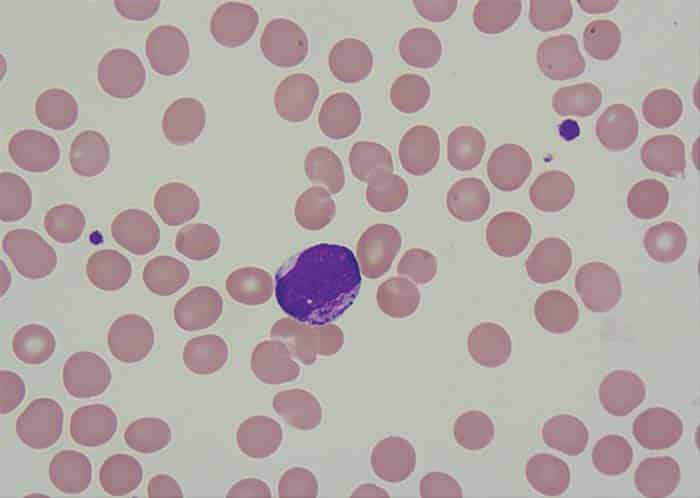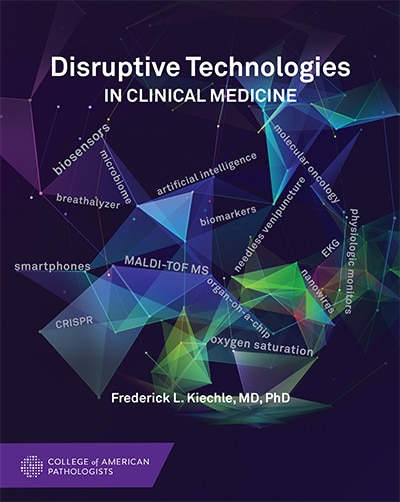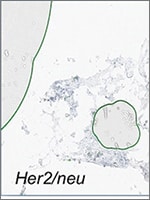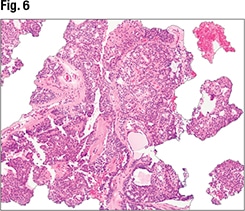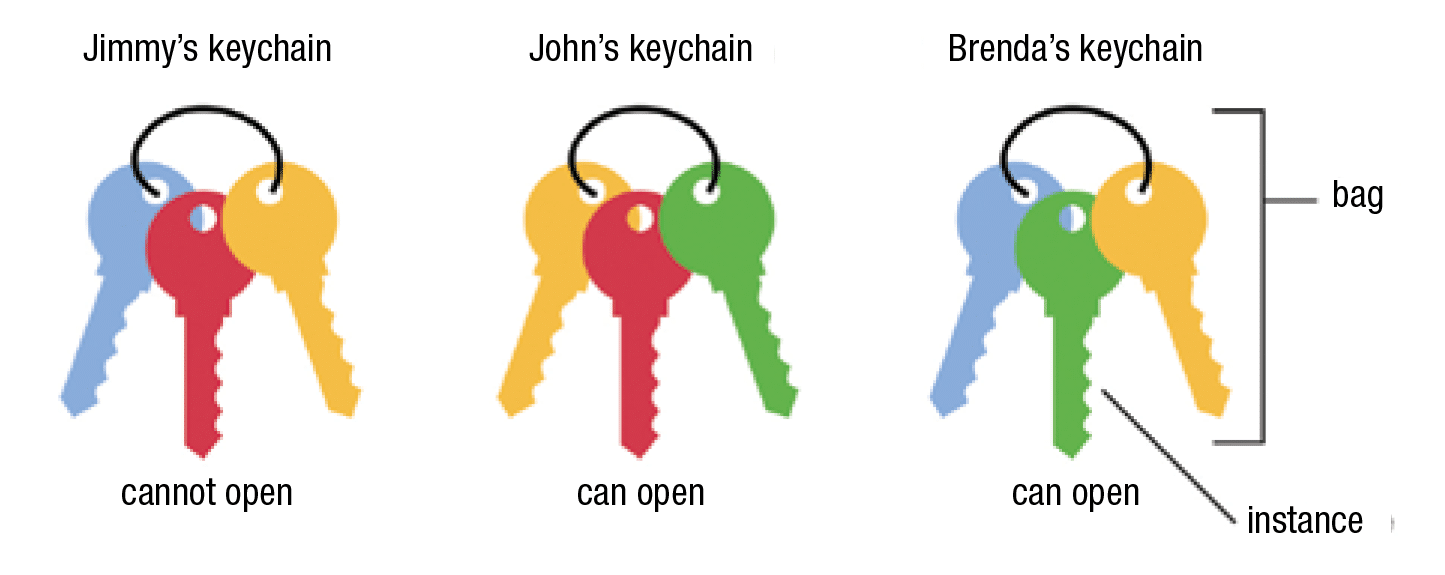April 2024—The rise in fungal infections in recent years troubles Sean Zhang, MD, PhD, for reasons near and far. It’s readily apparent in the patient populations at Johns Hopkins Hospital, where he is director of the mycology laboratory. Especially concerning is the increase in Candida auris following the height of the COVID-19 pandemic, both in terms of colonization and infection cases, says Dr. Zhang, who is also associate professor of pathology, Division of Medical Microbiology, Department of Pathology, Johns Hopkins University School of Medicine. “Since 2022, we suddenly saw an uptick in Candida auris cases across the Johns Hopkins Health System.” But the situation isn’t unique to Johns Hopkins. Pointing to CDC figures, he notes that the tide is rising more broadly as well. The agency reports that in 2020, there were 757 clinical cases and 1,310 screening cases of C. auris in the United States. In 2022, there were 2,377 clinical cases and 5,754 screening cases.
Read More »ALL ISSUES
Hybrid practice model beckons as solution
April 2024—With the technology now available, could and should remote diagnostic pathology, or at least a hybrid model, become more the norm in the future? Timothy Craig Allen, MD, JD, and Casey P. Schukow, DO, of Corewell Health in Michigan, in an editorial published recently, say the time for one or the other or both has come.
Read More »Need for speed in solid tumor molecular testing
April 2024—As the call for fast turnaround of genetic testing results in tumor profiling grows louder, the need for rapid, reliable test methods becomes more pressing. Meanwhile, with new genetic biomarkers emerging at a rapid pace, “everything has tipped the balance toward comprehensive next-generation sequencing analysis,” said Maria E. Arcila, MD.
Read More »Microscope to image—big lift but also a blueprint
April 2024—The Food and Drug Administration in February cleared Proscia’s Concentriq AP-Dx digital pathology software for the purpose of primary diagnosis.
Read More »Billing headwinds grow stronger for labs
April 2024—In billing for pathology and laboratory services, the hurdles are only getting higher. Narrow networks, prior authorizations, claims denials. Payers “have deeper pockets and figure they can outlast us,” said Joe Saad, MD, chair of the CAP Council on Government and Professional Affairs, in a Feb. 14 roundtable led online by CAP TODAY publisher Bob McGonnagle. He and others talked about AI, digital pathology codes and molecular Z-Codes, biomarker testing, and unity within the laboratory community.
Read More »How Duke’s molecular diagnostics lab retains and trains
April 2024—Too few people, too much to do. In that, Duke Health’s molecular diagnostics laboratory is no different from any other laboratory. But competing for staff on the basis of money alone is out. “The reality is that in today’s labor market, any molecular technologist can always find a job that pays more,” says Barbara Anderson, PhD, MB(ASCP)CM, analytical specialist in Duke’s molecular diagnostics laboratory, Division of Molecular Pathology, Genetics, and Genomics.
Read More »AMP case report: Use of molecular techniques to solve a challenging case of primary cutaneous marginal zone lymphoma
April 2024—Primary cutaneous marginal zone lymphoma (PCMZL) is a newly recognized, distinctive subtype of non-Hodgkin’s lymphoma. This low-grade lymphoma predominantly presents as papules or nodules within the skin of middle-aged adults. Formerly grouped under the extranodal marginal zone lymphoma (EMZL) category, the World Health Organization’s fifth edition classification of hematolymphoid tumors now recognizes PCMZL as a distinct entity.
Read More »A how-to guide to quality management in clinical labs
CAP Publications released this month its newest book, Quality Management in Clinical Laboratories: Optimizing Patient Care Through Continuous Quality Improvement. It is a second edition; the first was published in 2005. Twenty-one contributors cover everything from laboratory staff and informatics to all phases of testing and the laboratory quality management plan.
Read More »From the President’s Desk
April 2024—When Tip O’Neill, former speaker of the U.S. House of Representatives, said many years ago that all politics is local, he was talking about how elections, legislation, and all of politics affect people where they live. I believe the concept applies just as much to pathology advocacy. When it comes to the issues we care about for our profession and for our patients, our efforts in advocacy, lobbying, educating, and persuading all need to happen at the local level just as much as at the national level.
Read More »Clinical pathology selected abstracts
April 2024—Neonatal anemia is a common comorbidity of premature infants and may result from certain obstetric conditions or diseases, or, in the case of iatrogenic anemia, from multiple phlebotomies in the first days of life. Once infants enter the neonatal intensive care unit (NICU), they undergo a series of laboratory tests at baseline and then as needed for treatment or monitoring. These tests commonly include blood cultures, CBCs, coagulation profiles, metabolic screens, blood gases, blood glucose, and chemistry profiles. Phlebotomy-associated blood loss is more clinically relevant in lower birth-weight neonates since they have lower total circulating blood volumes. When blood is drawn from an indwelling umbilical catheter, even more blood is removed due to the need to flush residual intravenous fluid from the line.
Read More »Anatomic pathology selected abstracts
April 2024—Fumarate hydratase-deficient renal cell carcinoma is a rare and distinct subtype of renal cancer caused by FH gene mutations. FH negativity and s-2-succinocysteine (2SC) positivity on IHC can be used to screen for FH-deficient renal cell carcinoma (RCC), but their sensitivity and specificity are imperfect. The expression of AKR1B10, an aldo-keto reductase that catalyzes cofactor-dependent oxidation-reduction reactions, in RCC is unclear. The authors compared AKR1B10, 2SC, and FH as diagnostic biomarkers for FH-deficient RCC. They included genetically confirmed FH-deficient RCCs (n=58), genetically confirmed TFE3 translocation RCCs (TFE3-tRCC; n=83), clear cell RCCs (n=188), chromophobe RCCs (n=128), and papillary RCCs (pRCC; n=97).
Read More »Molecular pathology selected abstracts
April 2024—Personalized medicine is revolutionizing cancer therapy, with targeted treatments customized to a person’s cancer-specific mutational profile leading to substantially improved health outcomes. Personalized medicine can also be applied to cancer prevention for high-risk groups based on genetic predisposition or lifestyle factors. However, there is a significant gap in cancer research resulting from a lack of equitable representation of racial and ethnic groups in cancer databases. Most research data are derived from white patients in the United States and Europe, creating racial disparities in understanding cancer development and therapies. The underrepresentation of patients of African, Asian, and Native American descent in observational, translational, and clinical cancer studies is particularly notable.
Read More »Newsbytes
April 2024—Transitioning to digital pathology can seem complex and costly. And for some, but not all, laboratories, cost in particular can be a barrier to adoption. So how do you determine which camp your lab falls into? You calculate, according to Orly Ardon, PhD, director of digital pathology operations at Memorial Sloan Kettering Cancer Center.
Read More »Q&A column
April 2024 Q. Ordering clinicians are requesting that our laboratory flag abnormally high absolute neutrophil counts (ANC) on peritoneal fluids. We cannot find sources for reference ranges, but there is literature that states that a polymorphonuclear cell count greater than 250/μL is a reliable discriminatory test for bacterial peritonitis. We would like to use this as our reference and flag results with an ANC greater than 250 cells/μL as abnormally high. Is this acceptable? Read answer. Q. How do you code fallopian tubes submitted for sterilization with a finding of a paratubal cyst? Read answer.
Read More »Letters
April 2024—The article “Test adds twists to lung disease diagnosis” (November 2023, page 1) virtually ignores the major problem of clinicians in the hospital thinking that it is perfectly okay to take specimens from patients in the hospital and send them directly to whatever laboratory they choose without input from the hospital’s laboratory administration or medical director. The laboratory medical director is legally responsible for approving the menu of laboratory tests to be performed in-house and all of the reference laboratories to be used.
Read More »Put It on the Board
April 2024—Member organizations of the Enduring Consensus Cervical Cancer Screening and Management Guidelines effort released in March their recommendations for the use of p16/Ki-67 dual stain for managing individuals who test positive for HPV.
Read More »Game’s afoot in bladder cancer research
March 2024—Like identifying the shift in battle that leads to victory, or the battle that wins the war—let alone declaring a war’s ultimate victor—it’s hard to gauge the whens, ifs, and hows that mark progress in medicine. For those who are deeply rooted in bringing advances to testing in urothelial cancers, current research is flourishing and flummoxing. In early and late stage, both for bladder and upper tract disease, recently approved therapies are leading to better outcomes for patients. More immunotherapies and antibody-drug conjugates are on their way, and with them come new options for testing. But as with any cancer, researchers follow numerous promising paths, knowing that some will dead-end and others will succeed primarily (albeit usefully) in raising more questions. Nevertheless, they continue to rally the work forward, with multiple breaches, and Agincourt, ever in sight. For experts such as David McConkey, PhD, progress will best be measured by how regularly precision makes its way into the clinical setting.
Read More »From training to first jobs, can the transition be made easier?
March 2024—Pathology trainees and training programs vary, as do first jobs, but the first year in pathology practice is generally said to be a tough one, largely because of the transition to fully independent case sign-out.
Read More »In diabetes patients, biomarker use for early-stage HF
March 2024—For patients with type 2 diabetes, the cardiac biomarkers are a better predictor of early-stage heart failure than conventional risk prediction scores. “We need to use biomarkers,” says Petr Jarolim, MD, PhD.
Read More »Survey probes staff shortage in genomics labs
March 2024—From a technologist workforce perspective, clinical genomics laboratories are in trouble. “It’s truly a crisis,” said Marco Leung, PhD, clinical director of the Steve and Cindy Rasmussen Institute for Genomic Medicine at Nationwide Children’s Hospital in Columbus, Ohio.
Read More »AP and CP reporting, from interfaces to IT wishes
March 2024—Anatomic and clinical pathology reporting—what’s working, what’s missing. Three pathologists (all board certified in informatics) and representatives of three information system companies met online Dec. 19 with CAP TODAY publisher Bob McGonnagle to talk about reporting needs and what’s optimal. The first half of their discussion was published in the February issue, with CAP TODAY’s guide to anatomic pathology computer systems. The second half begins here.
Read More »What’s going on? Interpreting urine toxicology cases
March 2024—For urine toxicology screening, immunoassays are automated and rapid but have variable sensitivity and specificity and results are considered presumptive. Mass spectrometry, used for confirmation, has superior sensitivity and specificity but is labor-intensive and slow and requires significant expertise.
Read More »AMP case report: Acute myeloid leukemia with hyperdiploidy
March 2024—CAP TODAY and the Association for Molecular Pathology have teamed up to bring molecular case reports to CAP TODAY readers. AMP members write the reports using clinical cases from their own practices that show molecular testing’s important role in diagnosis, prognosis, and treatment. This month's report comes from Aga Khan University in Karachi, Pakistan. Case. An 87-year-old male with a clinical history of hypertension and sick sinus syndrome presented with a one-month history of fever, generalized weakness, and weight loss. There was no lymphadenopathy or hepatosplenomegaly on physical examination. Bone marrow examination was performed to evaluate for cytopenias.
Read More »In urinalysis, compromises, collections, and rules
March 2024—Reflex criteria, middleware, bladder cancer screening, point of care, controls, and collections came up in CAP TODAY’s Jan. 16 roundtable on urinalysis. Six people weighed in, with CAP TODAY publisher Bob McGonnagle leading. Their take on where things stand and where they can be better follows. CAP TODAY’s guide to urinalysis instrumentation begins here. Tim Skelton, in last year’s ...
Read More »From the President’s Desk
March 2024—During the 12 years I spent as director of a pathology residency program, one thing I worried about was how to better prepare our residents for their first roles as attending pathologists or laboratory directors. For many pathologists, the transition from always having someone looking over their shoulder to being on their own is very challenging.
Read More »Clinical pathology selected abstracts
March 2024—Despite research into colorectal cancer screening and clinical experience, screening uptake remains low. Colorectal cancer (CRC) screening involves noninvasive tests, such as a fecal immunochemical test (FIT) and stool-based DNA tests, as well as invasive tests, such as colonoscopy. The latter has the best performance characteristics for early cancer and adenoma detection. The average adherence to CRC screening is 60.6 percent for U.S. patients aged 50 to 75 years, which is well below the 80 percent goal for adherence set by the National Colorectal Cancer Roundtable and American Cancer Society. Offering stool-based tests to patients who refuse colonoscopy results in only a modest increase in adherence, to 67 percent.
Read More »Anatomic pathology selected abstracts
March 2024—Lung transplantation is the definitive therapy for end-stage pulmonary sarcoidosis. While several case reports have described recurrent sarcoidosis in allografts, the incidence and clinicopathologic characteristics remain unclear. The authors conducted a study in which they characterized the clinical and histopathologic features of recurrent sarcoidosis diagnosed in post-transplant lung surveillance transbronchial biopsies (TBBx). They identified 35 patients who underwent lung transplant for pulmonary sarcoidosis during the study period. Eighteen (51 percent) of the patients experienced recurrent sarcoidosis post-transplant—seven females and 11 males (mean age at recurrence, 51.6 years).
Read More »Molecular pathology selected abstracts
March 2024—Human epidermal growth factor receptor 2 is a critical biomarker in breast cancer, gastrointestinal malignancies, and other cancers. HER2 protein expression can be evaluated using IHC, and the DNA copy number of its encoding gene, ERBB2, can be evaluated using FISH. In most clinical settings, IHC evaluation is categorized as positive (3+), equivocal (2+), or negative (0 to 1+), with equivocal cases being reflexed to FISH. Patients with HER2-positive tumors, defined as either 3+ or 2+/FISH positive, have been eligible to receive HER2-targeted therapy for many years. More recently, the FDA approved the antibody-drug conjugate trastuzumab deruxtecan (T-DXd) to treat patients with HER2-low breast cancer, defined as tumors with IHC 1+ or 2+/FISH negative. This promising treatment has allowed many more patients to receive molecular-targeted therapy.
Read More »Q&A column
March 2024 Q. Is it a requirement that routine bacteriology cultures (for example, urine, sputum) be plated in a biological safety cabinet in your typical hospital biosafety level 2 laboratory? Is it safe to read these cultures on an open bench? Read answer. Q. What source should a laboratory use for reference intervals for analytes? Read answer.
Read More »Newsbytes
March 2024—While Dr. Seuss’ assertion that “the more that you read, the more things you will know” is generally accurate, it doesn’t address the fact that how information is presented affects comprehension, a truism that is not lost on Edward Klatt, MD, who knows whereof he speaks when it comes to sharing information on patient portals.
Read More »Put It on the Board
March 2024—The Food and Drug Administration approved in December the AvertD test, which assesses whether an individual may have an elevated risk of developing opioid use disorder. Its intended use is to inform the decision-making of patients and physicians about the use of oral opioids for acute pain relief.
Read More »Doing more, doing better in bladder cancer
February 2024—From her vantage at the University of Texas MD Anderson Cancer Center, Donna Hansel, MD, PhD, has a clear view of cancer’s latest frontiers. Progress and breakthroughs are the norm. But even she sounds impressed when she surveys the changes in her specialty, urothelial cancer. “We are now thinking what we never before thought was possible: We are thinking about cures and lifelong remission from disease,” says Dr. Hansel, division head and professor of pathology and laboratory medicine. It’s been a long time coming, says Dr. Hansel, who is also the Dr. Eva Lotzova and Peter Lotz memorial research chair. The disease historically has been caught in a sort of prepositional triangle—underfunded, overlooked, and underdiagnosed—with serious consequences. For years, she says, “We thought bladder cancer had only one treatment”—BCG, or Bacillus Calmette-Guérin, therapy. Because the field lacked a large volume of research to propel better diagnostics and treatments, “people died of this disease because it progressed.”
Read More »As AI use expands, ethics at the leading edge
February 2024—Artificial intelligence is sizzling, so much so that New Yorker magazine, evoking the dazzling and the potentially devouring nature of AI technology, tagged 2023 as “The Year A.I. Ate the Internet.”
Read More »Biomarker tests with discrepant results—why the differences?
February 2024—When multimodality testing reveals discordant biomarker results, which method is correct? Annette S. Kim, MD, PhD, and JinJuan Yao, MD, PhD, in a CAP23 session last fall used their cases to share strategies for resolving discrepancies—or, in some cases, what look like discrepancies.
Read More »With pipeline for pathologists, others lacking, eyes on AI
February 2024—Artificial intelligence and Medicare Advantage contracts were at the center of the Jan. 2 Compass Group virtual roundtable led by CAP TODAY publisher Bob McGonnagle. “If you want to get into the AI world, there are many lanes you can swim in,” said Michael Feldman, MD, PhD, of Indiana University School of Medicine.
Read More »How we can help pathologists in Ethiopia
February 2024—Ethiopia’s health care system is at a crossroads as it grapples with the dual burden of infectious diseases and a surge in noncommunicable ailments.
Read More »Group’s pathology aides fill gaps, lighten the workload
February 2024—Efficiency can be hard to measure. But Kenneth Batts, MD, of Hospital Pathology Associates in Minneapolis, which contracts with Allina Health to provide anatomic pathology coverage, is sure that a pathology aide program the group started long ago makes its pathologists far more efficient.
Read More »The race to keep pace with drug use changes
February 2024—Xylazine prevalence, lab-developed testing, and new technology are converging at Yale New Haven Health in a way that gives rise to questions, worry, and new hope for faster drug testing.
Read More »AP and CP reporting—the needs, the caveats
February 2024—Anatomic and clinical pathology reporting—what’s working, what’s missing. Three pathologists (all board certified in informatics) and representatives of three information system companies met online Dec. 19 with CAP TODAY publisher Bob McGonnagle to talk about reporting needs, the changes, what’s optimal. The first half of their discussion begins here; the second half will be published in the March issue.
Read More »From the President’s Desk
February 2024—Even before the pandemic, burnout had become a major issue in medicine. Today, the effects of too much stress, staff shortages, and increasing demands have become so widespread in health care that they cannot and should not be ignored.
Read More »Clinical pathology selected abstracts
February 2024—Patients receiving a pathology report may have many outstanding questions that can cause anxiety and confusion. The 21st Century Cures Act has increased patients’ access to pathology reports via delivery to patient portals. However, reports sent without further explanation can exacerbate the anxiety and confusion. Many health care institutions are creating new communication methods to help patients interpret these reports and develop a better understanding of their health status. One such approach is the pathology explanation clinic (PEC), which is an interactive visit between patients and pathologists to discuss the pathology report and review the patient’s slides.
Read More »Anatomic pathology selected abstracts
February 2024—The gold standard for prostate cancer diagnosis is the pathological examination of prostate biopsy tissue by light microscopy. The application of artificial intelligence (AI) to digitized whole slide images (WSIs) can aid pathologists in cancer diagnosis, but robust, diverse evidence in a simulated clinical setting is lacking. The authors conducted a study to compare the diagnostic accuracy of pathologists who read WSIs of prostatic biopsy specimens with and without AI assistance. Eighteen pathologists, two of whom were genitourinary subspecialists, evaluated 610 prostate needle core biopsy WSIs prepared at 218 institutions, with the option for deferral. Two evaluations were performed sequentially for each WSI: the first without assistance and the second, conducted immediately thereafter, aided by Paige Prostate (Paige, New York City).
Read More »Molecular pathology selected abstracts
February 2024—Precision cancer medicine relies heavily on understanding the genomic landscape of tumors. Prior comparisons between African and European ancestry, though based on limited data, have indicated distinct differences in the landscape of cancer driver alterations between these populations. Whether these discrepancies are mediated by genetic variants or environmental influences is still unclear. Accurately characterizing ancestry-associated genomic alterations is essential to not only improving genomic diagnostic testing but also to developing targeted therapies, biomarkers, and personalized cancer care for diverse populations. The authors conducted a study that leveraged two large genomic cohorts to investigate the relationship between genomic alterations and African ancestry in six common cancers: prostate, pancreas, ovary, nonsmall cell lung cancer (NSCLC), colorectal, and breast.
Read More »Q&A column
Feburary 2024 Q. In a case of suspected drug-related death, how specific can an autopsy be in identifying the drug(s) that might have caused the person’s death and the amount of drugs present? For example, can a toxicology report say a person’s death was caused by a fake oxycodone pill containing fentanyl? Read answer. Q. A nephrology patient who has been treated with vitamin D2 for several years contacted our laboratory to find out why their 25-hydroxyvitamin D level of 60 ng/mL is now considered elevated when before it was within the normal range. How can we explain this? Read answer.
Read More »Newsbytes
February 2024—The key to using ChatGPT and other large language models effectively in pathology is understanding not only what they are designed to do but, just as importantly, what they are not designed to do, says Eric Glassy, MD, medical director at Affiliated Pathologists Medical Group, Rancho Dominguez, Calif., and past chair of the CAP Information Technology Leadership Committee.
Read More »Put It on the Board
February 2024—Members of the CAP Machine Learning Working Group, Informatics Committee, Digital and Computational Pathology Committee, and Council on Informatics and Pathology Innovation have proposed 15 recommendations for evaluating the performance of machine learning-based clinical decision support systems in pathology.
Read More »More progress, fewer barriers for PGx testing
January 2024—Sometimes even superb ideas can also turn out to be quite, well, bothersome. Zoom meetings. Bridal showers. Bike lanes. Parking apps. QR menu codes. And—if laboratories aren’t careful—the same can be true of pharmacogenomic testing. Just ask Ann Moyer, MD, PhD, associate professor, laboratory medicine and pathology, Mayo Clinic. When it comes to pharmacogenomic testing, laboratory medicine brings significant expertise to the table. But in clinical settings, physicians who prescribe the medications need to be familiar with how to use the test results. They also need to work with the lab to decide which tests, for which genes or gene-drug pairs, will be most helpful for their patients, she says. “Especially if you’re going to start incorporating clinical support alerts into the EHR,” adds Dr. Moyer, who was chair of (until Dec. 31; she is now advisor to) the CAP/ACMG Biochemical and Molecular Genetics Committee. “If the practice doesn’t actually want them, then you’re just going to end up annoying them.”
Read More »The who, when, and why of thrombophilia testing
January 2024—Thrombophilia testing has been shown to be performed far more often than indicated in thromboembolic events, at significant cost to the patient and hospital.
Read More »Lab-developed test proposal reflections and predictions
January 2024—The Food and Drug Administration’s proposed rule on laboratory-developed tests would phase out its existing enforcement discretion approach for oversight of LDTs. Instead, the FDA would classify in vitro diagnostics offered as LDTs as class I, II, or III medical devices depending on their risk to patients.
Read More »A scan of studies on HER2-low breast cancer scoring
January 2024—Much has been said and written about scoring HER2-low breast cancer, and it has its difficulties. But there are steps and tools to support scoring, and Savitri Krishnamurthy, MD, last fall shined a light on them and several HER2-low breast cancer-related studies.
Read More »7 pointers for POC cardiac troponin measurement
January 2024—Seven recommendations for the use of cardiac troponin measurement at the point of care were published last year and reported in a session at the Association for Diagnostics and Laboratory Medicine annual meeting, shortly after the recommendations appeared in print.
Thoracic SMARCA4-deficient undifferentiated tumor
January 2024—Thoracic SMARCA4-deficient undifferentiated tumor (TSDUT), formerly known as SMARCA4-deficient thoracic sarcoma and SMARCA4-deficient thoracic sarcomatoid tumor, is a relatively newly defined entity with a distinct clinical history, morphology, immunohistochemical profile, molecular findings, and clinical behavior.
Read More »Bethesda System for Reporting Thyroid Cytopathology
January 2024—The Bethesda System for Reporting Thyroid Cytopathology (TBSRTC) is a widely endorsed and globally adapted standardized reporting system of thyroid fine-needle aspiration specimens.
Read More »Reporting urine cytology: how Paris 2.0 differs from 1.0
January 2024—Urinary cytology is widely used to screen for high-grade urothelial carcinoma (HGUC) and to monitor for recurrence. Several reporting systems have been proposed over the past few decades, but The Paris System (TPS) for Reporting Urinary Cytology is the most widely applied worldwide.
Read More »Panelists on viscoelastic and other coag assays
January 2024—Viscoelastic assays and other coagulation tests were front and center when CAP TODAY publisher Bob McGonnagle on Nov. 20 convened seven people in an online roundtable. Oksana Volod, MD, and Eric Salazar, MD, PhD, and five company representatives weighed in on, among other things, appropriate test use, automation, and laboratory-developed tests. What they said begins here.
Read More »From the President’s Desk
January 2024—I was planning to write about a much more pleasant topic this month, but instead I’ll use this column to address something that’s gnawing at all of us now: the prospect of FDA regulation of laboratory-developed tests.
Read More »Clinical pathology selected abstracts
January 2024—People respond differently to SARS-CoV-2 infection, with some having a very severe clinical course and sequelae while others recover quickly. Several research studies have used laboratory data to identify patient populations most at risk for severe outcome from COVID-19. However, many of these studies were conducted in China and did not represent the demographics of the U.S. population. Among the drawbacks of these studies were that most analyzed variance between two patient groups, yet statistical differences don’t always correlate with clinically useful predictions. Furthermore, these studies used data from throughout patients’ disease course, and clinicians would like to identify patients at risk during their initial interaction.
Read More »Anatomic pathology selected abstracts
January 2024—Diffuse parenchymal lung disease is a well-recognized complication of systemic connective tissue disease but rarely arises in patients with psoriasis or psoriatic arthritis, which are poorly understood. Therefore, the authors conducted a study to characterize diffuse parenchymal lung disease (DPLD) associated with psoriasis or psoriatic arthritis, with or without prior immunomodulation. Their pathology consultation files were searched for patients having psoriasis or psoriatic arthritis and DPLD. After excluding cases with active infection or smoking-related DPLD only, 44 patients (22 of whom were women; median age, 60 years; range, 23–81 years) were enrolled in the study. Clinical history and pathology slides were reviewed.
Read More »Molecular pathology selected abstracts
January 2024—DDX41 is involved in multiple cellular processes, including RNA metabolism and splicing. Inherited variants have been linked to an increased risk of the blood neoplasms myelodysplastic syndrome (MDS) and acute myeloid leukemia (AML).
Read More »Q&A column
January 2024 Q. Can a person who has a bachelor of science degree in health care administration sign off on competency assessments? Read answer. Q. Our laboratory uses a total protein assay from Beckman Coulter that has an analytical measurement range of 3–12 g/dL for serum determinations. The assay sensitivity states 1 g/dL of total protein. Can we loop sensitivity into our AMR and make our reporting range 1–12 g/dL? Will this make our assay a laboratory-developed test? Quite often our clinicians need assays reported to 1 g/dL, since they need to calculate the ratio of total protein serum to body fluid as per Light’s criteria. If we report to 1 g/dL, we have to loop sensitivity into our AMR. Read answer.
Read More »Newsbytes
January 2024—When the medical microbiology laboratory at Yale-New Haven Hospital makes operational changes, it uses data analytics to monitor their impact. Yet the process of implementing laboratory analytics can be challenging.
Read More »Put It on the Board
January 2024—The Association for Molecular Pathology on Dec. 14 published a joint report on what to consider for a slice testing strategy for diagnostics, including gene selection, analytic performance, coverage, quality, and interpretation. Slice testing is the practice of bioinformatically selecting a subset of genes from exome or genome sequencing assays.
Read More »And the band neutrophil counts play on
December 2023—The recent CAP proficiency testing questionnaire was meant to be the coup de grâce. Hematology PT participants were asked about their band neutrophil reporting practices and, given that these manually generated counts were supposedly on their way out decades ago, the authors of the survey questionnaire expected to see very little activity. The survey, they hoped, would be a way to pound the final, data-driven nail in the coffin. Or, as lead author Maria (Ria) Vergara-Lluri, MD, puts it, “We thought this had all been laid to rest 30 years ago.” It wasn’t. Says Dr. Vergara-Lluri: “Surprise: 86 percent of labs that participated still report bands.” The results of the survey upended many of the assumptions, if not hopes, the authors might have had. Among laboratories that reported manual differentials, they found that most reported bands (4,554 of 5,268). Moreover, only 73 percent reported band reference ranges. On the morphologic challenge, bands classified as “easy” were indeed easy—participants classified them well.
Read More »In fee schedule final rule, lower cuts than proposed
December 2023—In the 2024 Medicare physician fee schedule final rule, the Centers for Medicare and Medicaid Services reacted favorably to the CAP’s advocacy to mitigate payment decreases to pathologists next year. Overall, payments to pathologists are expected to decrease by an estimated 2.7 percent.
Read More »New guidance on lab analysis in diabetes
December 2023—The third and latest edition of recommendations for laboratory analysis in diagnosing and managing diabetes mellitus, released this summer, provide guidance on, among other things, ketone testing, glycolysis, and point-of-care testing. The last such recommendations were published in 2011.
Read More »In ED/urgent cares, the lab tests and the POC team
December 2023—A point-of-care testing team from TriCore was part of standing up three dual emergency department/urgent care centers in as many years, with a fourth set to open in March 2024. “They are super busy, as was expected. There’s a great need for this type of site,” says Kathleen David, MT(ASCP).
Study of suspected transfusion reactions to begin Jan. 1
A new CAP Quality Practices study on rates and turnaround times for investigating and reporting suspected transfusion reactions will begin on Jan. 1, 2024. Enrollment is open now and will continue through Feb. 5, 2024.
Read More »Digital pathology and AI—drivers, budgets, and jobs
December 2023—Digital pathology and AI—the push, the potential, the changing questions, the reimbursement, and the caution. All that and more came up when CAP TODAY publisher Bob McGonnagle on Oct. 17 led a conversation online with pathologists and industry representatives.
Read More »Savings follow allergy, autoimmune test consolidation
December 2023—Hoi-Ying Elsie Yu, PhD, D(ABCC), isn’t new to workflow optimization. As system director of chemistry, point-of-care testing, and preanalytics for Geisinger Medical Center in Danville, Pa., for the past decade, she has undertaken initiatives to maximize efficiency in complicated parts of the laboratory whenever she can.
Read More »Phlebotomy program gives lift to lab, community
December 2023—The clinical laboratory at Children’s Hospital of Philadelphia is solving two problems at once: its phlebotomist staffing shortage and the need for some in its community to learn a new skill and obtain employment.
Read More »LDT proposal on the radar—little detail, clarity needed
December 2023—For most, laboratory staffing woes continue, despite some letup post-pandemic. CAP TODAY publisher Bob McGonnagle on Nov. 7 got a sampling of where staffing stands as the year end approaches, in his conversation online with members of the Compass Group, an organization of not-for-profit IDN system lab leaders who collaborate to identify and share best practices and strategies. But first a few words from them about the Food and Drug Administration’s proposed rule on laboratory-developed tests.
Read More »AMP case report: Potential von Hippel-Lindau syndrome in a patient with negative germline testing
CAP TODAY and the Association for Molecular Pathology have teamed up to bring molecular case reports to CAP TODAY readers. AMP members write the reports using clinical cases from their own practices that show molecular testing’s important role in diagnosis, prognosis, and treatment. The following report comes from Washington University School of Medicine in St. Louis. If you would like to submit a case report, please send an email to the AMP at amp@amp.org. For more information about the AMP and all previously published case reports, visit www.amp.org.
Read More »From the President’s Desk
December 2023—About five years ago, when I was serving in my first term on the CAP Board of Governors, I attended a House of Delegates meeting where we had a candidate forum with several people on stage competing for just a few Board slots. Of the half-dozen or so people, only one or two were women and none was a minority. That’s when one delegate stood up and, with a single question, altered the course of our entire organization: “When will the CAP have candidates for higher office who look like the CAP membership?”
Read More »Anatomic pathology selected abstracts
December 2023—Cytomegalovirus hepatitis in allograft livers is a significant infectious complication for which the histology historically has been described as overlapping that of acute cellular rejection, a diagnosis that compels a different treatment regimen. The authors conducted a study to update the clinicopathologic features of cytomegalovirus (CMV) hepatitis and explore its clinical and histologic relationship with acute cellular rejection (ACR). They performed a retrospective analysis of 26 patients, across four institutions, who were diagnosed with CMV hepatitis, assessing clinical, histologic, and IHC features. Patients were predominantly CMV donor positive/recipient negative (D+/R-; n=9 of 15) and received a diagnosis of CMV hepatitis at a mean age of 52 years (standard deviation [SD], 17 years) and at a mean interval of 184 days (SD, 165 days) from transplantation. Mean CMV viral load at diagnosis was 241,000 IU/mL (SD, 516 000 IU/mL), and liver biochemical enzymes were elevated (mean alanine aminotransferase, 212 U/L [SD, 180 U/L]; mean aspartate aminotransferase, 188 U/L [SD, 151 U/L]; and mean alkaline phosphatase, 222 U/L [SD, 153 U/L]).
Read More »Clinical pathology selected abstracts
December 2023—Efforts to develop biomarkers that help predict risk factors for preeclampsia/eclampsia and to better understand the trends and implications related to new-onset hypertensive disorders in pregnancy have grown. New-onset hypertension arising during pregnancy (gestational hypertension and preeclampsia/eclampsia) is associated with coronary heart disease, heart failure, stroke, and other cardiovascular-related mortality. Hypertensive disorders of pregnancy have grown into major public health problems that contribute to maternal morbidity, mortality, and future risk of cardiovascular disease. The authors conducted a study to describe contemporary trends in new-onset hypertensive disorders of pregnancy in the United States. They conducted a serial cross-sectional analysis of 51,685,525 live births to women aged 15 to 44 years, from 2007 to 2019, using the Centers for Disease Control and Prevention’s natality database.
Read More »Molecular pathology selected abstracts
December 2023—Immune checkpoint blockade therapy has dramatically altered treatment options for a variety of cancers. A high tumor mutation burden (TMB) is considered one of the strongest predictors of immune checkpoint blockade response. DNA mismatch repair deficiency (MMRd) is associated with a high TMB, and many tumors associated with MMRd have shown excellent response to immunotherapy. However, most MMRd tumors do not show durable response to treatment with immune checkpoint blockade (ICB). Intratumor heterogeneity may further mediate response to ICB therapy.
Read More »Q&A column
December 2023 Q. When using a sodium citrate blue-top tube due to platelet clumping, should the sample be kept warm, and does it have to be run within a certain time frame? Read answer. Q. Does the CAP require instrument-to-instrument comparability studies at least twice a year for waived point-of-care testing instruments, such as glucose meters, or nonwaived instruments, such as critical care analyzers? Are we required to perform a linearity study twice a year on all waived and nonwaived POC testing instruments? Read answer.
Read More »Newsbytes
December 2023—While many dismiss the saying “Nothing lasts forever” with a simple shrug, those three words may cause angst in those anticipating the demise of their laboratory information system.
Read More »Put It on the Board
December 2023—The Food and Drug Administration granted approval for EntroGen’s CRCdx RAS Mutation Detection Kit as a companion diagnostic for Vectibix (panitumumab), used in the treatment of colorectal cancer.
Read More »In memoriam
John Kelly Duckworth, MD 1928–2023 December 2023—John Kelly Duckworth, MD, a member of the CAP Board of Governors from 1987 to 1993, died on Sept. 14 at age 95. Dr. Duckworth was the second chair of the CAP Commission on Laboratory Accreditation. He also was chair of the Council on Practice Management, vice chair of the Council on Scientific Affairs, ...
Read More »Test adds twists to lung disease diagnosis
November 2023—It was a mystery, wrapped less in an enigma than a few layers of bafflement, surprise, and mild irritation. Call it the Case of the Split Lung Specimens. The first hint something was amiss came when Alain Borczuk, MD, vice chair of anatomic pathology and co-director of thoracic pathology, Northwell Health, noticed that he and his colleagues were receiving more insufficient bronchoscopy specimens than usual. “When I say ‘increasing’—we don’t get that many bronchoscopies. It’s not like colon polyps,” says Dr. Borczuk, who is also director of oncologic pathology, Northwell Health Cancer Institute. Normally they would get a handful a week, some of them straightforward cancer cases, although these additional cases were tied to noncancerous conditions. And then the plot thickened even further, with missing pieces—literally. Though no guideline clearly states what constitutes an adequate specimen, Dr. Borczuk says, the samples he and his colleagues were seeing fell markedly short.
Read More »New guidance in checklist on AMR and mass spec
November 2023—In the 2023 edition of the CAP accreditation program checklists is new guidance on analytical measurement range verification and new and revised requirements for mass spectrometry.
Read More »Point-of-care testing scorecard spotlights hits and misses
November 2023—At the point of care, there are testing wins, some losses, and plenty of pitfalls. “Point-of-care coordinators all have the same problems,” says Meaghan Gladstone, applications consultant at Werfen.
In some settings, alternatives to HbA1c acceptable
November 2023—Glycated albumin and fructosamine are highly specific, with high levels suggesting hyperglycemia. This points to their utility in monitoring glycemic control in people with diabetes. “They’re quite useful in the setting of overt hyperglycemia,” said Elizabeth Selvin, PhD, MPH, at this year’s meeting of the Association for Diagnostics and Laboratory Medicine.
Read More »Generative AI, from education to corner cases
Generative artificial intelligence—what it is, how it can be used in pathology, what stands in its way, why the excitement. CAP TODAY publisher Bob McGonnagle spoke about that and more with pathologists Bobbi Pritt, MD, MSc, and Scott Anderson, MD; Ajit Singh, PhD, of Stanford and Artiman Ventures; and Devon Snedden, a health care consultant in artificial intelligence. “There are a lot of excellent possibilities that we’re just starting to understand and explore for the field of pathology,” said Dr. Pritt of Mayo Clinic.
Read More »AI-driven spatial biology: the next next-gen sequencing
November 2023—Spatial biology may be an emerging field, but Kenneth Bloom, MD, says he and other pathologists have been doing it “since we got the microscope.” And he argues it’s going to become “the new, most important lens we look through.” The reason is the emergence of new cancer treatments like immunotherapy and, most importantly, antibody drug conjugates like Enhertu, says Dr. Bloom, head of pathology for Nucleai, a company specializing in AI-powered spatial biology.
Read More »Minds shift on digital path, ‘massive change’ predicted
Is digital pathology on the move? Two who know it well say it is. Esther Abels, a precision medicine and biomedical regulatory health science expert who is CEO of SolarisRTC and former president of the Digital Pathology Association, and Michael Rivers, vice president/lifecycle leader of digital pathology at Roche Tissue Diagnostics, spoke in September with CAP TODAY publisher Bob McGonnagle, who got their take on where things stand.
Read More »Pathology navigators bring molecular test efficiencies
November 2023—Few things in the laboratory can do so much at once: boost histotechnologist productivity, safeguard tissue, offer a career path and help retain staff, keep watch on test utilization, and reduce the number of calls to pathologists and turnaround time, all while advocating for the patient.
Read More »Reports revisited—panel on preferences and pain points
November 2023—Reports—integrated or otherwise—were up for discussion when CAP TODAY publisher Bob McGonnagle convened online in October a group of informatics experts, who spoke of the need for simplicity in a time of growing complexity, ease of access, where Epic isn’t strong. The full conversation follows.
Read More »From the President’s Desk
November 2023—For 100 years, pathologists have been called “the doctor’s doctor.” We have traditionally done our work in the background, interacting mostly with other physicians and not visible to or known by patients.
Read More »Clinical pathology selected abstracts
November 2023—Among the many reasons unnecessary laboratory tests are ordered in a hospital are preselected orders on order sets, clinician habits, and trainee concerns. Laboratory tests are among the highest volume procedures performed in inpatient hospital care. Excessive use of these tests can lead to patient discomfort as a result of unnecessary phlebotomy and contribute to iatrogenic anemia and increased risk of bloodstream infections. It can also contribute to the rising cost of medical care. Many laboratory stewardship programs have been developed to improve how clinicians order and use lab tests.
Read More »Anatomic pathology selected abstracts
November 2023—Claudin-4 is a sensitive and specific marker for carcinoma in effusion cytology. The authors examined the diagnostic use of claudin-4 versus MOC-31 and Ber-EP4 by comparing their sensitivity, specificity, positive predictive value, and negative predictive value in differentiating carcinoma from mesothelioma and benign/mesothelial hyperplasia in effusion specimens. They conducted a retrospective study on a cohort of 229 cytology specimens, including 211 effusion fluid and 18 fine-needle aspiration specimens. The cytologic categories included 134 carcinoma, 28 mesothelioma, 46 indefinite (suspicious and atypical), and 21 benign.
Read More »Molecular pathology selected abstracts
November 2023—Dilated cardiomyopathy is characterized by dilation and weakening of one or both ventricles combined with impaired contractility. Although several external etiologies are associated with dilated cardiomyopathy (DCM), a familial form (comprising about half the known cases of DCM) has symptoms that tend to arise in mid-adulthood. Despite the genetic nature of the familial form, little is known about the genetic profile of the disease. Black patients have an increased familial risk of DCM and often have a worse prognosis. The authors conducted a study in which they used genomic ancestry to compare the rare variant genetic architecture of DCM within a diverse patient population.
Read More »Q&A column
November 2023 Q. A molecular laboratory received an order from an oncologist for next-generation sequencing testing. The patient’s tissue sample was in the custody of a different laboratory, which has a policy requiring patient consent to release materials for reference lab testing. The oncologist planned to obtain consent from the patient during a scheduled appointment, but the patient’s condition unexpectedly worsened and the patient could no longer travel for the appointment. Neither the custodial laboratory nor the treating health system have mechanisms for electronic consent. As a result of the lack of options for obtaining consent remotely and the custodial laboratory’s stringent consent policy, potentially life-altering NGS testing was delayed for more than a month. Is this restrictive approach to releasing patient material for reference laboratory testing supported by CAP guidelines? Read answer. Q. Is it acceptable to perform weak D testing on a newborn who has an RhD-negative blood type and a positive direct antiglobulin test? We know a positive DAT might cause false-positive results on an Rh test, but can it cause false-negative results? Read answer.
Read More »Newsbytes
November 2023—“The best way to have a good idea is to have a lot of ideas,” according to Linus Pauling, a chemist and chemical engineer who, among other accomplishments, helped create a form of synthetic plasma. But when there is no structure in place to nurture those ideas, the result can be “a lot of people focused in a lot of different directions,” says Sky Soom, innovation analyst with Sonora Quest Laboratories.
Read More »Put It on the Board
November 2023—Roche announced last month the U.S. launch of its Cobas Connection Modules (CCM) Vertical, the elevator and overhead components of its fully automated and modular CCM system to help low-, mid-, and high-volume laboratories optimize space, productivity, and patient care.
Read More »Digital path’s star rises from the mists
October 2023—In living up to its promise as a new technology that will revolutionize clinical care through greater ease, speed, and accuracy of diagnosis, digital pathology has been sluggish. While many analysts, starting at least two decades ago, forecasted that digital pathology would elbow aside glass slides for good, that milestone is still far out of reach. As health economist and chief executive officer of the New York City-based digital pathology company Paige, Andy Moye, PhD, puts it bluntly: “In probably 90 to 95 percent of the cases in the U.S., a pathologist still makes the diagnosis of cancer the way they did it back in 1910: by looking at a glass slide under a microscope.” Mark Lloyd, PhD, vice president of pathology for Fujifilm, says he wouldn’t be surprised to hear that perhaps only five percent to 10 percent of hospitals have moved beyond using only glass slides to offer pathologists digital pathology capability. In fact, Dr. Lloyd thinks those percentages are overstated. What is the market share for the clinical use of digital pathology?
Read More »Looking ahead to respiratory virus season
October 2023—With respiratory virus season near, those with a close eye on it in August gave the lay of the land for test algorithms, technologies, and forecasts, even as SARS-CoV-2 and RSV cases were rising in parts of the country.
Read More »Soon to be required: current susceptibility testing breakpoints
October 2023—A CAP accreditation program requirement that microbiology laboratories use current antimicrobial susceptibility testing breakpoints, which was added to the checklist in 2021, will go into effect Jan. 1, 2024.
Read More »Inside lab’s experience with assays for Alzheimer’s
October 2023—Orders for cerebrospinal fluid testing for Alzheimer’s disease have grown at Mayo Clinic since spring 2020, when testing was first offered. When aducanumab was approved in May 2021, test orders jumped.
Read More »Fast or comprehensive? Lab offers both for NSCLC
October 2023—For molecular testing in oncology, the choice is often fast or slow. PCR-based platforms are rapid, and comprehensive genomic profiling by next-generation sequencing is slower, and each has its pros and cons.
Read More »New guide to whole blood viscoelastic assays: hemostasis, testing, cases, and applications
October 2023—New this month from CAP Publications is Whole Blood Viscoelastic Assays in Clinical Diagnosis: An Illustrated Case-Based Guide. Viscoelastic testing was designed to determine the cause of intraoperative or trauma-related bleeding to guide hemostatic therapy. CAP TODAY asked the book’s editor, Oksana Volod, MD, about the guide. See her answers and a sample chapter. Dr. Volod is professor of pathology and director of the coagulation consultative service, Cedars-Sinai Medical Center, Los Angeles.
Read More »AMP case report: Identification of multiple germline cancer predisposing gene variants in a single patient during tumor sequencing analysis
October 2023—Next-generation sequencing of tumor tissue has important implications in solid and hematologic malignancies because it can identify genomic variants that provide diagnostic, prognostic, and predictive information to guide clinical management. Variants identified on tumor sequencing can be classified as somatic (acquired after conception) or inherited through germline.
Read More »In hematology, making the most of automated solutions
October 2023—Hematology analyzers and the related workflow, expertise, efficiency, and IT matters were the topic of a roundtable when CAP TODAY publisher Bob McGonnagle met online Aug. 29 with two pathologists and representatives from Horiba, Siemens, Sysmex, CellaVision, Sight, and Abbott. Their conversation follows.
Fernando Chaves, what are the advances in artificial intelligence in the field of hematology, particularly automated hematology, since we spoke during our roundtable at this time last year?
Fernando Chaves, MD, global head of hematology, Siemens Healthineers: Technology now enables full-field digital morphology, a full image of the entire slide scan. Now we can do with hematology what has been done for over a decade in surgical pathology.
From the President’s Desk
October 2023—In my long career, I’ve met a lot of pathologists. The military pathologist. The private practice pathologist who drives 75 miles each way to serve patients at a small rural hospital. The academic pathologist frantically writing a research grant proposal after a full day of clinical service. The lab director struggling to keep up with a rapidly growing specimen volume.
Read More »Clinical pathology selected abstracts
October 2023—Several large randomized controlled trials have shown the safety of tolerating hemoglobin levels as low as 7 g/dL in critically ill hemodynamically stable children. These trials have led to recent guidelines advocating for restrictive transfusion therapy, which is significantly changing practices in pediatric critical care.
Read More »Anatomic pathology selected abstracts
October 2023—Special AT-rich sequence-binding protein 2, or SATB2, induces local chromatin loops to facilitate transcription. SATB2 immunostaining is commonly used as a marker for colorectal adenocarcinoma and osteosarcoma. The authors conducted a study to better understand the prevalence and diagnostic value of SATB2 expression in cancer by analyzing a comprehensive set of human tumors. SATB2 expression was analyzed in 15,012 tissue samples from 120 tumor types and subtypes and 608 samples from 76 nonneoplastic tissue types using IHC in a tissue microarray format. SATB2 positivity was found in 89 of the 120 (74 percent) tumor types—59 of the 120 (49 percent) had at least one moderately positive tumor and 38 of the 120 (32 percent) had at least one strongly positive tumor.
Read More »Molecular pathology selected abstracts
October 2023—Ovarian cancer is the eighth most common cancer in women. There are several histological types of ovarian neoplasms, and all rank among the deadliest gynecological cancers. However, those with homologous recombination deficiency (HRD) may benefit from a recently discovered category of drugs, called poly ADP-ribose polymerase inhibitors (PARPi). The homologous recombination repair pathway, which is responsible for repairing double-strand DNA damage, involves several genes, including BRCA1, BRCA2, and ATM. People with germline or somatic deleterious alterations of these genes are at higher risk of certain malignancies, such as ovarian, breast, prostate, and pancreatic cancers.
Read More »Q&A column
October 2023 Q. What is the total allowable error for lupus anticoagulant testing? Read answer. Q. Our laboratory may relocate to a building five blocks from our current hospital. What kind of instrument validation or verification studies do we need to perform following a move? When should we update the address on our CLIA license and for CAP accreditation? Are we required to have a new CAP inspection before or after testing patient samples at the new location? Read answer.
Read More »Newsbytes
Ocotber 2023—Health care technology companies, by and large, are eager to share product metrics—that is, standalone product performance—with potential pathology lab clients but less eager to share how those technologies may impact laboratory workflow and decision-making.
Read More »Put It on the Board
October 2023—The Food and Drug Administration has granted clearance to Streck’s MDx-Chex for BC-GP and MDx-Chex for BC-GN for use in diagnostic procedures. They are quality controls designed to verify the performance of the Luminex Verigene Blood Culture Gram-Positive (BC-GP) and Gram-Negative (BC-GN) tests for bloodstream infection and sepsis.
Read More »In memoriam
October 2023—Thomas Dermott Trainer, MD, a member of the CAP Board of Governors from 1994 to 2000 and secretary-treasurer from 1999 to 2000, died on June 10 at age 94.
Read More »Tests for paraneoplastic syndromes in neurology
September 2023—Laboratory testing for paraneoplastic neurologic syndromes is neither commonplace nor cheap. It also comes with its own enigmatical math, as Michael Levy, MD, PhD, recently experienced. As the director of the Neuroimmunology Clinic and Research Laboratory in Massachusetts General Hospital’s Department of Neurology, Dr. Levy keeps an eye on PNS laboratory testing (which is performed at Mayo Clinic) at his institution.
Many knots to untangle in lab test names
September 2023—Ambiguities, inconsistencies, omissions, and other defects in the naming of laboratory tests can send test orders and results interpretation awry, particularly with some of the most common tests. Even among clinicians and laboratorians working at the same hospital for years, smooth sailing is not guaranteed. The authors of a study published in Archives of Pathology & Laboratory Medicine hope to change that. Their aim is to alert patient-facing providers and laboratories to the risks that ambiguous or nonstandardized laboratory test naming poses and to provide practical rules for minimizing those risks.
For infectious disease, what tests and at what time in disease course
September 2023—For the tickborne and mosquito-borne arboviruses, which are frequently more transient in blood and tissue than other pathogens, both molecular and serologic testing have a place in the diagnostic toolkit.
Read More »Lab’s steps to fewer contaminated urine cultures
September 2023—A casual comment made in a routine exchange in an Avera McKennan Hospital laboratory sparked a five-year campaign to bring down the urine culture contamination rate. “I feel like all I do is report contaminated cultures,” a microbiology technologist said in 2016.
Read More »New viscoelastic testing requirement in checklist
September 2023—A proficiency testing accreditation requirement in the new checklist edition was revised to add clarification, and a new requirement on viscoelastic testing will close an existing gap.
Read More »People, partners, and platforms at the point of care
September 2023—Point-of-care testing—the requests and the committees that oversee them, the connectivity, what AI might bring. CAP TODAY publisher Bob McGonnagle on July 21 met online with a laboratory operations director and a medical director from large health systems and with company representatives for a look at where things stand today. Their conversation follows.
Disruptive technologies—what impact on lab workflow?
September 2023—New from CAP Publications is Disruptive Technologies in Clinical Medicine, by Frederick Kiechle, MD, PhD. In his new book Dr. Kiechle says “disruptive technologies offer new paradigms in diagnostic medicine.” Technology-driven disruptions are stimulated by the need to improve patient care, he writes, and they have been “a feature of the practice of clinical pathology since the inception of the first clinical laboratory in 1895 at the University of Pennsylvania, the William Pepper Laboratory.”
Read More »AMP case report: Lung micropapillary adenocarcinomas revisited
September 2023—CAP TODAY and the Association for Molecular Pathology have teamed up to bring molecular case reports to CAP TODAY readers. AMP members write the reports using clinical cases from their own practices that show molecular testing’s important role in diagnosis, prognosis, and treatment. The following report comes from Henry Ford Hospital. If you would like to submit a case report, please send an email to the AMP at amp@amp.org. For more information about the AMP and all previously published case reports, visit www.amp.org.
Read More »Genetic counseling within the laboratory: For oncology cases, lab’s consult service plugs gap
September 2023—What happens when an oncologist cannot confidently determine what type of genetic test to order for their patient? Where can a provider turn if they do not know whether a genetic variant is clinically actionable? As genetic testing becomes a more integral part of personalized medicine and health care in general, there is a growing need to bridge the gap between those skilled in molecular diagnostics and those on the patient-facing side of care. In response to this need, the Center for Integrated Diagnostics (CID), a high-complexity molecular diagnostics laboratory at Massachusetts General Hospital, created its Consultation Service.
Read More »From the President’s Desk
September 2023—In the past two years, I’ve written a lot in this column about leadership and why pathologists make natural health care leaders. Effective leaders emerge from a process of continual self-correction in those who constantly seek out new ideas and hone their leadership skills.
Read More »Clinical pathology selected abstracts
September 2023—Approximately 30 percent of U.S. employees report that they have been bullied in the workplace, and these numbers are even higher for remote workers. Bullying is defined as any act or situation in which someone is subjected to recurrent, systematic, serious negative or hostile behavior and long-lasting acts designed to oppress or abuse another person. This behavior may include belittling, humiliating, personally attacking, verbally criticizing, or intentionally excluding a coworker. Bullying can harm both the target of the attack and the organization that employs the bully and the targeted person. The potential negative effects on an organization can be high staff turnover, a decrease in employee performance and productivity, and an increase in errors and medical mistakes.
Read More »Anatomic pathology selected abstracts
September 2023—Understanding of the pathologic and molecular features of endometrial cancer has advanced measurably since the FIGO (International Federation of Gynecology and Obstetrics) staging system was updated in 2009. New treatments, results of clinical trials, and prognostic survival data that correlate with pathologic and surgical findings have been reported. Therefore, the FIGO Committee on Women’s Cancer determined that changes to the FIGO system were necessary. The goals of the revised staging system are to further clarify the diverse biologic nature of endometrial carcinomas with differing prognostic outcomes, better define the prognostic groups, and create substages that yield more appropriate surgical, radiation, and systemic therapies. The cancer committee developed a subcommittee on endometrial cancer staging in October 2021, of which the authors are members.
Read More »Molecular pathology selected abstracts
September 2023—Neurodegenerative diseases are a broad group of disorders characterized by progressive loss of nerve cells in the central or peripheral nervous system. These diseases are often chronic and incurable, with symptoms ranging from cognitive decline to motor or sensory dysfunction. There are many types of neurodegenerative diseases, with various underlying etiologies. One group of diseases, the synucleinopathies, are associated with the misfolding and aggregation of the protein α-synuclein. This group includes disease entities such as Parkinson disease, dementia with Lewy bodies, and multiple-system atrophy.
Read More »Q&A column
September 2023 Q. Some recent clinical guidelines recommend lower therapeutic and toxic limits for digoxin than those provided in assay package inserts. What therapeutic ranges and toxic thresholds should laboratories use? Read answer. Q. One of our providers noticed that two laboratories—one in New York and one in Florida—reported very different thyroid-stimulating hormone values for a patient and called our laboratory to determine which was correct. How should we handle such situations? Read answer.
Read More »Newsbytes
September 2023—The musician Frank Zappa said, “One size does not fit all,” a declaration that counters the claims of many clothing manufacturers and holds true for a variety of products, including, one could argue, digital scanners.
Read More »Put It on the Board
September 2023—A wrist-worn high-sensitivity cardiac troponin I monitor was one of the wearable devices and health monitors highlighted in a session on emerging technologies for point-of-care testing at the Association for Diagnostics and Laboratory Medicine meeting in July.
Read More »Letters
September 2023—I read with interest “In anatomic pathology labs, a balancing act” (August 2023). Some of the roundtable participants highlighted an area of next-generation-sequencing–based diagnostics that is a blind spot for pathologists, molecular biology tool manufacturers, and laboratory information system vendors—namely how to reduce the fractional cost of performing NGS-based analysis. On the topic of gene panels, the participants offered that the workflows are complex, reimbursement is relatively low, and startup costs are high—all true statements. However, I was struck that they evaluated the cost structure only in the setting of tissue oncology, with the implication being that the fully loaded cost of the diagnostic must be borne by the degree and level of oncology-based sequencing.
Read More »Low level limbo in HER2 breast cancer
August 2023—Seemingly channeling the inspiration of Magritte and his famous pipe, pathologists are painting a new picture of what has long been an everyday object in their own world: HER2. To paraphrase the master: Ceci n’est pas facile. For years, HER2 testing in breast cancer has seemed self-evident, ever since the HER2-targeted therapy trastuzumab and its companion diagnostic arrived on the scene a quarter of a century ago. Pathologists became comfortable using immunohistochemistry to identify 3+ cases and turning to in situ hybridization techniques to sort through less obvious ones. But early last summer, a variant of the drug, trastuzumab-deruxtecan (T-DXd), shook up that routine. When researchers presented results from the Destiny-Breast04 study at the 2022 ASCO annual meeting, showing that T-DXd significantly improves survival in so-called HER2-low metastatic breast cancer, attendees responded with a minutes-long standing ovation. They then returned from the meeting like evangelicals from the revival tent.
Read More »For patients, demystifying pathology reports
August 2023—With patient access to pathology reports now common via online portals, the question some have asked is what can be done to make them easier for patients to understand.
Read More »Few but notable— new accreditation checklist changes
August 2023—Climate control, calculation verification, block retention, and histocompatibility section director (technical supervisor) qualifications are among the areas in which laboratories can expect to see revisions in the new edition of the CAP laboratory accreditation checklists, to be released this month.
Read More »Upon viral infection, assessing the host nasal epigenome
August 2023—Analyzing the nasal epigenome can shed light on viral infections, strain differences, and potentially infection severity, and for influenza B in particular the results are striking.
Read More »In anatomic pathology labs, a balancing act
August 2023—Anatomic pathology laboratories—the pressures, the promise of technology to alleviate them, and the seemingly unprecedented rates of change. CAP TODAY publisher Bob McGonnagle gathered pathologists and company representatives online on June 21 to talk about it all. From pathologist coverage to IT, from tumor boards to questions job candidates in pathology should ask, here’s what they told us.
Read More »New cassette printer a standout? Users think so
August 2023—No jams, downtime, or lost time. Plenty of savings, speed, and employee satisfaction. Users of what General Data calls its next-generation cassette printer for histology laboratories say they’ve seen all that and more.
Read More »AMP case report: Small intragenic structural variants in SATB2-associated syndrome
CAP TODAY and the Association for Molecular Pathology have teamed up to bring molecular case reports to CAP TODAY readers. AMP members write the reports using clinical cases from their own practices that show molecular testing’s important role in diagnosis, prognosis, and treatment. The following report comes from Washington University School of Medicine in St. Louis.
Read More »Cytopathology in focus: How to approach cytology of unknown primary
August 2023—We discuss in this article a common problem that all cytopathologists come across frequently in their practice: tumors of unknown primary origin involving body fluids and other sites. Metastatic tumor cells can disseminate and colonize discontinuous secondary body sites.1 Such tumor metastases may be the patient’s initial presenting complaint to a family physician for deep-seated tumor primaries such as ovaries, pancreas, liver, and certain non-obstructive gastrointestinal tumors.
Read More »Cytopathology in focus: Impact of primary HPV testing on cytology lab statistical analysis
August 2023—Cytology gynecologic statistical laboratory data must be analyzed in the context of changing screening modalities and patient populations. This is especially important with the increasing use of primary high-risk HPV screening because diagnostic metrics will be markedly different in that patient population.
Read More »Cytopathology in Focus: Lung cytopathology reporting: WHO system and cases
August 2023—Accurate and timely diagnosis is the cornerstone of effective patient care, particularly in the field of pulmonary pathology. To address the challenges health care professionals face in diagnosing and reporting respiratory conditions, the International Academy of Cytology, together with the International Agency for Research on Cancer, recently developed the World Health Organization Reporting System for Lung Cytopathology
Read More »In memoriam
August 2023—Peachy Ridgway Gilmer Jr., MD, a member of the CAP Board of Governors from 1985 to 1991, died on June 18 at age 90. Dr. Gilmer was vice chair of the CAP Council on Education and Membership Services and a member of several CAP groups: the Commission on Laboratory Accreditation, the Council on Quality Assurance, and the Election Oversight, Planning and Priorities, and Surveys committees.
Read More »From the President’s Desk
August 2023—The benefit of the doubt: a risk worth taking in health care? Many of us work in practices, hospitals, or departments that are short-staffed. In the aftermath of the pandemic, it is harder now than ever to find qualified people, from pathologists to clinical laboratory scientists to phlebotomists. Those of us who still work in laboratories are feeling the stress of carrying an extraordinary load.
Read More »Clinical pathology selected abstracts
August 2023—Burnout has been reported to affect as many as 44 percent of physicians. It is listed in the International Classification of Diseases 11th Revision (ICD-11) and has been attributed to chronic workplace stress, emotional exhaustion, depersonalization, and a low sense of personal accomplishment. A social psychologist created the Maslach Burnout Inventory (MBI) tool to measure degrees of burnout. The 2018 Canadian Medical Association Physician Health Survey of 3,000 members found an overall burnout rate of 30 percent, and 28 percent of pathologists who responded to that survey indicated they were burned out. Physician burnout can have a significant negative impact on patient care, including on the amount of medical errors. It has been estimated that physician burnout costs the Canadian health care system CAD $185 million due to early retirement and CAD $27.9 million due to reduced professional work effort.
Read More »Anatomic pathology selected abstracts
August 2023—Gastric foveolar-type adenoma is a rare benign neoplasm that occurs sporadically or presents in patients with familial adenomatous polyposis. The molecular features of foveolar-type adenoma (FA) and the relationship between sporadic and syndromic lesions remain unclear. The authors conducted a study in which they performed clinicopathological, immunohistochemical, and genetic analyses of 18 sporadic and 30 familial adenomatous polyposis (FAP)-associated FAs. The majority of sporadic and FAP-associated FAs were located in the upper or middle third of the stomach on a background of fundic gland mucosa. Most lesions were low grade, but three had a high-grade component.
Read More »Molecular pathology selected abstracts
Augstus 2023—Atypical hemolytic uremic syndrome is a rare, potentially life-threatening thrombotic microangiopathy. The disorder causes tiny blood clots to form in blood vessels and results in organ damage. Clinical findings in atypical hemolytic uremic syndrome (aHUS) include hemolytic anemia, low platelet count, and acute kidney failure. In many cases, HUS is caused by Shiga toxin-producing E. coli, other infections, or certain medications, or it can result from other health conditions. The label “atypical” is used to delineate hemolytic uremic syndrome that is not due to any of these common causes.
Read More »Q&A column
August 2023 Q. Is there a CAP guideline that recommends that patients stop taking drugs that may interfere with a blood or urine test before providing a specimen? Read answer. Q. Can laboratory managers and supervisors assess the competency of testing personnel if they do not perform the lab tests themselves? Read answer.
Read More »Newsbytes
August 2023—How often do pathology departments underbill insurance companies for their services? And how much money do they lose because of underbilling mistakes? A prototype dashboard at Dartmouth Hitchcock Medical Center aims to answer those questions by using natural-language processing and machine-learning algorithms to flag pathology cases that are underbilled.
Read More »Put It on the Board
August 2023—The Association for Diagnostics and Laboratory Medicine (formerly AACC) and the American Diabetes Association last month issued guidelines and recommendations for laboratory analysis in the diagnosis and management of diabetes mellitus (Sacks DB, et al. Clin Chem. 2023;69[8]:808–868).
Read More »Turning questions to answers in drug testing
July 2023—As she surveys the opioid epidemic in North America, Christine Snozek, PhD, D(ABCC), could be tempted to think that a ripped-from-the-headlines reality has landed in clinical laboratories as well as on TV crime dramas. With the number of opioid-related deaths increasing in recent years, particularly since the start of the pandemic, drug testing demands have increased for labs as well, says Dr. Snozek, codirector of clinical chemistry and support services and director of point of care and central processing at Mayo Clinic in Arizona. If only she could turn to the entertainment industry for a technology-based solution. “I wish we had CSI lab capabilities,” she says, referring to the long-running police procedural. “You could run a sample and find all the drugs known to man on one test. If they could go ahead and release that technology, that would be wonderful,” jokes Dr. Snozek. Given that laboratories are unlikely to take a meeting with network executives, Dr. Snozek and others in the field will have to look elsewhere.
Read More »For SARS-CoV-2, clearing the air on EUA tests
July 2023—As the COVID-19 federal public health emergency drew to a close in mid-May, industry experts explained what will and won’t change for the laboratory and weighed the fallout from the drop-off in SARS-CoV-2 testing.
The human gut microbiome and blood biochemistry connection
July 2023—The human microbiome has been called the forgotten organ, and at one time it was. But not in the past 10 years. James Versalovic, MD, PhD, made that clear in his talk at the Association for Molecular Pathology meeting last year.
Read More »For sepsis Dx, MDW biomarker brought into the mix
July 2023—When Butler Health System in early 2020 installed the Beckman Coulter DxA 5000 automation line, its hospitals were among the first in the country to do so. At the same time, Butler went live with the DxH 900 hematology analyzer.
Read More »Cytomegalovirus in IBD: where to biopsy, whom to treat
July 2023—Though it’s been suggested that newer drugs have made cytomegalovirus less relevant in patients with inflammatory bowel disease, CMV remains an important opportunistic infection in patients with IBD. Knowing where to biopsy and how many are needed is one of the histologic challenges, said Joseph Misdraji, MD, associate professor of pathology, Yale School of Medicine, in a CAP22 session.
Read More »First a probe purchase, then an academic consortium
July 2023—Bringing new technology into laboratories is important for pathology as a field and for patients—and only getting more difficult. “Each new wave of technology is more complicated than the last,” Jeremy Segal, MD, PhD, said at the USCAP meeting this spring.
Read More »Lab leaders on moving markets and tipping points
July 2023—Digital pathology, the pathology workforce, and the clinical demand for subspecialty expertise were some of what Compass Group lab leaders took on in their June 6 conversation, with CAP TODAY publisher Bob McGonnagle leading the way.
AMP case report: A germline GATA2 c.121C>G (p.P41A) variant in a patient with an unusual acute promyelocytic leukemia
July 2023—A germline GATA2 c.121C>G (p.P41A) variant in a patient with an unusual acute promyelocytic leukemia CAP TODAY and the Association for Molecular Pathology have teamed up to bring molecular case reports to CAP TODAY readers. AMP members write the reports using clinical cases from their own practices that show molecular testing’s important role in diagnosis, prognosis, and treatment. The following report comes from Emory University School of Medicine. If you would like to submit a case report, please send an email to the AMP at amp@amp.org. For more information about the AMP and all previously published case reports, visit www.amp.org.
Read More »From the President’s Desk
July 2023—About a year ago, I used this column to talk about the CAP’s efforts to prioritize innovation and to create more pathways for staff and members to help keep us on the cutting edge. I know “innovation” can seem like a meaningless buzzword that organizations throw around without putting anything substantial behind it, so I wanted to come back to the topic and show that we really are taking it seriously at the CAP.
Read More »Clinical pathology selected abstracts
July 2023—Hemolytic disease of the fetus and newborn is caused by maternal immunoglobulin G crossing the placenta and binding to fetal RBC antigens. In severe cases, it results in fetal or neonatal anemia, edema, hepatosplenomegaly, and death. In China, antibodies to the ABO blood group system are the most common cause of hemolytic disease of the fetus and newborn (HDFN) and account for 85.3 percent of cases. This is followed by antibodies to the Rh blood group system, which account for 14.6 percent of HDFN cases. Other blood group systems, including Duffy, Kidd, and MNS, may also cause HDFN.
Read More »Anatomic pathology selected abstracts
July 2023—High-grade appendiceal mucinous neoplasm is a relatively recent term that describes a rare epithelial neoplasm of the appendix that demonstrates pushing-type invasion but high-grade cytologic atypia. Because it has been understudied, the authors conducted a multi-institutional retrospective study to describe the clinicopathologic features of high-grade appendiceal mucinous neoplasm (HAMN). They reviewed the clinical and histologic features of 35 HAMNs and the molecular features of eight of the cases. Patients were an average of 57 years old and most commonly presented with abdominal or pelvic pain. Histologically, 57 percent of the tumors showed widespread high-grade features.
Read More »Molecular pathology selected abstracts
July 2023—Non-muscle-invasive bladder cancer accounts for the majority of bladder tumors and is typically treated with transurethral resection of the bladder tumor followed by adjuvant intravesical Bacillus Calmette-Guérin instillations. However, the long-term effectiveness of Bacillus Calmette-Guérin (BCG) is limited, and patients with recurrent or progressive disease have lower survival rates. Understanding the genetic makeup of tumors and identifying molecular subtypes associated with BCG response could provide valuable insights that aid in developing personalized treatments. The authors conducted a study in which they performed whole-transcriptome sequencing of non-muscle-invasive bladder cancers (NMIBCs) from 132 patients who had never received BCG treatment and 44 patients whose cancer recurred after BCG treatment. Based on these patients’ results, the authors identified three unique molecular subtypes among the tumors—BRS1, 2, and 3. Patients with BRS3 showed increased epithelial-to-mesenchymal transition pathway activity and their tumors were enriched for mutations associated with the extracellular matrix when compared with the other two subtypes.
Read More »Q&A column
July 2023 Q. Should phosphate analysis be added to the comprehensive metabolic panel, especially given the test’s usefulness in distinguishing various bone disorders?Read answer. Q. Is it important to fast before a lipid panel? Read answer.
Read More »Newsbytes
July 2023—The Permanente Medical Group, Oakland, Calif., has launched the Kaiser Permanente Northern California Division of Research Augmented Intelligence in Medicine and Healthcare Initiative Coordinating Center, or AIM-HI. The program will support a national research effort focused on evaluating artificial intelligence and machine-learning algorithms to enhance diagnostic decision-making in health care.
Read More »Put It on the Board
July 2023—Roche’s Elecsys beta-Amyloid (1-42) CSF II (Abeta42) and Elecsys Total-Tau CSF assays (tTau) have received Food and Drug Administration 510(k) clearance. They are used as a tTau/Abeta42 ratio, which will become available in the fourth quarter of this year.
Read More »In search for Candida auris, labs all in
June 2023—A bad-news, good-news, bad-news, good-news bass line thrums through the ongoing story of Candida auris as it continues to spread in the United States. Initially identified in Japan, in 2009, in an ear specimen—hence the auris—the yeast was first reported in the United States in 2016. Like certain other pathogens, C. auris’ domestic presence appeared to be linked to travel-related cases, then quickly spread, first to the metropolitan regions of Chicago and New York City and now to more than half the states. That’s worrisome. Yet the spread hasn’t been unbridled. Early fears that it would sweep indiscriminately through all patient populations have not been realized. “It’s not as virulent as albicans,” says Sixto M. Leal Jr., MD, PhD, director of the clinical microbiology laboratory and of the fungal reference laboratory, University of Alabama at Birmingham, and a member of the CAP Microbiology Committee. “It’s about as virulent as Candida glabrata. It’s not too much of a significant threat if you’re healthy.”
Lyme algorithms: stick to standard, move to modified?
June 2023—For Lyme disease testing, immunoblots became optional in 2019 when the FDA cleared enzyme immunoassays for use as part of a modified two-tiered testing algorithm. “It was a historic event in the world of Lyme diagnostics,” says Elitza Theel, PhD, D(ABMM).
Reorganize, promote, shift, assess—staying staffed amid a shortage
June 2023—The labor shortage may ease now and then for some laboratories in some areas, but the general outlook is that it will stick around for a while—if not forever.
Read More »Weighing the risks in HIV, HCV algorithmic testing
June 2023—For HIV and HCV algorithmic testing, the workflow options have risks to consider. Molecular testing performed as an automatic reflex on the same sample used for the serologic testing risks carryover contamination, and requiring a dedicated sample for the molecular assay risks incomplete testing.
Read More »Workflow, specimen transport under the lens at AACC
June 2023—Transporting specimens to the laboratory, and processing and distributing them within the lab, will be what AACC meeting-goers hear about in a session next month.
Read More »Kaiser, Geisinger: the first of similar headlines?
June 2023—Consolidation in health care makes the news often. But the coming together of Kaiser Permanente and Geisinger Health and their launch of Risant Health got special attention. CAP TODAY publisher Bob McGonnagle asked Compass Group members for their take on the acquisition when they met online on May 2.
Read More »ABPath’s plans for transparency, competency pilot
June 2023—Three initiatives are underway at the American Board of Pathology, one of which its CEO Gary Procop, MD, MS, describes as “a new era of transparency and collaboration.”
Read More »Appendiceal lesions: features, subtypes, patterns
June 2023—Although goblet cell adenocarcinoma can label for neuroendocrine markers, it behaves as an adenocarcinoma and is staged as such. And it’s important to distinguish goblet cell adenocarcinoma from tubular neuroendocrine tumor, a rare subtype of neuroendocrine tumor.
Read More »The intersection of news, core labs, and lab costs
June 2023—As CAP TODAY assembled its annual guides to chemistry and immunoassay analyzers (for this issue and the July issue), publisher Bob McGonnagle brought together IVD manufacturers and lab leaders to talk about consolidation and ever-larger health systems, technology, efficiencies, and centralized and decentralized testing.
From the President’s Desk
June 2023—I embarked this year on my first international travel as president of the CAP. Due to limitations from the pandemic, I haven’t been able to do as much of this as some of my predecessors, but happily this year we seem to be finally coming out of the worst of it.
Read More »Clinical pathology selected abstracts
June 2023—Studies that address whether the incidence of dementia in the U.S. population is declining are inconsistent. They cannot establish conclusive trends in disease rates. Most studies are hard to interpret due to small sample sizes or use of hospital-based autopsies. Understanding trends in dementia is necessary from a public health perspective and for planning interventions. Therefore, the authors conducted a study to characterize trends in pathways underlying dementia using two U.S. cohorts focused on aging and dementia.
Read More »Anatomic pathology selected abstracts
June 2023—The authors conducted a study to examine whether quantitative digital pathology can derive valuable information from readily available and inexpensive H&E slides and thereby augment routine pathologic reporting of colorectal carcinoma. They applied a quantitative segmentation algorithm (QuantCRC) to 6,468 digitized H&E slides of colorectal carcinoma (CRC). Fifteen parameters from each image were recorded and tested for associations with clinicopathologic features and molecular alterations. A prognostic model was developed to predict recurrence-free survival using data from the internal cohort (n=1,928) and validated on an internal test (n=483) and external cohort (n=938). There were significant differences in QuantCRC according to stage, histologic subtype, grade, venous/lymphatic/perineural invasion, tumor budding, CD8 IHC, mismatch repair status, KRAS mutation, BRAF mutation, and CpG methylation.
Read More »Molecular pathology selected abstracts
June 2023—Endometriosis is defined by the presence of endometrial-like tissue outside of the uterus and can cause debilitating pelvic pain and often infertility. It has also been associated with a range of reproductive, metabolic, inflammatory, and chronic pain conditions. While it is fairly common, affecting five to 10 percent of women of reproductive age, treatment options are limited, and the precise causes of endometriosis, as well as its relationship with other conditions that cause chronic pain, remain unclear. Studies estimate that endometriosis has a heritability of approximately 50 percent. Nine genomewide association studies (GWAS) of endometriosis involving women of European and East Asian ancestry were reported prior to this study.
Read More »Q&A column
June 2023 Q. California Senate Bill 864 requires that fentanyl screening be included in every drug screen performed in a general acute-care hospital laboratory. The problem is there are no FDA-approved platforms for rapid screening of fentanyl. I found several for forensic use only. The only reagents I found are third-party products to run on open channels on large chemistry analyzers. This is a huge amount of work and expense for a small laboratory. Is sensitivity the stumbling block for rapid testing? How useful is a urine screen if an overdose is an immediate effect and it takes hours for fentanyl to show up in urine and then another hour to run it on a chemistry analyzer? Read answer. Q. How should a laboratory calculate analyzer throughput? Has a formula been published? Read answer.
Read More »Newsbytes
June 2023—The time it takes to read through numerous pathology reports to find nuggets of critical information buried within narrative sections of text is tantamount to the time it takes for carbon atoms to turn into diamonds—or so it may seem to those tasked with digging for medical information.
Read More »Put It on the Board
June 2023—The Association for Molecular Pathology and the National Society of Genetic Counselors released in May a report containing eight recommendations for next-generation sequencing germline variant confirmation.
Read More »Colorectal cancer next on HER2 horizon
May 2023—Behold the common coin. Note its two sides, its easy flippability. Here is Joseph Pizzolato, MD, with the first coin toss. Given the expanded use of biomarkers with a variety of tumors, and constantly evolving assays, how hard is it for medical oncologists to navigate testing? “It’s not difficult at all now,” says a cheerful Dr. Pizzolato, medical director of the comprehensive therapeutic unit of Sylvester Comprehensive Cancer Center, University of Miami Health System, as well as medical director of the Aventura satellite at Sylvester. With third-party companies integrating test ordering directly into electronic medical records, he adds, “It’s getting even easier to order tests and see the results.” Agreed, says his colleague Rhonda Yantiss, MD, director of surgical pathology, Department of Pathology and Laboratory Medicine, University of Miami Miller School of Medicine. And therein lies the problem. “It’s kind of a mess,” she says. In practice, precision medicine is becoming both more and less precise.
Read More »Alzheimer’s biomarkers: CSF reports, plasma prospects
May 2023—For fluid biomarkers in the diagnosis of Alzheimer’s disease, the pace of research and related industry and regulatory developments in the past year has been brisk.
Read More »‘Hundreds of variants’—Staying alert to HbA1c method interference
May 2023—Of the five methods used to measure HbA1c—immunoassay, boronate affinity, enzymatic, capillary electrophoresis, and ion-exchange HPLC—only the latter two can alert the laboratory and physician to the presence of a suspected hemoglobin variant. Even so, there are reasons to be cautious.
Read More »In-house or send-out? Lab approaches to gene panels
May 2023—Achieving standardization and setting up processes around the use of next-generation sequencing panels for the care of patients with cancer is a long road requiring a lot of expertise.
Read More »Supported? Satisfied? Keeping staff from moving on
May 2023—When hiring is difficult, how to improve retention becomes what it’s all about. Linking sign-on bonuses with performance metrics rather than time in the job is one way to try to retain employees in an industry in which demand for staff far outweighs the supply.
Read More »Appendiceal lesion cases, clues, and cautions
May 2023—How to distinguish appendiceal diverticular disease and appendiceal polyps from mucinous neoplasms was just part of a CAP22 course on appendiceal lesions, led by Maryam Pezhouh, MD, MSc, of the University of California, San Diego, and Jacqueline Birkness-Gartman, MD, of Johns Hopkins University School of Medicine.
Read More »The outlook for in-house next-generation sequencing
May 2023—Bringing next-generation sequencing in-house was at the center of a March 27 roundtable led by CAP TODAY publisher Bob McGonnagle, with costs, reimbursement, equity, and the electronic health record part of the conversation. Jeremy Segal, MD, PhD, of the University of Chicago, explains why the Genomics Organization for Academic Laboratories was formed. “By lowering barriers and encouraging cooperation,” he said, “we’ve seen our labs increase the pace of development and the quality of the assays they’re bringing on.”
Read More »Inside the WHO Reporting System for Pancreaticobiliary Cytopathology
May 2023—Standardized reporting systems have been developed during the past decade for cytopathology of different organ systems including the pancreaticobiliary system. The Papanicolaou Society of Cytopathology (PSC) in 2014 published the first reporting system for pancreaticobiliary cytology. Studies have demonstrated that implementation of the PSC reporting system has significantly reduced the number of “atypical” interpretations and increased the number of specific diagnoses.
Read More »Adequacy in cytopathology: focus on cytology specimen use in molecular testing
May 2023—In the first article in our series on adequacy in cytology, published in January 2023 (bit.ly/3MDNVzr), we summarized current approaches to defining adequacy for the purpose of primary diagnosis in the majority of specimen types encountered routinely in cytology practice. As we saw, while the essence of adequacy is constant across reporting systems, the technical definitions can vary significantly by specimen type.
Read More »From the President’s Desk
May 2023—The spring of 2003 was not an easy time for me. I was taking care of my kids, a four-year-old and an infant, while going through a divorce. I had just started a new job and felt all the stress associated with that. The upheaval in my life sometimes felt overwhelming.
Read More »Clinical pathology selected abstracts
May 2023—Several studies have evaluated the brain protective role of the Mediterranean-DASH (Dietary Approaches to Stop Hypertension) Intervention for Neurodegenerative Delay (MIND) diet. The studies have shown that the MIND diet can slow cognitive decline, reduce rates of cognitive impairment, and reduce Alzheimer’s and Parkinson’s disease. Because obesity is a global epidemic, there is an interest in determining if the MIND diet may also have a beneficial effect on cardiovascular disease mortality, central or general obesity, metabolic syndrome and its components, and cardiac remodeling. The authors conducted a cross-sectional study to examine the relationship between the MIND diet and other metabolic risk factors, including lipids, glycemic indicators, and mental health, in obese people. The study included 339 obese people (body mass index of 30 kg/m2 or more) who were between 20 and 50 years old and lived in Tabria or Tehran, Iran.
Read More »Anatomic pathology selected abstracts
May 2023—Although criteria for malignancy have been established for glomus tumors of soft tissue, no accepted criteria exist for gastroesophageal glomus tumors, which are considered to behave unpredictably. Benign and aggressive gastroesophageal glomus tumors have been shown to harbor CARMN::NOTCH2 fusions, but genetic features that predict clinical behavior have not been identified. The authors conducted a study in which they evaluated 26 gastroesophageal glomus tumors to investigate histologic and genetic features that may predict malignancy. Seventeen of the 26 (65 percent) patients were male. The median age at presentation was 54.5 years (range, 16–81 years).
Read More »Molecular pathology selected abstracts
May 2023—One in four children worldwide have unregistered births according to 2019 data from UNICEF. While efforts are underway to mitigate this staggering statistic by prioritizing documentation of birth, millions of people still cannot prove their date of birth. Age-assessment methods, most commonly used in forensics, have relied on bone radiography. However, more recently, chronologic age-prediction models have been developed based on knowledge of how epigenetics change with age. Epigenetics is the modification of gene expression without changing the underlying genetic code.
Read More »Pathology informatics selected abstracts
May 2023—Computational pathology is a subspecialty of pathology that exploits computational analysis to analyze patient specimens and that often uses multiple sources of related data. Artificial intelligence systems are typically used in this subspecialty. The field of pathology is rapidly being transformed by the development of AI algorithms trained to perform diagnostic, prognostic, and predictive tasks. However, routine use of artificial intelligence in anatomic pathology remains limited, making it difficult to measure the long-term clinical impact of AI. With this issue in mind, the authors surveyed 24 subject matter experts worldwide regarding the anticipated role of AI in pathology by the year 2030.
Read More »Q&A column
May 2023 Q. How long do blood transfusions affect mean corpuscular volume values? A patient had a red blood cell count of 2.5 × 106/μL, hemoglobin level of 7.3 g/dL, hematocrit of 22.7 percent, MCV of 90.8 fL, mean corpuscular hemoglobin of 29.2 pg/cell, and a mean corpuscular hemoglobin concentration of 32.2 g/dL. Thirteen days after transfusion, the patient’s values were an RBC of 3.61 × 106/μL, Hgb 10.7 g/dL, Hct 34.6 percent, MCV 95.8 fL, MCH 29.6 pg/cell, and MCHC 30.9 g/dL, and the analyzer flagged the Hgb as abnormal because the MCHC was low. Read answer. Q. We perform a cell count and differential for bronchoalveolar lavages. I understand the importance of a differential cell count, but is a cell count clinically significant when the bronchoalveolar volume is not standardized? Read answer.
Read More »Newsbytes
May 2023—In 2020, when much of the world was locked down due to the pandemic, researchers at the University of Texas Medical Branch, in Galveston, began helping pharmaceutical companies evaluate the effectiveness of COVID-19 vaccines using a neutralizing antibody assay they had developed. A hot minute later (or so it seemed), some UTMB pathologists concluded that their patients might want to know if they had neutralizing SARS-CoV-2 antibodies.
Read More »Put It on the Board
May 2023—Kaiser Foundation Hospitals and Geisinger Health announced the launch of Risant Health and a definitive agreement to make Geisinger the first health system to join Risant Health to expand access to value-based care in more communities across the country. Upon regulatory approval, Geisinger becomes part of the new organization through acquisition.
Read More »Letters
May 2023—As members of the CAP Transfusion, Apheresis, and Cellular Therapy Committee, we wish to offer comments to the readers of CAP TODAY in response to the article, “Case review reveals latest on overtransfusion” (March 2023). The article reported on a single publication of retrospective reviews of transfusions given in 2012–2018 in 15 community hospitals (Jadwin DF, et al. Jt Comm J Qual Patient Saf. 2023;49[1]:42–52), based on approximately 100 encounters with transfusions per institution. The retrospective character of this work as well as its applied methodology raise several important questions regarding the true value of any conclusions and their generalizability. Interpretation of the presented data requires a thorough and unbiased discussion, as some numbers are significantly out of observed ranges elsewhere. For example, by the authors’ methodology, less than 10 percent of encounters had fully appropriate RBC transfusions.
Read More »Growing pains put gene panels in a pinch
April 2023—After years of excitement and scientific breakthroughs, the use of molecular testing to guide cancer therapeutics finally is coming into its own. Unfortunately, it appears to have landed in the wrong place at the right time. That place is a lonely spot, surrounded by gaps in economics and coverage, as well as knowledge, guidelines, ordering patterns, turnaround times, reporting, and the like. So plentiful are the gaps that, put together, they could form a vast, inhospitable space, a veritable Colorado Plateau, with molecular testing as a majestic, enticing but remote rocky pinnacle in the middle. Think Monument Valley. It’s worth the trek. The evidence in support of genomic profiling continues to grow. Simply put, “Patients with the right markers who get the right drugs do better,” says Neal Lindeman, MD, vice chair, laboratory medicine and molecular pathology, Department of Pathology and Laboratory Medicine, Weill Cornell Medicine/New York Presbyterian Hospital. But as numerous studies are showing, the lag in testing is growing as well.
Read More »Sorting out celiac disease with serologic testing
April 2023—Celiac disease incidence is up and the diagnostic rate is low, and it can be years from onset of symptoms to diagnosis. “It’s a long diagnostic odyssey, and so in the laboratory business, we’re all in to help,” says Annette Taylor, MS, PhD, associate vice president at Labcorp where she is strategic director of pharmacogenomics and scientific director of molecular genetics.
Read More »After negative CT for brain injury, a biomarker gap
April 2023—Traumatic brain injury triage in the emergency department is badly in need of biomarkers—and ones that can change practice. “If biomarkers don’t change practice, they’re a waste of time,” said W. Frank Peacock IV, MD, professor of emergency medicine, vice chair of research, and research director, Department of Emergency Medicine, Baylor College of Medicine.
Read More »Traumatic brain injury biomarkers
April 2023—Pradip Datta, PhD, D(ABCC), senior staff technical team leader, Siemens Healthineers, Newark, Del., highlighted the list of traumatic brain injury biomarkers—what they are, what’s available, what’s promising.
Read More »Lab leaders on hires, wages, scanners, and storage
April 2023—How is the demand for biomarker tests linked to new oncology drugs playing out in your health system? It is one of several questions laboratory leaders answered in a March 7 Compass Group call led by Stan Schofield, VP and managing principal of the Compass Group and formerly of NorDx/MaineHealth. That and digital pathology and the cost of storage, staffing and wages, the release of results, and the financial implications of the end of the public health emergency were the topics of the day. The Compass Group is an organization of not-for-profit IDN system laboratory leaders who collaborate to identify and share best practices and strategies.
Ancillary tests in gynecologic pathology—what and why
April 2023—With serous ovarian carcinomas and other gynecologic tumors, it’s molecular testing that increasingly sets the treatment course. “As pathologists, it’s exciting to us,” said Sadia Sayeed, MD, speaking at CAP22. “We’re learning that the immunostains we’re interpreting have greater implications than we ever thought they could.”
Read More »A start at standardizing neoplastic cellularity assessment
April 2023—Molecular testing guidelines say that the neoplastic cell content of each specimen should be assessed, but there are no formal recommendations or guidelines on how to do the assessment.
Read More »In billing, No Surprises and other complexities
April 2023—Another administrative layer and “up in the air” is how lab billing experts describe what the No Surprises Act requires of laboratories and where things stand. When they met online March 3 with CAP TODAY publisher Bob McGonnagle, they talked about this and digital pathology and the problems of no or slow payments. “Compared with five years ago, the number of denials has increased and turnaround time on full payment on a claim has lengthened significantly,” said Tom Scheanwald of APS Medical Billing.
Read More »From the President’s Desk
April 2023—Here is a scenario for you: Your hospital administration team identifies a strategic need and establishes a new service line, perhaps in cardiology or women’s health. They speak with the relevant surgeons and specialists, gathering expert perspectives about this new service line. But only after everything else has been put in place does anyone consider how laboratory medicine will play a role. Sound familiar?
Read More »Clinical pathology selected abstracts
April 2023—Cancer is the second leading cause of death globally. While great progress is being made in personalized cancer treatments, early detection and diagnosis is critical to reduce mortality and improve the effectiveness of treatment. Guidelines for preventative screening are available but require a large public health intervention strategy. Having “one-stop-shop” screening for multiple cancers at one time would reduce the barriers to participating in cancer screening programs and may lead to greater numbers of screening participants. An integrated cancer prevention center (ICPC) was developed in 2006 at the Tel Aviv Medical Center, in Israel, to screen for all cancers that the U.S. Preventive Services Task Force recommends be screened, including breast, colon, cervical, lung, skin, ovarian, uterine, thyroid, testicular, oropharyngeal, and prostate cancer.
Read More »Anatomic pathology selected abstracts
April 2023—Kaposi sarcoma can pose diagnostic challenges in biopsy specimens. Multiple histologic variants of cutaneous Kaposi sarcoma (KS) have been described. However, the histomorphologic spectrum of gastrointestinal KS has not been systematically studied. The authors presented a large multi-institutional case series that comprehensively evaluated 46 cases of KS involving the GI tract and identified seven histomorphologic variants, some of which had not previously been described. Five of the variants—lymphangioma/lymphangiectatic like (n=17), mucosal hemorrhage/telangiectatic like (n=17), mucosal inflammation like (n=15), granulation tissue like (n=13), and mucosal prolapse like (n=4)—were inconspicuous but had unique morphologic patterns. These variants easily can be misdiagnosed or misinterpreted on routine examination if KS is not considered and if the IHC stain for human herpesvirus-8 is not utilized.
Read More »Molecular pathology selected abstracts
April 2023—Clonal hematopoiesis of indeterminate potential refers to the clonal expansion of hematopoietic stem cells that harbor a somatic mutation in people who do not exhibit hematological symptoms. This phenomenon is common in the elderly and associated with an increased risk of hematological malignancies, cardiovascular disease, infection, and all-cause mortality. Several somatic alterations are frequently detected in clonal hematopoiesis of indeterminate potential (CHIP), but the medical community’s understanding of the underlying genetic predisposition to CHIP is limited. The authors conducted a large-scale exome-sequencing study involving more than 600,000 people to characterize CHIP status and discover rare somatic variants and possible predisposing germline alterations. The prevalence of CHIP was 15 percent by 75 years of age, and the affected individuals were more likely to be heavy smokers, in agreement with previous studies.
Read More »Q&A column
April 2023 Q. Which criteria should be used to interpret mixing studies, not only for lupus anticoagulants but also for other inhibitors? Read answer. Q. How does the CAP checklist requirement COM.30840 Pipette Carryover relate to blood bank automation? Are there CAP guidelines that address pipette carryover relative to such systems? Read answer. Q. Our laboratory is assessing criteria for determining quantity not sufficient for a microscopic urinalysis. We were using an automated instrument but have gone back to manual microscopy for reasons beyond our control. While most textbooks state that 10 to 15 mL is the desired amount of sample for testing, it appears that many laboratories require smaller amounts. Can you provide guidance? Read answer.
Read More »Newsbytes
April 2023—At the medical center of the University of Medicine and Pharmacy at Ho Chi Minh City, patients are not screened for bladder cancer using urine cytology because the pathology department does not have the capability for such screening. But that may soon change, thanks to an organization focused on using digital pathology to increase the availability of pathology education resources in developing countries.
Read More »Put It on the Board
April 2023—Abbott has received FDA clearance for its Alinity i TBI laboratory test for traumatic brain injury. The test provides a result in 18 minutes to help clinicians assess concussion and triage patients.
Read More »Letters
April 2023—There have been several recent articles in CAP TODAY regarding the use of whole blood and prehospital transfusion. The general tenor of the reporting has supported these novel practices. We would like to suggest an alternative perspective.
Read More »New paths through hematologic neoplasms
March 2023—Updated classifications for hematologic neoplasms are here. Let the complications continue. As with other specialties, hematopathology has been absorbing advances gleaned from molecular and genetic data. In some cases, this can tilt diagnosis away from primarily immunophenotypic approaches. It might lead to splits in what was formerly a single entity. On occasion, it might suggest further testing options that could be of value to patients now, or possibly at a date down the road. Or it might just leave pathologists and their clinical colleagues peering at a lack of data, knowing they have to make decisions nonetheless. Two groups—the World Health Organization and the International Consensus Classification—have put forth classifications to help physicians sort through the complexities. The WHO published a beta version of the fifth edition of its Classification of Haematolymphoid Tumours in July 2022.
Read More »Case review reveals latest on overtransfusion
March 2023—A retrospective study of patients who received blood transfusions at 15 community hospitals found that just over half of the patient encounters reviewed could have been managed without the transfusion of at least one component type, and 45 percent could have been managed without any transfusion.
Read More »Spotlight on ancillary tests in endometrial cancer
March 2023—With endometrial carcinomas and other gynecologic tumors, molecular testing matters, and not only at the diagnostic stage. “We’re rapidly evolving,” said Leslie M. Randall, MD, MAS, division director of gynecologic oncology, Virginia Commonwealth University Health, speaking at CAP22.
Read More »Putting in place a molecular panel for pneumonia
March 2023—When it comes to molecular syndromic panels for pneumonia, there’s both upside and downside, says Neil W. Anderson, MD, D(ABMM), associate professor, Department of Pathology and Laboratory Medicine, Washington University School of Medicine in St. Louis.
Read More »Digging deep to drive recruitment and retention
March 2023—All in on staff retention and solving staff shortages, some made worse temporarily by weather. That’s where laboratories were when Compass Group members told CAP TODAY publisher Bob McGonnagle in their Feb. 7 call where hospitals and labs were aiming their efforts. From safety huddles and stay interviews to arranging for overnight stays and incentives, the work to remain sufficiently staffed continues. The Compass Group is an organization of not-for-profit IDN system laboratory leaders who collaborate to identify and share best practices and strategies.
Read More »For those who want it easy, blood draws anywhere
March 2023—The need was always there for some. For others, it’s a matter of convenience. “Home phlebotomy as a concierge service” is how Michael Eller describes what went live in 2019 in New York at Northwell Health, where he is assistant vice president of business development for its laboratories. “It was just a matter of using the capacity we already had in the field and hiring appropriately as needed,” he says.
Read More »Close-up on AI-driven assistive tools in pathology
March 2023—Assessing cardiac allograft rejection from endomyocardial biopsy and assigning a differential diagnosis to cancers of unknown origin have been shown to get a boost from AI-driven computational pathology models. So too has identifying subregions of high diagnostic value on whole slide images.
Read More »In urinalysis, reflex algorithms and other efficiencies
March 2023—Urinalysis was at the heart of a Feb. 7 discussion between CAP TODAY publisher Bob McGonnagle; Ron Jackups Jr., MD, PhD, of Washington University School of Medicine; and Jason Anderson of Sysmex America. “There’s a lot of room to explore what the optimal parameters are to use with the best specificity and sensitivity for a reflex to the sediment analysis or the culture,” Anderson said. Here’s what he and Dr. Jackups said about reflex testing, automation, and middleware.
Read More »From the President’s Desk
March 2023—If you’ve read my prior columns, you know I am a strong advocate for pathologists stepping into leadership roles both within and outside the clinical laboratory. Our training gives us unique advantages as we serve in executive positions in health care, where our holistic view of medicine allows us to engage substantively on a broad range of issues. But what does that look like in the real world? I took on my first role as a hospital’s chief medical officer nearly two years ago and in some cases I’ve been surprised by how my day-to-day responsibilities differ from what I expected. Some of those surprises have been pleasant and some have not.
Read More »Clinical pathology selected abstracts
March 2023—Coagulation screening prior to surgery for patients without a history of a bleeding disorder is controversial. Studies have recommended routine screening of prothrombin time/International Normalized Ratio (PT/INR) and activated partial thromboplastin time (aPTT) to reduce the risk of perioperative and postoperative hemorrhage. Other studies have questioned the value of coagulation screening tests, such as INR, aPTT, and platelet count, because it is rare to detect an abnormal value in patients undergoing elective surgeries. Many professional society guidelines, such as those of the American Society of Anesthesiologists and British Committee for Standards in Hematology, advise against routine perioperative coagulation screening prior to surgery for patients who do not have a clinical history of abnormal bleeding, medical history of comorbidity, or bleeding disorders. The authors conducted a study in which they examined the association between abnormal coagulation profile and risk of transfusion following common elective surgery in patients who did not have bleeding disorders. They used the National Surgical Quality Improvement Program (NSQIP) database for their retrospective cohort study, which focused on adult patients across multiple disciplines who underwent common surgical procedures between 2004 and 2018.
Read More »Anatomic pathology selected abstracts
March 2023—Prognostic stratification of patients with surgically resected invasive pulmonary adenocarcinoma must be improved. The authors conducted a study to evaluate the prognostic value of complex glandular patterns (CGPs) in patients with resected stage I through IV lung adenocarcinoma. The presence of CGPs as a minor to predominant component was tested for association with overall survival (n=676) and relapse-free survival (n=463) after surgery. CGPs were observed in 284 (42 percent) tumors. Cribriform and fused gland were the predominant patterns in 35 and 37 cases, respectively. The presence of a cribriform pattern was associated with worse relapse-free but not overall survival.
Read More »Molecular pathology selected abstracts
March 2023—The Association for Molecular Pathology, American Society of Clinical Oncology, and College of American Pathologists published a formalized somatic variant classification system in 2017. The tiered system stratifies variants based on clinical importance, taking into account how variants affect cancer diagnosis, prognosis, or treatment strategies. Somatic variants with strong clinical significance, including those that are associated with FDA-approved therapies or included in professional guidelines, are tier one; variants with potential clinical significance are tier two; variants of unknown significance are tier three; and benign variants are tier four. The authors, members of the AMP Variant Interpretation Across Testing Laboratories Working Group, assessed how laboratories are using the AMP/ASCO/CAP guidelines and whether there is good concordance among laboratories in applying the guidelines to variant interpretation. A somatic variant interpretation challenge was sent to participating laboratories.
Read More »Pathology informatics selected abstracts
March 2023—Whole slide imaging is increasingly being adopted by pathology laboratories worldwide. In 2013, the College of American Pathologists published guidelines on validating whole slide imaging (WSI) for diagnostic purposes. The CAP updated the recommendations in 2021. The guidelines include three strong recommendations and nine good-practice statements. The purpose of the validation guidelines is to ensure that a WSI system performs as intended in a particular clinical environment before it is used in patient care. In other words, the process is intended to make sure pathologists can render accurate diagnoses with WSI that are at least comparable to those provided via traditional light microscopy and that there are no interfering artifacts or technological risks to patient safety.
Read More »Q&A column
March 2023 Q. What is the best method to quantify ketones in serum? Can urine strips be used to detect ketones in serum? Read answer. Q. Is it acceptable to run hemolyzed specimens for coagulation testing? We have a Stago analyzer for coagulation testing and some of my co-workers run hemolyzed specimens on it. Read answer. Q. I am a medical laboratory scientist who would like to move into a laboratory information technology/information systems career to support the growing need of professionals in that aspect of health care. What education is advised and what licensing is required, and do you have any suggestions on how to make such a move? Read answer.
Read More »Newsbytes
March 2023—Interpreting digital pathology images requires a trained eye, but a pathologist and radiologist at Moffitt Cancer Center are working on a tool to make these and other medical images easier for patients to access and understand.
Read More »Put It on the Board
March 2023—Roche has launched its IDH1 R132H (MRQ-67) Rabbit Monoclonal Primary Antibody and the ATRX Rabbit Polyclonal Antibody to identify mutation status in patients diagnosed with a glioma.
Read More »Breast cancer biomarkers, classic and new
February 2023—Like a thriving expat, Deborah Dillon, MD, is comfortable moving within worlds both old and new. Specifically, as a breast and molecular pathologist at Brigham and Women’s Hospital, she appreciates the biomarkers she and her colleagues grew up with, so to speak, as well as those that are part of a more recently arrived-at scenery. Not everyone finds both worlds equally riveting. “A lot of people are much more interested in, and excited by, new markers,” she says. “When I talk to people from pharma, this is what they want to hear about.” So do many pathologists, oncologists, and patients—new markers and new therapies have a way of updating hopes. Dr. Dillon understands the persistent thrill of the new, why people want her to talk the language of PIK3CA, PARP inhibitors, MMR, NTRK fusions, ESR1, and the like. But as an in-demand speaker as well as in a recent interview with CAP TODAY, she also advocates for making the old—the longstanding trinity of ER, PR, and HER2—seem new again.
Read More »Getting syphilis testing right as case rates rise
February 2023—Traditional algorithm? Or reverse? Elitza Theel, PhD, D(ABMM), of Mayo Clinic, in an AACC session last year walked through the two primary diagnostic algorithms for syphilis, explaining where the complexities lie and how her laboratory uncovered inappropriate testing for neurosyphilis.
Read More »In surgical services, stewardship steps reduce lab orders
February 2023—Consensus on the best ways to stem unnecessary laboratory testing, and spare health care systems and patients its negative effects, is still elusive.
Read More »Views on point of care versus core and more
February 2023—Point of care or core lab? An old question but a new conversation, this one on Jan. 12 between Stan Schofield, Brian Durkin, and CAP TODAY publisher Bob McGonnagle (asking the questions). Here’s what they said about that and health care economics, autoimmune testing, tube supplies—and, of course, the labor shortage because it affects nearly everything in health care.
Read More »Too high or low? Too long? Lessons in ergonomics
February 2023—Workspace design seldom supports the tasks workers perform, and pain and productivity loss can be the outcomes. Eliminating the risks at the design stage is therefore the best approach. When that’s not possible, retrofitting to reduce or eliminate some (but not all) of the hazards is an option, though it’s difficult and can be costly, says Marissa Pentico, MS, OT/L, CPE, ergonomics coordinator in the Duke University Occupational and Environmental Safety Office.
Read More »Study: Cardiac biomarkers in transgender people
February 2023—Sex hormones, rather than sex assigned at birth, may be a stronger driver of the observed concentration differences between healthy men and women for biomarkers of cardiac disease, say the authors of a study published in JAMA Cardiology (Greene DN, et al. JAMA Cardiol. 2022;7[11]:1170–1174).
Read More »‘Doing more for less and with less’: Turning to IT
February 2023—As this year’s guide to anatomic pathology computer systems was taking shape, CAP TODAY publisher Bob McGonnagle met online with representatives of five companies and with John Sinard, MD, PhD, of Yale University School of Medicine. They talked about the cloud, CPT codes, training of pathology informaticians, and artificial intelligence, for which the time frame in pathology is far longer than it’s been portrayed, in Dr. Sinard’s view. “It will start to impact the careers of some of our trainees, but it’s probably a 10- to 20-year time frame before it plays a major role,” he said. The view of Joe Nollar of Xifin: “Speculation that AI will someday replace pathologists is completely overblown,” though it will help to triage cases and mitigate risk. Their full conversation, which took place Dec. 20, 2022, follows.
Read More »Against all odds, a histology lab in rural Ghana
February 2023—I was fortunate last summer to be part of a team established to build a histology laboratory in rural Ghana. Despite our many challenges, we succeeded in building a laboratory where specimens can now be processed for pathological interpretation. Although many obstacles remain, this laboratory offers great potential to improve the pathology services provided to a large portion of rural Ghana.
Read More »From the President’s Desk
March 2023—Whether you watched Quincy, M.E., like I did as a kid, or something more recent like CSI, many of us encountered pathology for the first time through a TV show. Watching Jack Klugman’s weekly adventures as the L.A. county medical examiner, Dr. Quincy, certainly had me intrigued about the specialty of pathology. While most of us work in clinical or anatomic pathology instead of subspecializing in forensic pathology, it’s the forensics field—and how it’s portrayed in TV and movies—that gives most of the general public the only insight into pathology they get in their daily lives. When people outside the medical field hear about a pathologist, they typically picture someone performing an autopsy and trying to figure out the mystery behind a person’s demise.
Read More »Clinical pathology selected abstracts
February 2023—Fetal and neonatal alloimmune thrombocytopenia is the most common cause of intracranial hemorrhage in term infants with thrombocytopenia. It often presents as severe thrombocytopenia in the newborn or a spontaneous intracranial hemorrhage in a fetus in an uncomplicated pregnancy. Fetal and neonatal alloimmune thrombocytopenia (FNAIT) is caused by maternal antibodies against paternal platelet antigens, which cross the placenta and destroy fetal platelets. Studies have shown that FNAIT is underdiagnosed in pregnancies. However, primigravida screening for FNAIT is not performed in the United States.
Read More »Anatomic pathology selected abstracts
February 2023—Atypical mitosis is considered a feature of malignancy, but its significance in breast cancer remains elusive. The authors conducted a study to assess the clinical value of atypical mitoses in breast cancer and explore their underlying molecular features. They quantified and correlated atypical and typical mitotic figures with clinicopathological variables in a large cohort of primary breast cancer tissue sections (n=846) using digitalized H&E whole slide images. They also used RNA sequencing data from The Cancer Genome Atlas (TCGA) breast cancer data set (n=1,032) to link atypical mitoses to the underlying genetic alterations and pathways.
Read More »Molecular pathology selected abstracts
February 2023—Systemic lupus erythematosus is an autoimmune disease that affects multiple organ systems and is most prevalent in women of Asian, Hispanic, and African ancestries. People with the heterogeneous disease experience major organ damage, which primarily affects the kidneys, skin, heart, and joints. Transcriptomic studies of systemic lupus erythematosus (SLE) have implicated increased type 1 interferon signaling, dysregulated lymphocyte activation, and failure of apoptotic clearance as hallmarks of the disease. Many genes are near the approximately 100 loci associated with SLE. Despite the use of flow cytometry and transcriptome profiling to characterize the role of circulating immune cells in SLE, there is not a complete census of circulating immune cells in the disease, and characterizing the genetic associations has been challenging.
Read More »Newsbytes
February 2023—Magic, joy, wisdom, and goats. Words seldom—if ever—used together in describing a pathology-focused website. Until now.
Read More »Q&A column
February 2023 Q. What is the most specific serologic test for diagnosing IgG4-related disease? Read answer. Q. Our new endocrine clinic is monitoring estradiol levels in transgender male patients (female to male) and asked if our standard estradiol immunoassay is appropriate to use in this setting. What do you recommend? Read answer.
Read More »Put It on the Board
February 2023—The CAP and three other organizations told the FDA in a Jan. 6 letter they are increasingly concerned that it is not recognizing updated antimicrobial susceptibility interpretive criteria, or breakpoints, in a sufficiently timely manner.
Read More »Evaluating post-treatment breast specimens
January 2023—Laura Esserman, MD, MBA, can still recall her Eureka moment. She had just seen a talk on residual cancer burden by pathologist W. Fraser Symmans, MB.ChB, a pioneer in the field. “When I saw Fraser present this,” says Dr. Esserman, director, University of California San Francisco Breast Care Center, “I knew immediately that MRI would work and that residual cancer burden would complement it. MRI was basically a snapshot of RCB over time. I realized that we had to institute RCB—we had to standardize our approach.” Until then, she and her colleagues across the I-SPY trial sites relied on individual pathologist assessment for each case. The pathologic complete response rate, or pCR, hovered at about 34 percent. That insight was soon followed by another. Intrigued by what she heard, Dr. Esserman and her pathologist colleagues from all the I-SPY sites traveled to MD Anderson, where Dr. Symmans helped develop the residual cancer burden system, for training.
Read More »Ins and outs of von Willebrand factor activity assays
January 2023—Guidelines for the diagnosis of von Willebrand disease, published in 2021, have raised questions about which von Willebrand factor activity assay laboratories should use.
Read More »For blood cultures, a lab’s new system and incubation time
January 2023—For the central microbiology laboratory serving Barnes-Jewish and four other hospitals in the St. Louis area, validating and implementing a new blood culture system and moving to a shorter incubation time came at a perfect time: right before the pandemic.
Read More »New starts: rapid-molecular pullback, fentanyl screen
January 2023—Respiratory viruses were up in most states when Compass Group members met online Dec. 6 with CAP TODAY publisher Bob McGonnagle, and some were looking to centralize their now decentralized rapid molecular testing. At least one system had already done so. In California, a new law requires fentanyl screening be included in drug screens in all general acute-care hospital lab settings.
Read More »Array of flow cytometry cases in new color atlas
January 2023—Due out this spring is the CAP’s Color Atlas of Flow Cytometry. It consists of 71 cases and provides examples of the full range of hematolymphoid diseases that can be productively analyzed by flow cytometric immunophenotyping. Its editors are David Dorfman, MD, PhD, of Harvard Medical School and Brigham and Women’s Hospital; William Karlon, MD, PhD, of the University of California San Francisco Medical Center; and Michael Linden, MD, PhD, of M Health Fairview-University of Minnesota Medical Center. CAP TODAY recently asked Dr. Dorfman a few questions about the atlas. His answers to our questions and a sample case follow.
Read More »Cytopathology in Focus: Adequacy in cytopathology: an overview with a focus on FNA of lymph nodes and mass lesions
January 2023—The definition of “adequate” per the Merriam-Webster dictionary is “sufficient for a specific need.” In cytopathology, it is defined by the quantity and quality of the cellular material sampled. The final interpretation of a cytopathology report is almost universally preceded by an adequacy statement. While the essence of “adequacy” stays the same, its application varies depending on the specimen type and the site sampled. Furthermore, in the current era of personalized medicine, the definition of adequacy has expanded from “enough cells to make a morphologic diagnosis” to “enough cells to make a diagnosis and perform ancillary studies.”
Read More »Cytopathology in Focus: Serous fluid cytopathology—recent progress and Yale’s experience
January 2023—In recent years, a standardized classification system for the cytology of serous body cavities has been proposed. The system, known as the International System for Reporting Serous Fluid Cytopathology (ISRSFC), published by Ashish Chandra, et al.,1 in 2020, aims to enhance the reproducibility of cytologic diagnoses, thereby facilitating clearer communication with clinicians. The diagnostic categories are as follows: I. Non-Diagnostic; II. Negative for Malignancy; III. Atypia of Undetermined Significance; IV. Suspicious for Malignancy; V. Malignant. Each progressive diagnostic category from I through V carries with it an increasing risk of malignancy. This brief review article aims to highlight the salient points of each diagnostic category and includes discussion of recent publications and our own institutional experience.
Read More »Volume? Space? Automation decisions in coagulation
January 2023—Automation and point-of-care, reflex, and viscoelastic testing were some of what came up when a group spoke with CAP TODAY publisher Bob McGonnagle in late November about hemostasis testing. Also tossed in: Results reporting to the EHR, which “can always be improved,” said Eric Salazar, MD, PhD, of University of Texas Health San Antonio. And D-dimer, one of the pandemic’s “health care heroes,” said Nichole Howard of Diagnostica Stago. Here’s what they said about all that and more.
Read More »From the President’s Desk
January 2023—When I was newly elected into my officer role at the CAP in 2019, I had the opportunity to join a meeting of a committee under the umbrella of the Council on Accreditation. This was a committee whose work I knew little about but which I quickly grew to appreciate. In this committee I saw an extreme focus on operational processes and quality management structures. They wanted to prevent errors, not just fix them. This focus on process was different from the focus on blame that we often see in medicine. As I listened to Gaurav Sharma, MD, lead the CAP 15189 Committee, I knew I was among folks dedicated to pushing for ever-better care and quality for our patients and our laboratories.
Read More »Clinical pathology selected abstracts
January 2023—Borrelia burgdorferi is the leading cause of Lyme disease in the United States, with approximately 35,000 new cases reported to the CDC each year. The agency recommends a two-tiered approach to testing.
Read More »Anatomic pathology selected abstracts
January 2023—Radioembolization therapy uses yttrium-90-impregnated resin or glass microspheres to selectively target hepatic lesions via transarterial radioembolization. Occasional cases of gastrointestinal (GI) tract injury secondary to nontargeted delivery of microspheres have been reported, but large descriptive pathology series are lacking.
Read More »Molecular pathology selected abstracts
January 2023—An international group of scientists and clinicians identified the molecular cause of a rare neurodevelopmental syndrome affecting children worldwide. This discovery was made possible through such publicly available online databases as MyGene2, GeneMatcher, and Matchmaker Exchange, which match genotypic profiles with phenotypic profiles of rare diseases.
Read More »Newsbytes
January 2023—The acclaimed film composer John Powell said, “Communication works for those who work at it.” A sentiment to which Yonah Ziemba, MD, adhered when communicating data via charts, graphs, and tables during his pathology fellowship—benefiting himself and others.
Read More »Q&A column
January 2023 Q. I am updating our procedure for blood draw volume limits and using So You’re Going to Collect a Blood Specimen: An Introduction to Phlebotomy, 15th edition, by Frederick L. Kiechle, MD, PhD, as a guide. The chart in the manual lists volume limits for a single blood draw at 2 cc/kg. Other charts online list 2.5 cc/kg and a maximum milliliters per 30-day period that is twice the single blood draw (5 cc/kg). I am going to use 2 cc/kg and add a column for maximum milliliters in a 30-day period at 4 cc/kg. The phlebotomists are confused about whether a single blood draw means every day of the patient’s admission or if you would take the single blood draw and only allow the remainder of the 30-day limit. You could essentially draw the single blood draw volume limit on day one and the remainder on day two. Please clarify. Read answer. Q. An oncologist contacted the laboratory to ask if our standard estradiol immunoassay was appropriate to monitor her breast cancer patients who are on an aromatase inhibitor. What should I say? Read answer.
Read More »Put It on the Board
January 2023—The Association for Molecular Pathology last month released a report on somatic variant classification using 2017 standards and guidelines for interpreting and reporting such variants, which were a consensus recommendation of the AMP, CAP, and American Society of Clinical Oncology.
Read More »Shorts on Standards: Now out: ISO 15189 new edition on quality and competence
January 2023—The fourth edition of the International Organization for Standardization’s ISO 15189, Medical Laboratories—Requirements for Quality and Competence, was published at the end of 2022. This international standard, adopted as an accreditation standard by many countries around the world, applies principles of quality management to the clinical laboratory and has general requirements for competent performance of testing. In the United States, ISO 15189 has been implemented voluntarily by close to 100 laboratories as an adjunct to CLIA ’88 regulations or CAP accreditation.
Read More »Letters
January 2023—The CAP president’s column, “The visible pathologist” (CAP TODAY, November 2022), struck a chord that has been reverberating through our specialty for many years when a medical student who expressed an interest in pathology was asked, “Why don’t you want to be a real doctor?” You put it in terms of “disappearing” as judged by our role in the case of patients.
Read More »The way forward for prehospital transfusion
December 2022—Ask Leonard Weiss, MD, what his favorite part of his schedule is, and he’s quick to answer that it’s the fieldwork: the helicopter and ambulance dispatches he accompanies once or twice a month as associate medical director of emergency medical services at the University of Pittsburgh Medical Center. Dr. Weiss, who is also assistant professor of emergency medicine and assistant medical director of Pittsburgh’s Stat Medevac service, says one of the UPMC emergency services he strongly supports is the prehospital transfusion of blood products. “Until recently, there wasn’t a lot of evidence to deploy its use on the ground as it is in the air, but thanks to extensive use by the military and scientific evidence of the value of prehospital transfusion,” he says, it is more likely to become part of some hospitals’ emergency medicine programs. The 911 ground-based transfusion program at UPMC and city of Pittsburgh EMS began in 2020. As Dr. Weiss and his UPMC colleagues acknowledge, however, myriad complexities come into play.
Read More »Urine test ordering—good and going for better
December 2022—Reflex urine culture algorithms have become common and have been shown to reduce urine culture utilization, but efforts to sharpen clinical decision support continue.
Read More »In fee schedule, an increase to pathology clinical labor rates
December 2022—The Centers for Medicare and Medicaid Services published on Nov. 1 its final 2023 Medicare physician fee schedule with payment rates and new policies set to take effect next year.
Read More »Digital pathology now, and where to from here
Nearly 800 registrants were at the Digital Pathology Association’s Pathology Visions meeting this fall, and 54 companies exhibited. “There was a great vibe at the meeting. People were mingling, collaborative. Digital pathology is picking up,” says DPA president Esther Abels. Her term as president will end this month and Liron Pantanowitz, MD, PhD, MHA, of the University of Michigan, will step in as president on Jan. 1.
Read More »In toxicology, unraveling the unexpected positives
December 2022—In toxicology testing, cross-reactive compounds, incomplete medical records, immunoassay performance, calibrator drift, and human error all play into unexpected positives.
Read More »New for waived-only labs: a custom GEN checklist
December 2022—Laboratories that provide only waived testing will now have a CAP accreditation program laboratory general (GEN) checklist tailored to waived test procedures, beginning with the 2022 checklist edition released in October.
Read More »Artificial intelligence in pathology: the tools, the talk
December 2022—In September, when CAP TODAY publisher Bob McGonnagle met with pathologists and representatives of companies to talk about laboratory information systems (“Lab information systems—where the needs are greatest,” https://bit.ly/LIS_112022), they talked also about artificial intelligence—innovations, clinical impact, how much interest there is. That part of their conversation follows.
Read More »First Japanese hospital lab earns CAP accreditation
December 2022—Atsushi Ohtsu, MD, PhD, director of Japan’s prestigious National Cancer Center Hospital East, reached a groundbreaking decision with his management team in February 2020: They decided to pursue CAP accreditation. While the CAP has accredited more than 40 laboratories in Japan, this was to be a first for a Japanese hospital. And it was: In September 2022, the CAP advised the cancer center (NCCE) of its success in achieving accreditation and congratulated the team for the excellence of its laboratory services.
Read More »From the President’s Desk
December 2022—Many of us were raised on alluring stories of the good old days in medicine, when physicians enjoyed long-term, respectful relationships with their patients. I grew up hearing from my father, an obstetrician/gynecologist, and my mother, a nurse, about their frustrating transition from this to a modern reality in which these relationships were strained by a seemingly impenetrable health care bureaucracy. Like so many pathologists, I have felt intimidated by such behemoths as the CMS, the FDA, and insurance companies, as well as smaller monoliths like the C-suites or dean’s office at health systems and medical schools where I have practiced. But what I have realized by working with the CAP is that dealing with these entities can be more manageable when we create positive and productive relationships with the people who work in them.
Read More »Clinical pathology selected abstracts
December 2022—Tranexamic acid is an antifibrinolytic drug that improves survival in adults with traumatic hemorrhage. To the authors’ knowledge, it has not been evaluated in a trial of injured children.
Read More »Anatomic pathology selected abstracts
December 2022—Prostatic duct adenocarcinoma, which is characterized by pseudostratified columnar epithelium, has historically been considered invasive carcinoma, although it may have an intraductal component.
Read More »Molecular pathology selected abstracts
December 2022—Infantile-onset epilepsy has a variety of underlying etiologies, including brain injury, metabolic disorders, and genetic factors. Refractory epileptic conditions in infants can result in developmental delays, poor quality of life, and increased mortality rates.
Read More »Q&A column
December 2022 Q. What is the appropriate way to measure or identify microcytosis or macrocytosis? Read answer. Q. A six-year-old female with B-cell acute lymphoblastic leukemia and Rh-negative blood is being treated with myeloablative chemotherapy to achieve durable remission or as a bridge to stem cell transplantation, during which supportive transfusions will include repeated platelet transfusions over many weeks. Clinicians are concerned that the patient could become alloimmunized to the D antigen, which, in turn, could affect her ability to eventually bear children. Apheresis platelets contain a small but finite amount of RBC contaminants, which are not usually quantitated. An optimal strategy to prevent anti-D alloimmunization is to use Rh-negative platelets, but they are often in short supply and cannot be ordered stat in a timely enough manner to ensure every platelet transfusion episode is Rh-negative. We considered using Rh immune globulin (RhIg). However, we recognize that commercial RhIg is designed to prevent D alloimmunization in the setting of obstetric fetal-maternal bleeding. Is there an optimal dose for RhIg or suggested timing of administration to prevent anti-D alloimmunization in this setting? Read answer.
Read More »Newsbytes
December 2022—To safely and effectively extend the process of conducting point-of-care testing to staff from various hospital departments is no easy feat. That’s why four full-time employees at Children’s Hospital Los Angeles oversee POC testing, relying heavily on middleware, analytics, and exception-management tools.
Read More »Put It on the Board
December 2022—The Food and Drug Administration has approved the Ventana FOLR1 (FOLR1-2.1) RxDx Assay, the first immunohistochemistry companion diagnostic test to aid in identifying epithelial ovarian cancer patients who are eligible for targeted treatment with Elahere (mirvetuximab soravtansine-gynx). Elahere is a first-in-class antibody-drug conjugate therapy developed by ImmunoGen and approved under the FDA’s accelerated approval program for the treatment of FRα-positive platinum-resistant ovarian cancer.
Read More »Bright prognosis for brain injury biomarkers
November 2022—The lack of tools for assessing traumatic brain injury has long bedeviled physicians. There’s CT. And then? “This has been an unmet medical need for years,” says Ramon Diaz-Arrastia, MD, PhD, the John McCrea Dickson, MD, professor of neurology and director of the Clinical Traumatic Brain Injury Research Center, University of Pennsylvania Perelman School of Medicine. “As many of us know, it’s one of the major barriers that has hindered clinically advanced development of new therapies in TBI. And I think it’s pretty clear that the clinical evaluation alone leaves a lot to be desired.” “I am always frustrated that we have limited tools,” agrees Frederick Korley, MD, PhD, associate professor and associate chair for research in emergency medicine, University of Michigan Medical School, and scientific director, Massey TBI Grand Challenge, Weil Institute, University of Michigan. That’s now on the cusp of changing. Blood-based biomarkers for brain injury may not be bellying up to the bar just yet, but they are starting to raise the bar for how physicians assess TBI.
Read More »Is apolipoprotein B the best measure of CVD risk?
November 2022—The evidence in favor of measuring apolipoprotein B routinely, with other lipid parameters, is now so overwhelming, says cardiologist Allan Sniderman, MD, that he believes it’s unreasonable to deny patients the advantage of apoB. “If evidence is what counts,” he says, “then the care Americans receive should include apoB.”
Read More »Canadian pathology study finds high burnout prevalence
November 2022—Burnout among Canadian pathologists is prevalent, pain related for some, and workload driven for many. “There needs to be more of us,” says Julia Keith, MD, associate professor in the Department of Laboratory Medicine and Pathobiology at the University of Toronto.
Read More »In toxicology, puzzling out the unexpected negative
November 2022—In cases of unexpected negative results in toxicology testing, avoid overinterpretation, know your assays and providers, and don’t put off definitive testing when it’s needed, though it’s not a panacea.
Read More »The who, what, and when of respiratory virus testing
November 2022—In mid-October, flu was picking up, with high levels of activity in Texas, Georgia, the District of Columbia, South Carolina, Tennessee, and New York. Elsewhere, it was still on the lower side, with less known about what was to come but plans in place. And questions, too, about laboratory testing as it relates to SARS-CoV-2, “which is going to be a challenge,” says David Peaper, MD, PhD, D(ABMM), a member of the CAP Microbiology Committee.
Read More »No time to wait: How rapid NGS changed cancer care
November 2022—Rapid next-generation sequencing in a community hospital setting, performed by histotechnologists and interpreted by anatomic pathologists, is possible and paying off, and it “makes the pathologist a much more meaningful part of the precision oncology team,” says Brandon Sheffield, MD, of the Department of Laboratory Medicine, William Osler Health System, Brampton/Etobicoke, Ontario. “It has changed practice at our hospitals,” he says.
Read More »Lab information systems—where the needs are greatest
November 2022—What labs want and need from their lab information systems and what the missing pieces are in interoperability are what pathologists and LIS company reps talked to CAP TODAY publisher Bob McGonnagle about when they met online Sept. 12. “The biggest challenge is with device integration” in molecular testing, said J. Mark Tuthill, MD, of Henry Ford Health System. “We have million-dollar instruments and we’re still programming runs manually. We don’t have HL7 order feeds. We don’t have the ability to get result feeds outbound from those devices.”
From the President’s Desk
November 2022—Like me, many of you can remember when you first thought about specializing in pathology, a decision that for a lot of us was made difficult by the notion of “disappearing” from the scene—working behind the scenes and in relative obscurity. As a specialty we are not as self-explanatory as surgery or pediatrics; indeed it can be exhausting for all concerned to explain, even to our fellow physicians, what we do. And so we often find ourselves somewhere between disregarded and misunderstood. Despite this, there is no other specialty with comparable impact. We are aware each time we sign a pathology report that a cascade of usually predictable consequences will ensue, and that upon this work the types of treatment, expectations for response, and tenor of conversations will depend. We know each time we validate a new test, review quality metrics, or accept a specimen for testing that subsequent laboratory results will be accepted as credible and acted upon. In short, while pathologists are not always visible, there can be no doubt that pathologists are palpable.
Read More »Clinical pathology selected abstracts
November 2022—Exposure to lead may cause severe illness in children, including neurological damage, organ failure, and even death. The Centers for Disease Control and Prevention and other agencies recommend routine testing for blood lead levels (BLL) as part of a well-child examination to identify elevated levels and, subsequently, eliminate exposure to lead and initiate therapeutic interventions.
Read More »Anatomic pathology selected abstracts
November 2022—Appendiceal mucinous neoplasms show a range of morphologic features and biological risk. At one end of the spectrum, high-grade adenocarcinomas are cytologically malignant and exhibit infiltrative invasion, lymph node metastases, and behavior similar to that of extra-appendiceal mucinous adenocarcinomas.
Read More »Molecular pathology selected abstracts
November 2022—Spontaneous coronary artery dissection is an uncommon cause of acute heart attack. It is not associated with high cholesterol or atherosclerosis but, instead, occurs when a small tear or separation in the wall of the coronary artery leads to blood entering a false lumen, occluding blood flow and impairing oxygenation of the heart muscle.
Read More »Pathology informatics selected abstracts
November 2022—Lab test result formats are not standardized, potentially causing confusion when the same test results are displayed differently—for example, when a positive pregnancy test appears as +, P, or positive, or an indeterminate test result appears as DNR, which could be interpreted to mean did not report, did not react, or even do not resuscitate. Because of this issue, the authors trialed standard laboratory result formats across the 130 facilities that are part of the Veterans Health Administration, each of which has one or more CLIA-certified laboratories. The authors selected the most common laboratory tests from each facility, which composed at least 95 percent of a facility’s monthly laboratory test volume between 2000 and 2015. They then specified the standard result formats for these tests based on the facilities’ feedback. Personalized emails were sent weekly, over a 15-week period in 2016, to the facilities’ lab information systems managers, lab managers, and laboratory directors.
Read More »Q&A column
November 2022 Q. Is secretory change in endometrial hyperplasia acceptable in the absence of progestin therapy? What is the appropriate way to address an endometrial biopsy with secretory glandular changes and an increase in the gland-to-stroma ratio? Read answer. Q. I want to inquire about verification of target mean/ranges for hematology analytes. We run a control material 20 times and calculate statistics such as mean, standard deviation, and coefficient of variation. We also calculate total analytical error based on a formula (TAE = bias + 2 SD) and compare the TAE with the allowable total error recommended by CLSI and other sources. For example, if TAE for platelets (based on reading control material 20 times) is less than 25 percent (a CLSI recommended value), we accept the target range; otherwise, we reject it. However, since low concentrations of analytes are prone to a higher degree of variation, the aforementioned target range verification process frequently fails. Is it necessary to accept or reject established target values based on total analytical error? Or is there an alternative way to do that? Read answer. Q. Should an accelerated APTT result be canceled for being clotted, even in the absence of a visible clot? Read answer.
Read More »Newsbytes
November 2022—Bias—a type of prejudice that may go back to the beginning of humankind—has, in recent years, been the focus of attention with regard to developing machine-learning algorithms for clinical laboratory testing.
Read More »Put It on the Board
November 2022—Volatile, uncertain, complex, ambiguous. Stan Schofield, president of NorDx and senior VP at MaineHealth, told Compass Group members at their September meeting in Albuquerque that those words describe the state of play for labs today.
Read More »The art and science of positive blood cultures
October 2022—It might be possible to tot up, using only the number of toes on an ordinary foot, how many labs are feeling full of vim and vigor these days, open to concepts like creative destruction and get those creative juices flowing and have fun with it—slogans once easily uttered but now tiring to enact. Nevertheless, Margie Morgan, PhD, D(ABMM), would like her colleagues to at least consider the possibility of inspiration in the microbiology laboratory. In particular, Dr. Morgan, medical director of microbiology and professor of pathology and laboratory medicine, Cedars-Sinai Medical Center, Los Angeles, has some thoughts about using a new automated system to facilitate rapid microbial identification from positive blood cultures. The Arc system, from Accelerate Diagnostics, is composed of the Arc module and blood culture kit and concentrates organisms recovered in positive blood cultures for direct testing on MALDI-TOF mass spectrometry. Dr. Morgan and colleagues have been using the system since February.
Read More »Platelet transfusions: safety, cost, and workflow
October 2022—The jury may no longer be out on whether pathogen reduction of platelet units reduces the risk of a septic transfusion reaction enough to replace culturing of platelet units.
Read More »Checklists now made to fit for next-gen sequencing labs
October 2022—As the diagnostic uses for next-generation sequencing have grown, so too has the length of the NGS section of the CAP molecular pathology accreditation program checklist. Now, with the release of the new checklist edition this month, NGS laboratories will find the NGS section in their customized checklists leaner, more relevant, and easier to read.
Read More »Sodium measurement—when the method matters
October 2022—William E. Winter, MD, D(ABCC), is blunt about whether to report a corrected sodium: He would worry if his name were on such a report. “I think you have to be careful about formulas,” he said in his “hot topic” talk at the AACC meeting in July.
Read More »Purchased for the pandemic? Rethinking instrumentation
October 2022—Who’s doing what with instruments purchased at the peak of the pandemic? That and next-generation sequencing are what CAP TODAY publisher Bob McGonnagle asked Compass Group members about when they met virtually on Sept. 6. The Compass Group is an organization of not-for-profit IDN system laboratory leaders who collaborate to identify and share best practices and strategies.
A wait-and-watch season of respiratory viruses
October 2022—Influenza incidence and what it will mean for testing in this respiratory virus season is a wild card, as is how SARS-CoV-2 will evolve. In early September, SARS-CoV-2 prevalence was declining in parts of the United States. “And if you believe in the theory of viral interference,” says Michelle Tabb, PhD, chief scientific officer at DiaSorin Molecular, “it’s leaving the door wide open right now for something else to step in. We’ll see if that’s RSV, or flu A, or if it’s a new COVID variant.”
Read More »Scoring HER2 expression across the full spectrum
October 2022—HER2-low breast cancers are now of greater clinical interest, given Enhertu’s recent approval for use in treating such cancers. How to achieve accurate and reproducible results in scoring HER2-low tumors was at the center of a CAP TODAY webinar on new perspectives on the full spectrum of HER2 expression in breast cancer.
Read More »Enabling ‘the magic’ in hematology—eyes on what labs need
October 2022—New and better solutions for the hematology laboratory. That was at the center of a Sept. 2 virtual roundtable, led by CAP TODAY publisher Bob McGonnagle. With him were Jonathan Galeotti, MD, of the University of North Carolina School of Medicine, and representatives of Sysmex America, Siemens Healthineers, Beckman Coulter, and CellaVision. “It’s a new era in terms of what can happen in hematological data,” said Fernando Chaves, MD, global head of hematology, Siemens Healthineers.
Read More »From the President’s Desk
October 2022—When I was in pathology training back in the ’90s, physicians carried around an index card for each patient, with all of the information we needed to know about them easily covered in that small space. Today, the practice of medicine—and specifically the practice of pathology—looks very different in the era of big data. Of course, we still have to fill our traditional roles: making the correct diagnosis for individual patients and ensuring the integrity of laboratory results. But increasingly large data sets inform the diagnosis in individual cases and, at the same time, individual cases become data points in large data sets that inform the health of populations. Beginning in the 2000s with the value-based care movement and accelerating with the rise of high-parameter tests, we find ourselves having to be data scientists as much as physicians. We are being asked to incorporate data-heavy tests and pipelines, some of which require clinical decision support algorithms that demand a certain fluency with more sophisticated software. We find ourselves in the new position of considering population health in addition to patient health, an element that can involve predictive analytics and data mining.
Read More »Clinical pathology selected abstracts
October 2022—Cardiovascular health is often linked to dementia, and compelling evidence indicates that there are modifiable risk factors for dementia, knowledge of which may also benefit vascular health. In previous studies, hypercholesterolemia and cardiovascular pathology were associated with the apolipoprotein E (APOE) ε4 genotype and cognitive function.
Read More »Anatomic pathology selected abstracts
October 2022—Uterine carcinosarcoma is an aggressive malignancy with few treatment options. A recent clinical trial has shown an increase in progression-free survival in patients with human epidermal growth factor receptor 2 (HER2)-positive serous endometrial carcinomas treated with anti-HER2–targeted therapies.
Read More »Molecular pathology selected abstracts
October 2022—Immune checkpoint inhibitors are cancer treatments that function as an immune checkpoint blockade, strengthening a person’s immune response to a tumor. These medications have revolutionized the treatment of patients with metastatic or unresectable cancers, significantly improving life expectancy.
Read More »Q&A column
October 2022 Q. How many blocks should a histotechnologist with multiple responsibilities cut per day in a semiautomated laboratory? Read answer. Q. Is it acceptable to release results from an analyzer with flags or alarms if a pathologist sends an email instructing to do so, even if the manufacturer’s instructions state that results with flags or alarms should be verified by another method before reporting? I am referring to hematology analyzer auto-differential results with asterisk flags. The emailed instructions from the pathologist are applied to all samples but are not incorporated into our standard operating procedure. We report auto-differential results that have asterisk flags and then perform a manual differential. The report, therefore, contains two differential results that, when compared, are almost always different clinically and statistically. Read answer. Q. How useful is an aPTT value if the value falls below the reference interval? Read answer.
Read More »Newsbytes
October 2022—Cater to your audience, while sage advice, can be a challenging proposition when it comes to choosing a biobank information system. Unlike clinical laboratories, which use lab information systems that tightly link specimen testing results to patient information in the EHR, biobanks need specimen-centric systems that can store and track samples for research purposes. Biobanks, like research laboratories, need the functionality typically found in laboratory information management systems, or LIMS, says Raj Dash, MD, pathologist and director of laboratory informatics strategy, Duke Health.
Read More »Letters
October 2022—I read with great interest your article “Transgender care, in and beyond the lab” (July 2022). In the article Gabrielle Winston-McPherson, PhD, talks about her desire to improve health outcomes, identify problems in the preanalytical process, develop training material, assemble data and information prior to implementation, address informatics challenges, and ensure proper allocation of limited resources—all of which is laudable and appears to align perfectly with our mission as pathologists. The writer reminds readers that the topic has landed in the middle of court cases, state laws, and policy debates, with “words like ‘controversial,’ ‘issue,’ ‘politics,’ ‘traditional family values,’ and ‘beliefs’ awkwardly mixed in with medical realities.”
Read More »Put It on the Board
October 2022—The Food and Drug Administration has granted approval to Thermo Fisher Scientific’s Oncomine Dx Target Test as a companion diagnostic to aid in selecting patients with RET-fusion-positive locally advanced or metastatic non-small cell lung cancer, RET-fusion-positive advanced or metastatic thyroid cancer, and RET-mutation-positive advanced or metastatic medullary thyroid cancer who may be eligible for treatment with Lilly’s Retevmo (selpercatinib).
Read More »Highs, lows of tumor mutation burden testing
September 2022—It may not be the oldest story in the world, but in clinical laboratories it’s an oft-told tale: Tumor meets biomarker; drug meets companion diagnostic; both meet FDA approval; clinicians meet with patients offering new hope—and those in the lab are left trying to figure out how to make it all work. That story is playing out again in the realm of measuring tumor mutational burden. In mid-2020 the FDA approved pembrolizumab as a new treatment option in adult and pediatric patients with TMB-high (≥10 mutations/megabase) solid tumors, as determined by the FDA-approved FoundationOne CDx assay. “That doesn’t sound too controversial, right?” says Alain Borczuk, MD, vice chair of anatomic pathology and director of oncologic pathology, Northwell Health Cancer Institute. “It’s not the only way in, but it’s one of the ways in. If you’re arguing for your patient that this is the biomarker that makes them eligible for the drug, then the next questions will be, What was the number? And what was the test?” And it’s off to the races.
Read More »As blood supply tightens, so too does mitigation
September 2022—Picture a performer juggling tenpins while walking a high wire, knowing that a hurricane looms. Add a safety net that could disappear at any time. That’s a sense of what hospital transfusion services experience in maintaining enough blood products to meet patients’ needs.
Read More »BNP and NT-proBNP: how they differ, what it means
September 2022—Which biomarker for heart failure should be used—BNP or NT-proBNP—and does it matter? That’s the question Christopher W. Farnsworth, PhD, set out to answer in his “hot topic” talk (one of a trio) at the AACC meeting in July.
Read More »New data on rapid rule-out using high-sensitivity cTnT
September 2022—A single high-sensitivity cardiac troponin T measurement below the limit of quantitation of 6 ng/L is a safe and rapid method to identify a substantial number of patients at low risk for acute myocardial injury and infarction, say the authors of a recently published study.
Read More »What’s required in ’23 for predictive marker tests
September 2022—Beginning next year, two additional predictive marker tests will require enrollment in proficiency testing (PT), but for any predictive marker using immunohistochemistry or in situ hybridization, only laboratories that perform both staining and interpretation must participate in CAP-accepted PT.
Read More »Need a written policy or procedure? Look for icon
September 2022—A new icon in the accreditation checklist edition to be released next month will make it easier to know if a written policy or procedure is needed for compliance with a requirement, and easier to inspect and be inspected.
Read More »‘Staff love the change’: moving to MLS and why it matters
September 2022—Never a better time than now to switch from the medical technologist job title to medical laboratory scientist. So says John Waugh of Henry Ford Health System, where the job title was formally changed. “Because our people are scientists,” he explains. Waugh and other Compass Group members met online Aug. 2 with CAP TODAY publisher Bob McGonnagle, where they talked about the job title and testing for monkeypox.
Read More »From the President’s Desk
September 2022—Like so many pathologists, I have been keeping a close eye on the VALID Act, which would create a new framework for FDA oversight of laboratory-developed tests (LDTs). As I write this, the VALID Act has been voted out of a Senate committee and now awaits further action by the full Senate. I have heard from some pathologists and laboratorians who are concerned about this legislation and about the CAP position on it since the Senate HELP Committee released a draft on May 17, 2022. If you have not followed this bill and the issues of LDT oversight, allow me to offer some context. Regulatory oversight of LDTs has been in active discussion since 2008 when the FDA intervened with a national reference laboratory that was selling a test that had been developed at a prestigious university to identify high-risk women who might have ovarian cancer. Patient advocacy groups had raised a concern because several women had undergone unnecessary prophylactic bilateral oophorectomy based on this LDT. In response, the FDA expressed concern about the public harm, and the reference laboratory pulled the test from the market.
Read More »Clinical pathology selected abstracts
September 2022—Clinical laboratory workforce shortages are an issue, in large part because it is difficult to find qualified testing personnel. Pathology residents present a solution to this problem because MD and DO residents who have current training certificates or medical licenses and who are trainees in pathology or other specialties can qualify to perform high-complexity testing.
Read More »Anatomic pathology selected abstracts
September 2022—Hypergastrinemia states, such as achlorhydria from gastric mucosal atrophy or a gastrin-producing tumor, have been associated with the development of enterochromaffin-like cell hyperplasia and gastric neuroendocrine tumors.
Read More »Pathology informatics selected abstracts
September 2022—Artificial intelligence in pathology has progressed recently, with at least four machine-learning algorithms classified for clinical use in the United States. While many challenges of implementing AI in pathology labs are well documented, one area that has not received much study is how an AI algorithm designed to augment pathologist performance will impact pathologists’ clinical decisions.
Read More »Molecular pathology selected abstracts
September 2022—The widespread availability of next-generation sequencing-based somatic mutation analysis of solid tumors has led to the routine identification of patients eligible for FDA-approved targeted therapies, including immunotherapies. However, validated targeted therapies are available for only a small number of mutations, thereby preventing many patients from realizing the benefits of these life-extending modalities. With a focus on reducing the gap in eligibility for targeted therapy, the authors conducted a large-scale retrospective analysis of interactions between mutations, drug responses, and long-term cancer survival outcomes. They performed the analysis using the nationwide U.S.-based Flatiron Health–Foundation Medicine clinicogenomic database. The authors analyzed data on more than 40,000 patients from approximately 280 cancer clinics.
Read More »Q&A column
September 2022 Q. The laboratory at which I work uses two proficiency testing programs—from the CAP and an alternate provider—for dermatologists who perform fungal smears. Our laboratory administers challenges for both programs every six months. The dermatologists have variably passed and failed challenges from both programs such that the record of satisfactory challenges alternates between the CAP and the alternate provider’s programs. Is our approach allowed? Do we need to stick with a single PT provider for one year before switching? Read answer. Q. Should flow cytometry be used to test a cerebrospinal fluid specimen with known or suspected Creutzfeldt-Jakob disease? Our hospital administration is pushing to run such samples. I think the testing should not be done because it would contaminate the instrument and potentially endanger the flow techs. Read answer.
Read More »Newsbytes
September 2022—Do you want to play a role in solving a problem or improving a process in your laboratory via machine learning or artificial intelligence but don’t know where to begin? If so, take some time to learn, listen, share, and, perhaps, have a cup of coffee, says Scott Doyle, PhD, biomedical engineer at the State University of New York at Buffalo.
Read More »Put It on the Board
September 2022—The Food and Drug Administration on Aug. 11 granted accelerated approval to Enhertu for adult patients with unresectable or metastatic non-small cell lung cancer whose tumors have activating HER2 (ERBB2) mutations, as detected by an FDA-approved test, and who have received a prior systemic therapy. Enhertu (AstraZeneca and Daiichi Sankyo) is the first drug approved for HER2-mutant NSCLC.
Read More »U.S. blood supply steadier but still short
August 2022—Blood is a precious resource and shouldn’t be treated as a commodity. That’s the consensus in the blood banking community, in line with a longstanding conviction that volunteer donations should remain at the blood system’s core. But as the worst of the pandemic appears to have passed, discussion of blood shortages has increasingly drawn on the vocabulary of commerce, and the warnings about the blood supply have been rife with references to supply chain problems that go beyond the need for more donations. Crises in the blood supply are nothing new, and while the health care system strives to stay prepared, the pandemic threw novel commercial and logistical factors into the mix, in some ways jumbling the expected order of a crisis for blood services. Hospitals scrambled to cope with a surge of COVID-19 patients while the spread of infection caused thousands of blood drives to be canceled, so there was a steep drop in supply of blood products, says Pampee Young, MD, PhD, chief medical officer, biomedical services, American Red Cross.
Read More »Autoverification: lessons drawn from a core lab
August 2022—Just as there is scant room in this world for pink “While You Were Out” notepads, paper checks, or the copying skills of Bartleby the Scrivener, laboratories would do well to leave manual result verification in the past.
Read More »A practical approach to borderline melanocytic neoplasms
August 2022—In cases of borderline melanocytic neoplasms, which have overlapping histopathologic features of benign and melanocytic lesions, additional immunohistochemical studies sometimes help to differentiate the two. But a subset of lesions will show overlapping features.
Read More »Looking for lab staff here, there, and overseas
August 2022—Higher wages help to fill open positions, when they can be offered, but in a labor market that’s as tight as ever, they’re often just a start. That’s why many laboratories are casting wider nets, though the hiring solutions tend to be long term.
Read More »Infectious diseases of the gut
August 2022—The atypia in Epstein-Barr virus-positive mucocutaneous ulcers can mimic diffuse large B-cell lymphoma or classical Hodgkin lymphoma, a diagnostic pitfall that can result in overtreatment. And esophageal ulcers in immunocompromised patients should trigger cytomegalovirus immunohistochemistry in addition to GMS and herpes simplex virus-1 and -2 stains.
Close-up on HER2 alterations in advanced NSCLC
August 2022—HER2 is a known oncogenic driver and emerging biomarker in non-small cell lung cancer, and while the therapeutic implication is not yet fully known in NSCLC, “we need to pay attention to it,” said Fred R. Hirsch, MD, PhD, executive director of the Mount Sinai Center for Thoracic Oncology and associate director, Tisch Cancer Institute, in a CAP TODAY webinar sponsored by Daiichi-Sankyo and AstraZeneca.
Read More »Savings, schedules, new automation—labs weighing it all
August 2022—Running into the reality of staffing. Those are the words of a pathologist who said in the most recent Compass Group roundtable that its health system is making a push to obtain and test specimens “as close to home as possible.” Another Compass Group member said planning is underway for the new hospitals his system is going to build, “but we don’t know where staff will come from.” Here is what they and others told CAP TODAY publisher Bob McGonnagle on July 5.
Read More »Cytopathology in focus: Protocol for reporting cervicovaginal cytology specimens
August 2022—The protocol for the reporting of cervicovaginal cytology, the first in a series of CAP cytopathology protocols, became available for use in a synoptic format on June 22. This protocol is a collaborative effort, based on input from past and present members of the CAP Cytopathology Committee and prepared in conjunction with the CAP Pathology Electronic Reporting Committee. It was presented via webinar to the CAP House of Delegates on March 31. A two-week open comment period followed; all comments were reviewed and appropriate changes were incorporated into the protocol.
Read More »Cytopathology in focus: Advances in detection of mesothelioma in cytology pleural fluid specimens
August 2022—The ability to make a definitive diagnosis of mesothelioma on pleural fluid cytology has been questioned and debated for a long time. The 2018 American Society of Clinical Oncology clinical guidelines limit the cytological diagnosis of pleural fluid specimens only as an initial screening test for mesothelioma. Monaco, et al., discuss in their article the appropriate use of ancillary studies (immunohistochemistry and fluorescence in situ hybridization studies) to make a definitive diagnosis of mesothelioma in small tissue samples, which are often processed as cell blocks. The authors recommend a stepwise approach starting with immunohistochemistry for BAP1 and, next, MTAP in cases of atypical mesothelial proliferations where the suspicion for malignant mesothelioma is high.
Read More »From the President’s Desk
August 2022—The CAP has been advocating for an increase in residency slots that would help give more young physicians the opportunity to embrace careers in pathology. We support the Resident Physician Shortage Reduction Act, bipartisan legislation that is working its way through both chambers of Congress. It would add 14,000 Medicare-supported residency slots over the course of seven years and help ensure an open pipeline for pathologists. Between pandemic burnout and the retirement cliff resulting from an aging population of physicians, we are facing a shortage of all physicians, pathologists included. The CAP projects that the number of pathologists will shrink in the coming years. Unfortunately, when there are not enough pathologists to lead clinical laboratory teams, it creates a gap that has to be filled somehow. Many of us have already seen health care gaps being filled by people with less extensive and intensive training.
Read More »Clinical pathology selected abstracts
August 2022—Prostate cancer is the second leading cause of cancer death in men, following lung cancer. It is necessary to balance efforts to identify prostate cancer in the early stages against complications and harms from overtreatment and overdiagnosis.
Read More »Anatomic pathology selected abstracts
August 2022—Mucocele-like lesion of the breast is an uncommon entity. Studies show low rates of upgrade from core needle biopsy to excision. The authors conducted a study to evaluate features associated with upgrade of cases of mucocele-like lesion of the breast (MLL) diagnosed on core needle biopsy.
Read More »Molecular pathology selected abstracts
August 2022—Surgical resection remains the mainstay of treatment for locally advanced (stages II and III) colorectal carcinoma. Patients with node-positive (stage III) cancer receive adjuvant chemotherapy after surgery.
Read More »Newsbytes
August 2022—Transfusion medicine specialists at Phoenix Children’s Hospital may be used to trending laboratory biomarkers for sickle cell disease patients in their heads, but a dashboard supporting red blood cell exchange procedures for such patients eases the burden on their cerebral cortices.
Read More »Q&A column
August 2022 Q. Every month our anatomic pathology laboratory amends patient reports. Does the CAP have a benchmark for amended reports, such as how many are acceptable per month? Read answer. Q. What is the best practice for performing a urine specific gravity test? Which method is preferred—a refractometer or an automated dipstick? Should we correct for elevated glucose and protein or report high specific gravity? Should we correct for x-ray dyes or add a comment and list possible interfering substances? Read answer.
Read More »Put It on the Board
August 2022—The FDA has granted breakthrough device designation to Roche’s Elecsys Amyloid Plasma Panel for detection of early Alzheimer’s disease. It detects and measures AD biomarkers in blood plasma to indicate the need for further confirmatory testing.
Read More »Transgender care, in and beyond the lab
July 2022—Gabrielle Winston-McPherson, PhD, could be talking about almost any aspect of laboratory medicine as she recounts how the Henry Ford Health chemistry division, in which she is associate director, has identified a patient care need. She talks about the desire to improve health outcomes. Identifying problems in the preanalytical process. Appropriate test utilization. Putting together a team to develop training material. Assembling data and information prior to implementation. Informatics challenges. And, naturally, the perpetual financial concern of ensuring allocation of limited resources. How else would she—or any other laboratory professional—talk about the lab’s role in transgender health care? In fact, there are many other ways to discuss the topic. “It’s been in the news a lot these days, obviously,” says Matthew Krasowski, MD, PhD, clinical professor and vice chair, clinical pathology and laboratory services, University of Iowa Hospital and Clinics. In fact, there are many other ways to discuss the topic.
Read More »Monoclonal gammopathies: which tests and why
July 2022—Variability in testing for monoclonal immunoglobulin proteins was in part what led to the new guideline on laboratory detection and initial diagnosis of monoclonal gammopathies, published in May.
Read More »Histology lab tips for top-tier whole slide images
July 2022—Good slides in, good images out. Liron Pantanowitz, MD, MHA, explained how to get those good images in a recent webinar on preanalytics quality control in digital pathology, sponsored by Sunquest and made available by the Association for Pathology Informatics.
Read More »Emergency department tests HIV screening strategy
July 2022—Thanks to more than two years’ experience with SARS-CoV-2, perhaps at no point in U.S. history has the general public been as aware of antigen and PCR testing, and the difference between them, as it is now.
Read More »‘A struggle every day’—outpatient center decisions
July 2022—A time of tough choices. A complex dance. This is how Compass Group members on a call with their colleagues, led by CAP TODAY publisher Bob McGonnagle, describe what it’s like to cover outpatient centers amid severe staff shortages. “We are consuming significant resources to get all our locations staffed,” one member says. Another predicts: “We will not be out of this staffing situation for 10 years.” Here is more of what they and others talked about on June 7 as COVID positivity rates were up and monkeypox was in the news. The Compass Group is an organization of not-for-profit IDN system laboratory leaders who collaborate to identify and share best practices and strategies.
Read More »One hospital’s story: Ins and outs of low titer O whole blood use in trauma
July 2022—Myriad questions had to be answered and plans made to put low titer O whole blood in the trauma bay at Thomas Jefferson University Hospital. Julie Katz Karp, MD, associate professor and director of transfusion medicine, reported why, when, and how it was done and where they stand today, in a process she describes as “a never-ending series of hoops.”
Read More »What’s bugging the gut? A team approach
July 2022—Gut pathogens, their histologic features, and a GI pathology and microbiology team approach to diagnosis were the focus of a CAP21 session, “What’s Bugging the Gut?” Maryam Zenali, MD, Alina Iuga, MD, and Christina Wojewoda, MD, presented a series of cases and highlighted the features, the differential diagnoses, and the integrated workups. Three of their cases follow here, with others to be reported in an upcoming issue.
Read More »How close to patients? Cost, quality, competition
July 2022—Point-of-care versus centralized testing, and automation, IT, and staffing. It all came together as industry executives and a laboratory director and a former medical director met with CAP TODAY publisher Bob McGonnagle on May 25, as CAP TODAY’s list of chemistry and immunoassay analyzers was going together. “I don’t worry much about the machines or reagents,” thanks to good-quality practices, said André Valcour, PhD, MBA, DABCC, of Labcorp, who noted the real focus is quality of information and information transfer. Susan Fuhrman, MD, formerly of OhioHealth, said, “We should always give our clinicians as much information as we can accurately produce and our reports should be as clear as we can make them.” And of the staffing crisis: “We have a perfect storm,” she said. Here is more of what they and the others had to say.
Read More »From the President’s Desk
July 2022—The CAP has been looking to identify areas where pathologists can help overcome institutional bias in medicine. As you may have seen, the CAP recently issued a statement supporting a new position from the American Medical Association that calls for a change to the FDA’s policy about blood donations from men who have sex with men. The current rule, established in early 2020 in response to a drastic blood shortage associated with pandemic lockdowns, prohibits blood donations from gay or bisexual men who have engaged in sexual activity in the prior three months. Previously, only gay or bisexual men who abstained from sex for a full year were eligible to donate blood. Many of you remember as I do the societal rejection of HIV-positive patients that occurred in the late ’80s. I was in medical school at this time, working at the county hospital in Kansas City, Mo. A lack of access to health care elsewhere was only one form of rejection to which our HIV-positive patients were subjected.
Read More »Clinical pathology selected abstracts
July 2022—A complete blood count with a white blood cell differential (CBCD) is often ordered when a CBC alone would suffice. Even though a CBCD can be performed with automated technology, it requires more reagents than a CBC. Furthermore, if an automated CBCD is flagged, a laboratory will perform a manual WBC differential, adding to labor and material costs.
Read More »Anatomic pathology selected abstracts
July 2022—Helicobacter pylori-associated gastritis and autoimmune gastritis may coexist in a subset of patients, necessitating treatment for both disorders. The authors conducted a study to identify autoimmune gastritis in the background of H. pylori infection.
Read More »Pathology informatics selected abstracts
July 2022—Numerous factors affect blood product inventory in hospitals. Among them are component-processing methods, geographic population characteristics, available medical procedures, diagnostic categories, and global epidemics.
Read More »Molecular pathology selected abstracts
July 2022—Although offspring share similar DNA, their physical and behavioral differences are multifactorial. One of those factors is epigenetics, the chemical and structural modifications of DNA by proteins and enzymes. Whereas the DNA sequence is relatively stable, epigenetic modifications are dynamic, as they are critical to controlling gene expression in response to cellular development and environment. Reproductive cells, or gametes, carry half the normal set of chromosomal DNA. Advances in molecular technologies demonstrate that this DNA is epigenetically modified to influence traits of future offspring, referred to as transgenerational epigenetic inheritance.
Read More »Q&A column
July 2022 Q. When a patient has a hematocrit level of ≥55 percent and a normal PT and APTT, do you still correct sodium citrate and ask for a redraw? Is it crucial to ask for a redraw when the emergency department orders a stat PT and APTT? Read answer. Q. Obtaining an accurate blood glucose level is hindered by continued glycolysis in the evacuated tube post collection, even if a gray top tube is used. This leads to falsely low blood glucose levels. What can laboratories do to limit ex vivo glycolysis? Read answer.
Read More »Newsbytes
July 2022—If a machine-learning algorithm is trained to help detect cancer in whole slide images at one health care location, shouldn’t the same algorithm work on digital slides from a similar patient population at another site?
Read More »Put It on the Board
July 2022—Paige has received CE-IVD and UKCA (UK Conformity Assessed) marks for its HER2Complete artificial intelligence software. In a recent study, HER2Complete was able to detect levels of HER2 expression in HER2-negative (IHC 0) and HER2-low (IHC 1+/2+) H&E-stained tissue samples, Paige said in announcing the news.
Read More »Breast cancer breakthrough sparks HER2 quest
June 2022—The latest advance in breast cancer treatment is a big one—the promising antibody drug conjugate fam-trastuzumab deruxtecan-nxki, or T-DXd (Enhertu). The drug was granted breakthrough therapy designation this spring for patients with HER2-low metastatic breast cancer, and the drug and trial on which the decision was based were the focus of the plenary session at the ASCO annual meeting in early June. “This drug in particular is a variant of a drug we are all very familiar with—Herceptin, or trastuzumab,” says David Rimm, MD, PhD, the Anthony N. Brady professor of pathology, professor of medicine (oncology), director of the translational pathology and Yale pathology tissue services, and director of the physician scientist training program in pathology, Department of Pathology, Yale University School of Medicine. Also familiar: the IHC test to determine eligibility for the drug, a companion diagnostic developed decades ago. But that’s where easy familiarity ends.
Read More »A single pathway for HIV testing and therapy
June 2022—By revealing the value of a diagnostic algorithm using quantitative RNA as the second test to confirm reactive HIV screening results, Daniel Gromer, MD, and colleagues say their simulation modeling suggests clinical improvement over the standard-of-care algorithm, and at lower cost if HIV specimen positivity is high.
Read More »The post-sophomore fellowship and other pieces of the pipeline
June 2022—Jobs in pathology are plentiful and positions are hard to fill, which has put the pipeline in the limelight. CAP TODAY publisher Bob McGonnagle led a virtual discussion with two pathologists and a pathology resident.
Read More »Lining up for low titer O whole blood in trauma care
June 2022—For many blood suppliers, there is more enthusiasm for low titer O whole blood than there is an ability to make it, especially with the pandemic having made it harder than ever to collect.
Read More »Fluid cytology—key features and ancillary testing
June 2022—What to look for in serous fluid cytology is what Eva M. Wojcik, MD, of Loyola University in Chicago, and Xiaoyin “Sara” Jiang, MD, of Duke Health, set forth in their CAP21 session last year.
Read More »AACC session to zero in on cannabis and driving
June 2022—The effects of acute cannabis on driving performance and how impaired drivers can be detected will be reported at the AACC annual meeting July 24–28. Sessions on serum COVID-19 antibodies and lab workforce solutions are two more of the many that await attendees in Chicago.
Read More »Compass on ‘consumerizing health care’ and more
June 2022—What stood out among all that was seen and heard at the Executive War College? Compass Group members who were there answer CAP TODAY publisher Bob McGonnagle’s question in their early May virtual get-together, shortly after the War College took place. Here’s what they and other lab leaders said about retail lab testing, digital pathology and artificial intelligence, and their plans for the future.
Read More »Race in medicine: Is it data or distraction?
June 2022—How race shows up in the medical school curriculum and what to do about it was the focus of a grand rounds by Andrea T. Deyrup, MD, PhD, and Joseph L. Graves Jr., PhD, presented virtually this spring to the University of Minnesota Department of Laboratory Medicine and Pathology, on behalf of the department’s diversity, equity, and inclusion committee.
Read More »From the President’s Desk
June 2022—You’re probably familiar with the expression “jack of all trades, master of none.” While that sounds disparaging, it’s actually taken out of context. The original quote in its entirety is, “A jack of all trades is a master of none, but oftentimes better than a master of one.” It was intended as a compliment for someone who had good, broad knowledge. The widespread misinterpretation of that quote supports a common idea that no individual can be really good at a lot of different things. But pathologists challenge that concept every day. While many of us subspecialize, we are able to fall back on our broad training when circumstances require it. Such may be the case when encountering pathologic findings that indicate a disorder not commonly found in our area of expertise, or findings that indicate a systemic illness. Many of us find that we have to be experts on different things on different days and in different parts of our career.
Read More »Clinical pathology selected abstracts
June 2022—Medical student visiting, or “away,” rotations usually occur in medical students’ fourth year and often align with participants’ specialty of interest at an institution for which they have an interest in the residency program.
Read More »Anatomic pathology selected abstracts
June 2022—Appendiceal orifice mucosae often appear inflamed endoscopically, even when other colonic segments appear normal. Histological findings in biopsy samples taken from endoscopically abnormal mucosae may simulate a variety of inflammatory colitides.
Read More »Molecular pathology selected abstracts
June 2022—Sickle cell disease is caused by a point mutation in the gene encoding β-globin and is characterized by chronic hemolytic anemia, painful vaso-occlusive events, and increased risk of early death. The disease can be managed using supportive therapy, but this does not halt its progression.
Read More »Newsbytes
June 2022—Laboratories seeking a means to query their repository of archival anatomic pathology reports would do well to follow the advice of former tennis star Arthur Ashe: “Start where you are, use what you have, do what you can.”
Read More »Q&A column
June 2022 Q. Can bronchoalveolar lavage specimens from multiple lobes be pooled for culture? Can multiple biopsies from the same joint be pooled for culture? Read answer. Q. We verify our reference intervals with each new reagent lot for coagulation tests (PT, APTT, fibrinogen, and TT). What difference in values between lots necessitates establishing a new reference interval? A CAP TODAY Q&A from January 2015 mentions limits within 1.5 seconds of each other between new and old reagent lots for human recombinant PT. What about limits for APTT and fibrinogen? Read answer.
Read More »Letters
June 2022—The CAP issued a statement on April 5 in support of the ADVANCE study, which hopes to end discriminatory practices based on sexual identity and/or sexual orientation in donor risk assessments and deferral periods for blood donation. Originally, the FDA instituted such discriminatory criteria on the assumption that potential donors who are gay and bisexual men who have sex with men are at an increased risk of transmission of communicable diseases, such as human immunodeficiency virus. If the results of the ADVANCE study prove this antiquated idea false, the FDA will hopefully amend the official guidance on donor eligibility for blood donation.
Read More »Put It on the Board
June 2022—Daiichi Sankyo and AstraZeneca’s Enhertu (fam-trastuzumab deruxtecan-nxki) in April was granted breakthrough therapy designation for treating patients with unresectable or metastatic HER2-low (IHC 1+ or IHC 2+/ISH-negative) breast cancer who have received a prior systemic therapy in the metastatic setting or developed recurrence during or within six months of completing adjuvant chemotherapy.
Read More »Leaving behind outdated AST breakpoints
May 2022—Among the countless interruptions COVID-19 has inflicted on the medical community, one of the most obvious has been conversational. In the face of a global pandemic, other topics can seem unworthy of discussion. But as some post-pandemic normalcy creeps back in, so does the focus on topics of equal, if less dramatic, importance.
On the track of new approaches to myocarditis
May 2022—Studies show promise for new approaches to biomarkers for myocarditis diagnosis, one of which is circulating microRNA mmu-miR-721. Another biomarker, sera soluble ST2 (sST2), which has been found to be clinically useful in predicting heart failure, could be added to existing biomarkers used to diagnose patients with myocarditis, interpreted according to sex and age. And serial high-sensitivity troponin measurements might be another approach to diagnosing and monitoring myocarditis.
Integrating NGS into the cytopenia workup
May 2022—Myelodysplastic syndromes are often challenging to diagnose, and it’s the exceptions to the rules that make it so, said Phillipp W. Raess, MD, PhD, associate professor of pathology and laboratory medicine, Oregon Health and Science University, speaking at CAP21.
Read More »High hopes for schools as lab positions go unfilled
May 2022—Opening and expanding schools—the path to a labor pool for labs. Compass Group members continue to move on that as they experiment with other solutions. “We’re exploring every avenue to bridge the staffing gap,” said Dhobie Wong of Sutter Health in a virtual roundtable with CAP TODAY publisher Bob McGonnagle on April 5.
Read More »When surgical pathology is key to infectious disease
May 2022—Infectious disease diagnosis sometimes requires a surgical pathologist, often in unexpected situations. In a CAP21 session, “Uncultured: Infectious Diseases in Surgical Pathology,” Sarah D. Hackman, MD, assistant professor, Department of Pathology and Laboratory Medicine, University of Texas Health San Antonio, presented a sampling of such cases, two of which follow.
For inspectors, a new and better training course
May 2022—Users of the CAP’s redesigned laboratory inspector training course, introduced last December, should find it to be more fun, less chore, and tailored to what they need to know, say those who developed the new course. And it’s open and accessible to all.
Read More »In next-gen sequencing, aiming for wider access
May 2022—Next-generation sequencing—the worries, the wins, and what’s new. That’s what came up when CAP TODAY publisher Bob McGonnagle led an NGS-focused roundtable on March 14. With him were Jeremy Segal, MD, PhD, of the University of Chicago; Pierre Del Moral, PhD, MBA, and Fiona Nohilly of Illumina; Sohaib Qureshi, PhD, of Thermo Fisher Scientific; and Andy Johnson, DPhil, of Janssen. Here’s what they had to say.
Read More »Cytopathology in focus: ROSE and telecytopathology: a point-of-care test
May 2022—Substantial progress has been made during the past several years in diagnosing and treating various illnesses. Advances in genetic and genomic science; imaging and localization devices; the use of minimally invasive diagnostic sampling procedures; diagnostic, prognostic, and predictive testing; and personalized therapeutic options—all have changed the pattern of the practice of medicine and how patient care is provided.
Read More »Cytopathology in focus: The cytopathology workforce through a DEI lens
May 2022—The ineffectiveness of the U.S. health care system is well documented. The United States consistently allocates more resources for health care compared with other industrialized countries, while not holding the top spots for desired outcomes. A significant percentage of Americans is underinsured or uninsured, and access to quality care is widely asymmetrical among different racial and ethnic groups. Early in the pandemic, COVID-19 highlighted these health inequities in which Blacks, Hispanics, Native Americans, and immigrants were the populations to disproportionately experience disparities related to burden of disease and mortality.
Read More »Cytopathology in focus: Know the accreditation requirements for telecytology
May 2022—The number of minimally invasive fine-needle aspirations requiring rapid on-site evaluation (ROSE) in the cytopathology laboratory has increased over the past decade. Laboratories have seen lower gynecologic volumes and an increase in both nongynecologic fine-needle aspiration biopsy and touch imprint samples. ROSE for patient care has proven value. Sample adequacy allows for a single visit and avoids having to make multiple attempts to provide material sufficient for all required testing, including flow cytometry, microbiology, cell block preparation for immunohistochemical and histochemical staining, and molecular testing.
Read More »From the President’s Desk
May 2022—In the 1990s, as immunohistochemistry was first adopted in clinical laboratories, there was palpable fear among many pathologists who believed our expertise would no longer have a role in health care. The prevailing sentiment at the time was, “If the brown stain lights up, you know it’s cancer, and they won’t need pathologists anymore.” Of course, nothing could have been further from the truth. Having IHC capabilities meant there was more information that we had to process. It enabled us to extract more information from a tissue sample and to do more for our patients, but it also required more of us in terms of test selection, test interpretation, and communicating what it all meant to our fellow clinicians. More recently, next-generation sequencing has given us more, not less, to do; far from replacing us, such innovations require more of us to realize their full potential. These additions have not necessarily made our lives easier, but they have absolutely made what we can offer our patients richer and more precise.
Read More »Clinical pathology selected abstracts
May 2022—Pancreatic ductal adenocarcinoma is the most common form of pancreatic cancer and a major cause of cancer death, despite its relatively low occurrence rate. Its high mortality levels are attributed to late diagnosis and limited therapeutic options.
Read More »Anatomic pathology selected abstracts
May 2022—Carcinoma with apocrine differentiation is an androgen receptor-positive subset of triple-negative breast carcinoma. In addition to carcinoma with apocrine differentiation, other androgen receptor-positive triple-negative breast carcinomas occur, albeit less frequently.
Read More »Pathology informatics selected abstracts
May 2022—An outgrowth of the COVID-19 pandemic has been a need to provide SARS-CoV-2 molecular testing and an increased need to manage workforce shortages, respond to fluctuations in specimen volumes, and shift to digital platforms for diagnostic work and education, among other challenges.
Read More »Molecular pathology selected abstracts
May 2022—The most common cause of death related to gynecological malignancies is epithelial ovarian cancer. One of the biggest challenges to treating this disease is the lack of reliable biomarkers for identifying its underlying precancerous and early stages. The study of epigenetic changes in epithelial cells shows some promise for detecting early ovarian cancer. In previous studies, DNA methylation performed on blood samples demonstrated important epigenetic changes associated with ovarian cancer but did not yield realistic screening parameters due to the heterogeneity of blood samples. To identify ovarian cancer risk earlier, the authors conducted a molecular epigenetic analysis of cervical epithelial cells derived from the Mullerian duct and collected using the ThinPrep system to establish a methylation model index called the Women’s Risk Identification for Ovarian Cancer [WID-OC] index.
Read More »Q&A column
May 2022 Q. Should peritoneal dialysis fluid collected directly from a patient be considered peritoneal fluid or peritoneal dialysate fluid? A clinician at my institution placed an order for peritoneal dialysate fluid because the fluid was to be collected from the patient, not from the bag. Read answer. Q. What types of materials (for example, QC materials, patient samples, or both) can be used to check new reagent lots on my chemistry analyzer? We have three chemistry analyzers of the same model. Do we need to perform reagent lot studies on all three? Read answer.
Read More »Newsbytes
May 2022—If the pandemic proved nothing else, it proved that necessity is the mother of invention. And invention was top of mind when two like-minded employees from different institutions tackled education and training in blood banking and transfusion medicine during the past two years.
Read More »Put It on the Board
May 2022—The Department of Health and Human Services and the Centers for Medicare and Medicaid Services should engage laboratory stakeholders early and across the spectrum of care delivery environments before laboratory policies are implemented in public health emergencies, the Association for Molecular Pathology says in a report released April 19 titled “Economics of Testing During a Public Health Emergency: Lessons Learned from Two Years of COVID-19.”
Read More »Pathology hospitalists in place at UMich
April 2022—Asked why he robs only trains, Richard Farnsworth’s Gentleman Bandit in The Grey Fox answers with a truth universally acknowledged: “A professional always specializes.” In line with that conviction, there’s little debate on the value of specialization in medicine—or, as it has evolved more recently, the extraordinary value of subspecialization in anatomic pathology. Many consider subspecialist signout to be the gold standard of review and diagnosis in pathology. Because they are dealing with a small number of pathologies, “the care that subspecialists can provide is phenomenal,” says L. Priya Kunju, MD, director of surgical pathology at University of Michigan Health. But in hospital practice at academic institutions like the University of Michigan, when it comes to time-sensitive frozen sections, subspecialization can have a downside. The need to return a diagnosis of a frozen section within 20 minutes while a surgery is in progress may require that an array of different subspecialists be close at hand, near the operating room.
Read More »Lab workforce crisis takes top spot
April 2022—There are sudden crises like the SARS-CoV-2 pandemic. And then there are the simmering crises that can be temporarily overshadowed but inevitably re-emerge to command notice. In New York and in many other states, the decades-long shortage of laboratory staff—especially medical technologists and histotechnologists—has gone from simmer to rolling boil.
Read More »First IQCP template set up for molecular tests
April 2022—Drawing on five years of experience and laboratory feedback, a collaborative team has revised the microbiology IQCP templates and created the first template for the quality control of a commercial cartridge-based molecular test system.
Read More »Supply price hikes now as common as shortages
April 2022—Staffing, supply chain, and significant supply price increases. Two continuing problems and one new. When Compass Group members met online March 1 with CAP TODAY publisher Bob McGonnagle, that trio of issues took center stage. Here’s what they had to say.
Read More »Liver pathology: autoimmune hepatitis, PBC, or overlap?
April 2022—Don’t be afraid of livers. Maryam K. Pezhouh, MD, offered that advice in a CAP21 presentation on autoimmune hepatitis, primary biliary cholangitis, and overlap syndrome, part of a session on common queries in liver pathology. “You don’t need to know everything when you’re looking at the liver,” said Dr. Pezhouh, associate clinical professor of pathology at the University of California, San Diego. “But you need to know what your clinician and your patient are asking.”
Read More »Getting paid: policies, pressures, and a power struggle
April 2022—All things billing, revenue, income, and business-related were tossed around when representatives of four billing companies met online Feb. 14 with CAP TODAY publisher Bob McGonnagle. With them were Vachette Pathology founder Mick Raich and Al Lui, MD, of Innovative Pathology Medical Group, Torrance, Calif. The No Surprises Act, pathologist shortage, pharmacies, and SARS-CoV-2 testing post-pandemic were just some of what came up. Artificial intelligence too. “In the next two or three years, the payers are going to use AI to deny claims,” Raich predicts. “They’re going to know which claims are less likely to be appealed when they’re billed.” And that will only make more difficult an already tough situation. In the past year, says Kyle Fetter of Xifin, “there’s been an increase in the use of the CO-252 rejection/denial code.” Chris Condon of APS Medical Billing agrees, saying the job of the carrier “is to figure out ways to not pay pathologists.”
Read More »The impact of diagnostics on antimicrobial decisions
April 2022—A study published last fall examined antimicrobial prescribing in gram-negative bloodstream infections based on three rapid diagnostic panels and using what’s known as the DOOR-MAT framework. The study’s findings were explained in a CAP TODAY webinar on stewardship interventions to optimize the management of gram-negative bacteremia. It was presented last December and made possible by a special educational grant from BioFire.
AMP case report: ETV6/FLT3 fusion gene detected in a patient with T-cell lymphoblastic lymphoma
April 2022—Genetic alterations of the gene FLT3, especially internal tandem duplications in the juxtamembrane domain and point mutations in the tyrosine kinase domain, are commonly seen in patients with newly diagnosed myeloid leukemias. However, chromosome rearrangements involving the FLT3 gene are extremely rare in hematologic malignancies. The FLT3 gene has only a few known partner genes, including the gene ETV6, which encodes a transcriptional repressor. ETV6 has a wide variety of translocation partner genes, several of which are tyrosine kinase genes.
From the President’s Desk
What you’ll get from the Leadership Summit
April 2022—The end of this month marks the start of one of my favorite CAP events: the Pathologists Leadership Summit. If you’re not familiar with it or haven’t signed up to attend, I’d like to give you a sense of why it’s so important. Back in the early 2000s, I attended what was known as CAP Advocacy School. At that point in my career, I had seen many physicians who felt discouraged, frustrated, and helpless about the state of physician payments and government health care regulations, and I understood those feelings. Advocacy School offered a solution. What struck me about this program was the message that we were not powerless. Through this meeting, the CAP taught me that my government representatives would be interested in what I had to say as an expert physician. I was partnered with Richard Hausner, MD, a seasoned pathologist advocate.
Clinical pathology selected abstracts
- Awareness of donation-related iron depletion among high-risk blood donors
- Performance of surrogate tests for detecting SARS-CoV-2–neutralizing antibodies
Anatomic pathology selected abstracts
- Histological regression in melanoma: impact on SLN status and survival
- CERTAIN study results: use of adjunctive p16 IHC in cervical biopsies
Molecular pathology selected abstracts
- Ability of glioblastoma mutations to alter EGFR dimers to prevent ligand bias
- Impact of prior influenza virus infection on response to influenza vaccination
Q&A column
April 2022
Q. Is it necessary to perform a manual cell count for body fluids, including CSF, using a hemocytometer? Can clinical decisions be made based on low cell counts in body fluid reported by automated cell counters since these instruments have decreased precision and accuracy with low counts? Read answer.
Q. Is there a time limit for a critical value—for example, when a specimen is drawn at 8 AM, the lab receives it at 5 PM (due to courier issues) and has a result at 10 PM, and the value falls in the critical range? Since it is now 14 hours after the draw, the lab value may no longer be actionable. No clinician would act on a critical value that is a week old, so at what point is the lab value no longer considered critical? Read answer.
Q. Given that blood specimen collection tubes are in short supply, many laboratories may need to switch to an alternative collection tube manufacturer. What validation studies are necessary before an alternative collection tube can be implemented? Read answer.
Newsbytes
April 2022—Michelle Stoffel, MD, PhD, supports the use of Excel spreadsheets in some areas of laboratory medicine, but not necessarily as a laboratory workflow tool. It’s a realization she came to when, as a clinical informatics fellow at the University of Washington School of Medicine, she led the charge to revamp the workflow for the immunology laboratory’s Merkel cell antibody panel.
Read More »Put It on the Board
April 2022—Cofactor Genomics announced publication of a study showing that its multianalyte biomarkers based on T cell subtype profiling (TCSP) predicted patient response to anti-PD-1 therapy in three cancers (lung, melanoma, head and neck) and outperformed the indicated PD-L1 test and tumor mutational burden (Schillebeeckx I, et al. Sci Rep. 2022;12[1]:1342).
Read More »Reaching for breakthroughs on burnout
March 2022—Few people want to talk about burnout in health care—at least not publicly. Take, for example, the response of one laboratory professional, who, when asked to be interviewed for this story, waited several days before ultimately declining. Having his institution associated with the topic, he explained, could fan the flames among colleagues. “For sure all of us are feeling weary,” he said in an email (quoted with permission). “And I don’t want this in the face of our team members who are chronically short-staffed while seeing large hiring and retention bonuses going to nurses and others at the bedside. Those payouts are choking off access to capital for replacement equipment and causing every non-nursing position to go through a weekly labor committee review,” with finance leaders evaluating all replacement requests based on funding ability and productivity. “We all have some burnout,” he continued, noting the number of people retiring or trying new careers. The response ticks many boxes on the aspects-of-burnout list.
Read More »Close-up on common diagnoses in core biopsies
March 2022—Papillary and fibroepithelial lesions of the breast were the focus of a talk given by Xiaoxian (Bill) Li, MD, PhD, in a CAP21 session on common but challenging diagnoses in breast core biopsies.
Read More »Dark days are over, but new and old challenges pile up
March 2022—The omicron surge was waning on Feb. 1 when Compass Group members met by Zoom with CAP TODAY publisher Bob McGonnagle. Inpatient numbers, test demand, and positivity rates were declining. “We’re on the downslope,” Northwell Health’s Dwayne Breining, MD, reported. But other pressures persist: the shortages of blood and staff.
Read More »At Penn State, a fast track to pathology residency
March 2022—A new program called Pathology Accelerated Pathway at Penn State shepherds pathology-bound students toward residency readiness in three years instead of four and is set to begin this spring.
Read More »Next-level testing for allergy, autoimmune disease
March 2022—Recent years have seen new releases in allergy and autoimmune disease testing that move the fields forward. “On average we’re looking at six to 10 years of a patient going through the process of seeing specialist after specialist and finally reaching a diagnosis,” Veena Joy, MSc, PhD.
Read More »Molecular oncology tumor board: The curious cases of medullary thyroid cancer
March 2022—Most thyroid cancer cases are straightforward, but a small percentage are not. In a CAP21 molecular oncology tumor board session, Justin Bishop, MD, and Saad Khan, MD, spotlighted one of the latter.
Read More »New illustrated guide to bone marrow based on PT
March 2022—CAP Publications will release this spring volume two of the second edition of the Color Atlas of Hematology—on bone marrow. It continues in the tradition of its predecessor on peripheral blood cells (volume one, 2018): morphologic identification of cells based on proficiency testing. The senior and associate editors have organized the various components of volume two into “an eminently readable, practical, and in many respects entertaining resource for anyone interested in bone marrow morphology, physiology, and pathophysiology,” Donald S. Karcher, MD, of George Washington University, writes in the foreword.
Read More »Connectivity and control—pivotal issues at the POC
March 2022—How can we connect these point-of-care devices? How do we standardize and ensure competency? How do we get the results from at-home testing? How can we integrate point-of-care information into the whole of analytics? Just some of the questions those who lead POC testing and make it possible are asking today. They spoke with CAP TODAY publisher Bob McGonnagle on Jan. 25 in a virtual roundtable on POC instruments and system connectivity.
Read More »From the President’s Desk
Strengthen your state societies
March 2022—If you’re reading this column, you’re likely a member of the CAP. But are you also a member of your state pathology society? Too many pathologists think that joining the CAP is enough. The truth is, the CAP can have a greater impact—and pathologists can be more effective physician advocates for their patients—when partnering with robust state pathology societies. State societies are essential because so many of the policies and regulations governing our work as pathologists are enacted at the state level. Balance billing rules, scope of practice issues, and insurance regulations are often decided by each state. So many issues about how we are licensed, how we practice, and how we get paid are regulated at the state level.
Clinical pathology selected abstracts
March 2022—Many people infected with SARS-CoV-2 do not develop severe symptoms and, therefore, may not know they are infected. Serological testing may help identify those who are asymptomatic and, thereby, reduce transmission.
Read More »Anatomic pathology selected abstracts
March 2022—Invasive gallbladder carcinoma is preceded by two main types of precursor lesions—intracholecystic papillary-tubular neoplasms and biliary intraepithelial neoplasias. Invasive gallbladder carcinomas with an intracholecystic papillary-tubular neoplasm (ICPN) component have more favorable prognoses than those without an ICPN component.
Read More »Molecular pathology selected abstracts
March 2022—Why are immunotherapies effective for some patients but not others—even among those with the same histologic tumor type and similar mutational burdens?
Read More »Pathology informatics selected abstracts
March 2022—Over the past decade, the field of pathology has increasingly been using Twitter for educational purposes, due in part to the ease with which one can share images for review on the social media platform. However, not all pathologists use Twitter, and only a portion of those who do use it employ the platform for educational purposes. To identify the challenges of using Twitter to create educational posts, the authors created a short multiple-choice Likert scale survey using Google Forms and distributed it through Twitter. The survey was divided into the categories of user demographics—work setting, job role, and history of posting educational content on Twitter; the biggest obstacle to creating educational content; and further exploration of the challenges faced when posting content to Twitter. One hundred and seventy-four medical professionals responded to the survey, of which pathology residents and fellows (n = 68; 39.1 percent) and practicing pathologists (n = 60; 34.5 percent) composed the largest groups.
Read More »Q&A column
March 2022 Q. Are Pancoast tumors a fast-growing, untreatable cancer? Read answer. Q. When performing reagent lot-to-lot correlation studies, some staff believe it is better to perform instrument calibration before a new reagent lot check while others believe calibration is not necessary. What is the appropriate practice? Read answer.
Read More »Newsbytes
March 2022—Medical professionals and, more importantly, patients at Virginia Commonwealth University Medical Center are benefitting from a synoptic reporting system that allows the pathology lab to assess the quality of all bone marrow specimens that it receives.
Read More »Put It on the Board
March 2022—The CAP was one of eight pathology and laboratory organizations to endorse in a joint statement the use of the CKD-EPI 2021 race-free equations for calculating estimated glomerular filtration rate. The others are the Academy of Clinical Laboratory Physicians and Scientists, American Association of Clinical Chemistry, American Society for Clinical Pathology, Association of Pathology Chairs, Clinical Laboratory Management Association, National Independent Laboratory Association, and Society of American Federated Medical Laboratory Scientists (the views of the SAFMLS do not represent the views of the U.S. government). Following is the statement they released on Jan. 31.
Read More »Letters
March 2022—This is in regard to the article in CAP TODAY, January 2022, “What influences med students to choose pathology?” which discusses reasons for the low enrollment in pathology residencies. The article is informative but there is no mention of an important resource we established at the CAP Foundation.
Read More »After the switch: high-sensitivity troponin
February 2022—Like growing old gracefully, moving to high-sensitivity cardiac troponin is both easier and more complex than it often appears. Stacy Beal, MD, thought clinical colleagues might be intimidated by switching assays. Dr. Beal was fully prepared to field worries about increased admissions, more consults, and other disaster scenarios. Instead, what surprised Dr. Beal, a member of the CAP Quality Practices Committee, was the ease with which some thought change could occur. “We heard people saying, ‘Just move the decimal point over two spots,’” she recalls. “I think we started hearing that from the day we started talking about it.” Could simply moving the decimal work? As Dr. Beal notes, “It’s hard to argue with that method, but we truly tried to tell them not to—that they needed to interpret this in a totally different way, and to view the different units as a new assay that’s very different from our previous assay.” “Maybe it’s our own fault,” Dr. Beal concedes. When the lab presented its correlation data, the new units were presented on one axis, while the old ones appeared on another.
Read More »Steps to preventing coag test processing error
February 2022—It was Isaac Asimov who surmised: “The most exciting phrase to hear in science is not ‘Eureka!’ but ‘That’s funny . . .’” And it was coagulation processing in the clinical laboratory that, in a small way, illustrated Asimov’s axiom for Dorothy Adcock, MD, former chief medical officer, Labcorp Diagnostics.
Read More »A look ahead at AI-based assistance in anatomic pathology
February 2022—In a survey of the international pathology community on the integration of artificial intelligence into diagnostic pathology practice, 80 percent of the 487 respondents predicted integration within the next five or 10 years.
Read More »Gastric intestinal metaplasia—the need to classify and how
February 2022—How to classify gastric intestinal metaplasia, when to classify it, and the implications of a GIM diagnosis were the focus of a CAP21 presentation in a session on advances in gastric neoplasms. The big question, said presenter Namrata Setia, MD, is, “Why are we suddenly talking about classifying intestinal metaplasia in the stomach?
Read More »Staff out, instruments down—coping as the year begins
February 2022—New year, new variant. For Compass Group lab leaders on a call with CAP TODAY publisher Bob McGonnagle on Jan. 4, omicron was new but the struggles were similar. They spoke of staffing and supplies but also of the CDC’s day-five guidance, crisis planning, instrument downtimes and hard-to-get parts, and doing such things as limiting routine phlebotomy draw times for COVID-positive inpatients.
Read More »Molecular oncology tumor board: Pathologist, oncologist dip into head and neck case
February 2022—Up first in a CAP21 molecular oncology tumor board session was an unusual case of head and neck cancer, one that raises questions about what salivary duct carcinoma is and the role of next-generation sequencing. Justin Bishop, MD, the Jane B. and Edwin P. Jenevein, MD, distinguished chair in pathology and professor and chief of anatomic pathology, UT Southwestern, along with Saad Khan, MD, assistant professor of medicine (oncology) at Stanford, teamed up to present the case, along with a second case that will be reported in the March issue. (Dr. Khan practiced at one time at UT Southwestern, so this wasn’t their first tumor board together.)
Read More »AMP case report: A case of a rare myeloid neoplasm presenting with features mimicking primary myelofibrosis
February 2022—Myeloproliferative neoplasms (MPNs) are a group of clonal hematopoietic stem cell disorders characterized by increased proliferation of myeloid cells of one or more lineage. The most common MPNs include chronic myeloid leukemia (CML), polycythemia vera (PV), essential thrombocythemia (ET), and primary myelofibrosis (PMF). CML is defined by the BCR-ABL1 fusion, which typically results from the t(9;22)(q34;q11.2) rearrangement.
Read More »The rush to deliver integrated reporting in pathology
February 2022—Oracle’s purchase of Cerner, cloud computing, and integrated reporting were up for discussion when CAP TODAY publisher Bob McGonnagle convened a virtual roundtable Jan. 6 on anatomic pathology computer systems. Hematopathologist Monica E. de Baca, MD, said on the call she was encouraged by what she heard about integrated reporting from the AP LIS vendor reps on the call. But she said: “We should also be thinking about what is next; we don’t want to be talking about things 10 years after they were needed.” She and seven others answered McGonnagle’s questions, among them: Are the resources in pathology adequate to make progress toward and enable the necessary IT outcomes?
Read More »From the President’s Desk
The time for courage
February 2022—We pathologists tend to share traits common among physicians: We are often type A overachievers, driven by perfectionism, our own unrealistic expectations, and a deep fear of failure. Normally, these characteristics help us to achieve our goals, in life and in caring for patients. But these are not normal times. In the COVID-19 pandemic, it is almost impossible to feel like we’re doing a good job. Like so many of you, I am working significantly longer hours than usual. At the end of each day I am often left with a sense of despondency that there’s not enough time to get everything done, or to do it all as well as I would like.To get through this crisis, we have to let go of our perfectionism and embrace doing what we can. We need to accept that if we’re doing what we can, it’s enough. Even if our individual efforts seem inadequate in dealing with this pandemic nightmare, the collective effort is adequate. Each day in my hospital I feel like I’m taking a bath in COVID-19. But I go home, rest up, and do it again the next day.
Clinical pathology selected abstracts
• Association of preanalytical error with use of outdoor courier lockboxes in summer • Enhancing diversity, equity, and inclusion in pathology training programs
Read More »Anatomic pathology selected abstracts
• Use of subtyping to predict behavior of papillary thyroid microcarcinomas • Gastrointestinal pathology in samples from COVID-19–positive patients • Assessment of an artificial intelligence system for prostate cancer detection • Expression patterns for Bcl-2, EMA, β-catenin, E-cadherin, PAX8, and MIB-1 in thymomas • Analysis of intraoperative frozen section biopsy of uterine smooth muscle tumors
Read More »Molecular pathology selected abstracts
• Use of a 21-gene assay to inform chemotherapy benefit in node-positive breast cancer • Benefits of gene therapy to treat beta-thalassemia
Read More »Q&A column
February 2022 Q. Are there established benchmarks for such transfusion services quality monitors as C:T ratio, blood product waste, and cancellation of suboptimal specimens? Read answer. Q. If we collect only enough blood to inoculate one blood culture bottle, should we inoculate the aerobic or anaerobic bottle? Read answer.
Read More »Newsbytes
February 2022—Ask TRUU-Lab founder Ila Singh, MD, PhD, what’s in a name and she will provide an answer that differs greatly from that of Shakespeare’s Juliet Capulet. According to Dr. Singh, the answer can be too much information, not enough information, or ambiguous terminology—when referring to lab test names, that is.
Read More »Put It on the Board
February 2022—Siemens Healthineers’ Enhanced Liver Fibrosis test is available in the United States, exclusively through collaboration with Labcorp and Quest Diagnostics. This commercial availability in the U.S. follows de novo marketing authorization from the FDA in August 2021.
Read More »Letters
February 2022—The CDC published on Nov. 5, 2021 a report indicating that immunocompromised persons receiving SARS-CoV-2 mRNA vaccines should receive three doses and a booster (MMWR Morb Mortal Wkly Rep. 2021;70[44]:1553–1559). The following n-of-1 observational study suggests that an immunocompromised nonresponder to mRNA vaccine may indeed respond to a second series of SARS-CoV-2 mRNA vaccine.
Read More »A gap in need of a fix: EHRs and genomics
January 2022—“Workflow” evokes a process that moves smoothly, like water, that doesn’t break down or grind to a halt, a sequence of steps that can be completed in a seamless manner. Genomic workflows in information systems, however, have an especially poor fit with the concept of “flow.” As genomic data migrate from the laboratory to an electronic health record or from one EHR to another, significant gaps can result between generation, interoperability, and utilization that may lead the data to miscommunicate or mislead. “The technology behind next-generation sequencing and genetic testing in general has advanced by leaps and bounds over the last 10 to 15 years,” says Alexis Carter, MD, physician informaticist, pathology and laboratory medicine, Children’s Healthcare of Atlanta. While the use of genomic testing has expanded rapidly, “information systems and electronic health records have really not been able to keep up.”
Read More »Measuring direct oral anticoagulants—when, how
January 2022—Laboratories don’t have to monitor direct oral anticoagulants, but they might want to measure DOAC drug levels in some situations in some patients, said Karen A. Moser, MD, in a CAP21 session.
Read More »Labs hunt for solutions to staffing, plastics, and blood supply shortages
January 2022—“Still a pressure cooker and hotter now” and “grim.” Two comments that describe where some states were on Dec. 7 when Compass Group members met for their monthly call on COVID-19 and more—and this was before omicron spread in the United States.
Read More »Why yearly TB testing of health care workers is a waste
January 2022—The United States and the rest of the world can expect to see an uptick in active tuberculosis cases brought about by impaired access to care and delays in diagnosis and treatment during the pandemic, says Wendy Thanassi, MD, MA.
Read More »What influences med students to choose pathology?
January 2022—It’s not curriculum. It’s visibility. That’s the upshot of two companion studies on what influences U.S. medical students to choose pathology as a specialty, say Cindy B. McCloskey, MD, chair of the CAP’s Graduate Medical Education Committee, and Melissa R. George, DO, a member of the committee. Their study of allopathic medical students was published in 2020, and their latest study, of osteopathic medical students, has been submitted for publication.
Read More »AMP case report: Rhinoscleroma in Southern California—diagnosis made by multidisciplinary investigation
January 2022—A 33-year-old male with progressive hoarseness and shortness of breath was given a purported diagnosis of laryngeal papillomatosis and referred to our institution in November 2020 for a higher level of care. On presentation, the patient reported no recent upper respiratory infection-like systemic symptoms but had cough, nasal congestion, throat discomfort, dysphonia, and worsening dyspnea.
Read More »Cytopathology in focus: Special stains in the cytology laboratory
January 2022—A consistent virtue of the cytopathology laboratory is that it combines two qualities essential to patient care: It provides an accurate and timely diagnosis. The ability to make a prompt diagnosis is particularly important in immunosuppressed or otherwise vulnerable patient populations for whom a timely diagnosis can result in early treatment initiation and potentially better outcomes.
Read More »Cytopathology in focus: p16 immunostaining in cytology specimens—a diagnostic pitfall
January 2022—Cytopathologists are often the first pathologists to diagnose HPV-related head and neck squamous cell carcinomas (HNSCC). These head and neck cancers can present as superficial masses amenable to fine-needle aspiration, where p16 immunostaining is used as a surrogate marker for HPV in situ hybridization in a subset of squamous cell carcinomas.
Read More »Cytopathology in focus: Statistical reporting—benefits beyond the numbers
January 2022—The CAP has a robust Laboratory Accreditation Program with a commitment to continually improving the programs and providing appropriate resources needed for compliance. As a deemed status organization, validation surveys are performed annually through the Centers for Medicare and Medicaid Services and the feedback obtained provides direction for education.
Read More »Cytopathology in focus: Our appeal to program participants—return glass slides
January 2022—A diverse and copious inventory of Pap and nongynecologic glass slides is the backbone of the CAP glass slide educational programs. Each year tens of thousands of cytopathology slides are packaged and mailed to laboratories enrolled in CAP educational glass slide programs throughout the world. Prior to mailing, numerous cytotechnologists and cytopathologists screen these slides and companion web enhancement images to ensure quality and diagnostic accuracy.
Read More »From the President’s Desk: The CAP for the next generation
The CAP for the next generation January 2022—Happy New Year! Most of us start each year with resolutions, fresh budgets, or perhaps yearlong plans. This is often the time we think about the future and the choices we need to make now to achieve those long-term goals. In that spirit, I’ve been thinking about how important it is for the CAP to continually engage with and mentor the newest members of our pathology community. Residents and early-career pathologists bring vibrant energy to our ranks, and many of them will eventually contribute to the leadership of the CAP. While we always value the experience and wisdom of our more seasoned fellows, it is essential that we also make space to train up-and-coming leaders.
Read More »Clinical pathology selected abstracts
January 2022—Cancer rates have decreased consistently during the last several years, but not all populations have experienced similar rates of decline.
Read More »Anatomic pathology selected abstracts
January 2022—Ki67, a nuclear proliferation-related protein, is used extensively in anatomic pathology but has not become a companion diagnostic or a standard-of-care biomarker because of analytic variability in assay protocols and interpretation.
Read More »Pathology informatics selected abstracts
January 2022—With modern HIV testing incorporating p24 antigen detection, fourth- and fifth-generation HIV screening tests have halved the time between acquiring and detecting the infection.
Read More »Molecular pathology selected abstracts
January 2022—Irritable bowel syndrome is the most common gastrointestinal disorder, affecting 10 to 15 percent of the world population, yet its etiology is unknown. Patients experience a spectrum of gastrointestinal symptoms, including diarrhea, constipation, abdominal cramping, and pain.
Read More »Q&A column
January 2022 Q. When reporting reference ranges for absolute differential counts, should the ranges be age specific or is a single reference range acceptable? Read answer. Q. Is it acceptable to use polystyrene tubes for aliquotting plasma for coagulation tests, such as platelet aggregation, and factor-related studies requiring serial dilutions of plasma? I recall seeing recommendations for using nonpolystyrene tubes for frozen plasma aliquots but did not see a reason for the recommendation. Read answer.
Read More »Newsbytes
One pathologist’s foray into 3D printing
January 2022—The use of three-dimensional printing in the pathology lab may still be in its infancy, but pathologist Danielle Lameirinhas Vieira Maracaja, MD, and her anesthesiologist husband have been affirming its value to pathologists, and the medical community in general, for years. Dr. Danielle Maracaja, a pathologist at Atrium Health Wake Forest Baptist, Winston-Salem, NC, and assistant professor of pathology at Wake Forest School of Medicine, has been working alongside her husband, Luiz Maracaja, MD, associate professor of anesthesiology at the same hospital and medical school, in designing and producing medical tools using 3D-printing technology for more than five years. They took on one of their largest projects in early 2020, when Dr. Danielle Maracaja was a pathology fellow at Yale University School of Medicine and COVID-19 cases were spiking.
Put It on the Board
January 2022—The Food and Drug Administration granted 510(k) clearance for SeptiCyte Rapid, which runs on Biocartis’ molecular diagnostics Idylla platform. It’s a fully automated, rapid host-response test that distinguishes sepsis from infection-negative systemic inflammation in patients suspected of sepsis.
Read More »eGFR equation no longer Black and white
December 2021—There are success stories. There are overnight success stories. And then there are things that just seem to happen overnight—minus the success. In the midst of chronic discontent over the use of a race coefficient in equations for estimating glomerular filtration rate, one San Francisco hospital sought to make a change. The hope was to help end disparities in health care, such as lower kidney transplantation rates in Black people with chronic kidney disease. The change at Zuckerberg San Francisco General Hospital was pushed by what Neil Powe, MD, MPH, MBA, calls “a very small group of faculty and trainees lobbying the lab, unbeknownst to others.” The lab reported two values, using the eGFR equation with and without the race coefficient, but assigned “high muscle mass” and “low muscle mass” to the two values as a way to step around the troubling race component. Dr. Powe, the hospital’s chief of medicine, doesn’t mince words when he considers how the change was made. “And it stereotyped ethnic groups even more,” he says.
Read More »MMR, MSI testing guideline nears finish line
December 2021—No single assay can capture all cancer patients with DNA mismatch repair deficiency, and in determining a patient’s eligibility for immune checkpoint inhibitor therapy, assays for MMR deficiency, microsatellite instability, and tumor mutation burden should not be considered interchangeable.
Read More »Tight and terrible: Lab leaders on budgets and staffing
December 2021—The staffing crisis lives on, despite labs having plans of all kinds in place to alleviate the shortage. “It’s the only thing we’re talking about,” Ochsner Health’s Greg Sossaman, MD, said on Nov. 2 when members of the Compass Group met by Zoom. SARS-CoV-2 testing and test supplies and vaccination are “taking a back seat” to staffing, he said.
Read More »DELFI approach as ‘pretest’ in early cancer detection
December 2021—A cost-effective liquid biopsy focused on analyzing genomewide fragmentation profiles in cell-free DNA has been shown in proof-of-concept studies to detect early-stage lung and other cancers.
Read More »Medicare adopts new clinical consult billing codes
December 2021—Pathologists will have a new set of Current Procedural Terminology codes to use for reporting pathology clinical consultation services, beginning Jan. 1, 2022. These codes, which the CAP developed through its advocacy work with the American Medical Association CPT editorial panel, were published in the final 2022 Medicare physician fee schedule on Nov. 2.
Read More »CAP accreditation withdraws ANP.10039 from checklist
December 2021—The CAP has decided to temporarily withdraw the anatomic pathology checklist requirement ANP.10039 (Total Fixation Time) from the 2021 checklist edition, and this requirement will no longer appear in customized checklists provided to laboratories and inspectors using the 2021 edition.
Read More »AMP case report: Identification of encephalomyocarditis virus using metagenomic NGS in a patient with acute febrile illness
December 2021—Clinical metagenomic next-generation sequencing (mNGS), the comprehensive analysis of microbial and host genetic material (DNA and RNA) in patient samples, is increasingly available in clinical laboratories. At present, for various reasons including test complexity, cost, and turnaround time, this technology is generally limited to difficult-to-diagnose conditions where conventional microbiological testing methods may not lead to a definitive diagnosis in selected patients, such as those with meningoencephalitis of unknown etiology.
Read More »Urinalysis: Efficiency, utility, and the ‘movement in the field’
December 2021—Four experts met on an Oct. 12 call to talk with CAP TODAY about urinalysis—the newest platforms, what labs need, labor solutions. CAP TODAY publisher Bob McGonnagle asked the questions. Providing their perspectives were Matthew Rhyner, PhD, MBA, Beckman Coulter; Jason Anderson, MPH, MT(ASCP), Sysmex America; Megan Nakashima, MD, Cleveland Clinic; and Keri Donaldson, MD, MSCE, Solvd Health and Penn State. Here’s what they had to say.
Read More »From the President’s Desk: Leaders by nature
December 2021—When I became a pathologist more than 20 years ago, I never imagined I would have the opportunity to serve as chief medical officer at a hospital. But I can see from my new position how a background in pathology has prepared me for hospital leadership. In fact, the very traits that led us to become pathologists are the ones that make so many of us natural leaders. We are nimble thinkers who can simultaneously appreciate the big picture and the tiny details. Likewise, we can think concurrently about population health and individual patients. Our ability to see and understand these perspectives so clearly is a huge advantage. Because our specialty touches many different aspects of medicine, we are comfortable interacting with all segments of the health care system—from operative services and radiology to the emergency department, medical wards, and ambulatory setting.
Read More »Clinical pathology selected abstracts
December 2021—Alzheimer disease is characterized by extracellular amyloid-β deposits, tau tangles, neuronal death, and extensive neuroinflammatory changes. Genetic studies have revealed the importance of gene variants that increase the risk for developing the disease.
Read More »Anatomic pathology selected abstracts
December 2021—It is unclear whether HER2+ tumors expressing estrogen receptor and progesterone receptor—that is, triple-positive breast carcinomas—show unique morphologic and clinical features and response to neoadjuvant chemotherapy.
Read More »Molecular pathology selected abstracts
December 2021—Advances in sequencing technologies, such as next-generation sequencing, have yielded many insights into the genomic landscape and clinical import of molecular findings in myelodysplastic syndromes and other myeloid neoplasms with myelodysplasia (MN).
Read More »Newsbytes
December 2021—Like death and taxes, cyberattacks targeting health care organizations are a certainty, but taking proactive breach mitigation measures and developing a thorough response plan can lessen, or even prevent, a devastating blow.
Read More »Q&A column
December 2021 Q. We use the CAP Competency Assessment Program to create quizzes to satisfy the problem-solving element of the CAP’s competency assessment requirements. Is there a requirement to create a new quiz each year or can the same quiz be given every year? Is it OK to use the same quiz for the initial competency and the annual competency? Read answer. Q. Are there red blood cell parameters, such as RBC count or mean corpuscular volume, that can affect a platelet estimate? When determining a platelet estimate, should we always look at the same area of the slide regardless of the patient’s RBC, hematocrit and hemoglobin levels, and indices results? Read answer.
Read More »Put It on the Board
December 2021—In the COVID-19 pandemic and future pandemics, the existing expertise of clinical laboratories should be taken advantage of and labs should be enabled to validate and offer robust clinical assays, say the authors of “The Role of Clinical Laboratories in Emerging Pathogens—Insights from the COVID-19 Pandemic,” published Oct. 29 in JAMA Health Forum (2021;2[10]:e213154).
Read More »A sizable shift in CNS tumor classification
November 2021—Much has changed since the last WHO classification of central nervous system tumors was published five years ago. Case in point: When the group of authors met in Utrecht, the Netherlands, in late 2019, everyone anticipated two more WHO meetings in Europe to work further on the 2021 classification. Arie Perry, MD, a coauthor on both classifications, says the group photo was cheery. “Everybody was smiling.” The later trips to Europe were canceled because of the pandemic and the group met instead by Zoom. “Now everybody looked grumpy,” he says of a screen shot. Fortunately, “We got everything done, even if it wasn’t quite as pleasant,” says Dr. Perry, professor of pathology and neurological surgery, Department of Pathology, Division of Neuropathology, University of California, San Francisco. The result is the latest WHO classification, which offers dramatic changes of its own. “I’m really excited about the new WHO,” he says. “At first it takes a little getting used to”—like, say, a face mask—“but I think it’s another major advance, just like we had last time.”
Read More »New hope for lab data interoperability
November 2021—Interoperability, a problem of long standing in health care, has a new push and new prospects. Interoperability has become a front-burner issue because it has become increasingly urgent to bring the standardized communication of health care data up to speed.
Read More »Compass Group members on test pre-approvals, staff search and strategies
November 2021—Flexible scheduling to suit family life and new “lab associate” roles—two solutions in progress or in place in labs wrestling with the staffing shortage. That and precision medicine test pre-approvals and utilization were some of what Compass Group members talked about on Oct. 5 in a virtual roundtable led by CAP TODAY publisher Bob McGonnagle.
Read More »Latest checklist takes quality management to next level
November 2021—In the latest edition of the laboratory general checklist, released in September, the requirements of the CAP Accreditation Programs have been edited to be more aligned with CAP 15189 (ISO 15189) accreditation requirements.
Read More »Lab analysis in diabetes — a preview of what’s to come
November 2021—The guidelines for laboratory analysis in the diagnosis and management of diabetes mellitus are being revised and will be released next year. In a virtual session at the AACC meeting in September, laboratorians got a look at some of the recommendations to come.
Read More »For genomic testing, a homegrown software solution
November 2021—At NorthShore University HealthSystem in suburban Chicago, a homegrown bioinformatics solution is the “secret sauce” that powers the health system’s personalized medicine program, says Kamalakar Gulukota, PhD, MBA, director of NorthShore’s Center for Bioinformatics and Computational Biology.
Read More »AMP case report: A patient with an unexpected cancer predisposition syndrome—somatic tumor mutation testing and germline mutation testing complement each other
November 2021—Molecular analysis of advanced stage tumors has become the gold standard for identifying potential targetable mutations with high sensitivity, even in limited size tissue samples. However, when only tumor tissue is sequenced, it is difficult to differentiate between somatic mutations in the tumor cells versus constitutional (germline) mutations.
Read More »Security in the cloud leads off in LIS exchange
November 2021—Cybersecurity and the cloud, COVID care gaps, and lab consolidation were among the topics CAP TODAY publisher Bob McGonnagle talked to LIS vendors and Toby Cornish, MD, PhD, about in a Sept. 20 virtual roundtable. A return to on-site trade shows, too, came up: “I do miss walking the vendor floor. I feel like I’m out of touch with what the developments are,” said Dr. Cornish of the University of Colorado Anschutz Medical Campus.
Read More »From the President’s Desk: Keeping the truth
November 2021—In the past two years we have seen the lethal effect of a lack of trust in science. As physicians, pathologists, and fellows of the College of American Pathologists, our duty now as always is to prevent harm, the threat of which comes from mistrust and misinformation. It has always been our role to be revealers of truth, keepers of truth, and producers of clear, reliable information. Our profession and the entire CAP are based on the idea that there is a single truth that can be found through a laboratory value—a truth about a patient’s pathophysiology at a moment in time. This belief that there exist objective truths in medicine is fundamental. In fact, if the laboratory were not a reliable source of truthful information, then pathologists would have a much diminished role, if any at all, to play in clinical medicine. With the truth, pathologists are incredibly important. Without it, much less so. The founders of the CAP understood that.
Read More »Clinical pathology selected abstracts
November 2021—Detecting SARS-CoV-2 in deceased patients is important when considering safety measures for preventing infection during postmortem examinations. Rapid antigen tests are approved for testing and are widely used to mitigate the spread of the virus.
Read More »Anatomic pathology selected abstracts
November 2021—Metastasis to the thyroid gland is a rare occurrence that may pose a diagnostic challenge. The authors reported on the clinicopathological features, immunoprofile, molecular alterations, and outcomes of 30 patients with thyroid metastases who were treated at Memorial Sloan Kettering Cancer Center from 2003 to 2019.
Read More »Molecular pathology selected abstracts
November 2021—The standard-of-care treatment for muscle-invasive bladder cancer is neoadjuvant chemotherapy followed by radical cystectomy. Approximately 35 percent of patients who receive neoadjuvant treatment will achieve pathologic complete response (pCR).
Read More »Pathology informatics selected abstracts
November 2021—When the COVID-19 pandemic struck, many pathology training programs scrambled to formulate a plan to teach their pathology residents in a physically distanced learning environment. Using double- or multi-headed optical light microscopes, even with plexiglass barriers, is not ideal because they do not permit physical distancing. Many training programs leveraged digital imaging technology to continue teaching microscopy during the pandemic. Pathology departments that could not afford whole slide imaging for this purpose sometimes employed the less expensive option of dynamic virtual microscopy (DVM). A DVM platform includes a digital camera mounted to a light microscope and videoconferencing software so an educator can stream a slide image to one or more remote learners.
Read More »Newsbytes
November 2021—The following is an edited excerpt of the article “Attention-based deep multiple instance learning,” written by Jonathan Glaser, a recent graduate of the computer science and biotechnology master of science degree programs at New York University Tandon School of Engineering, in Brooklyn. The excerpt delves into how aspects of artificial intelligence can transform health care, and pathology in particular. To read the full article, go to https://tinyurl.com/AI-based-learning.
Read More »Q&A column
November 2021 Q. I am a nurse in a cardiac cath lab that performs point-of-care testing, including for activated clotting time. At my hospital, the POC testing coordinator only allows other cath lab staff, usually nurses, to use POC testing equipment if they have a copy of their diploma. Can staff who have proof of licensure (such as from the American Registry of Radiologic Technologists) but do not have a copy of their diploma be authorized to use POC testing equipment? Read answer. Q. I recently joined a hospital laboratory that verifies reagents lot to lot with patient samples using a percentage difference of 10 for all parameters. The hospital lab where I previously worked used a CLIA allowable-error percentage. Is 10 percent allowable error acceptable for reagent lot-to-lot verification for all parameters? Read answer.
Read More »Put It on the Board
November 2021—Roche has entered into separate agreements with PathAI and Ibex Medical Analytics in which the companies will jointly develop embedded image analysis workflows for pathologists.
Read More »Results release: new steps under new rules?
October 2021—Neither pathologists nor laboratories should panic over the new 21st Century Cures Act rules making laboratory results immediately accessible to patients, pathology leaders agree. Most laboratories already release results to electronic health records and those results are made available in patient portals, and the Cures Act will require little change in how labs send results to EHR systems. But the rules, which took effect April 5, do come with some complexities to navigate. By passing the Cures Act in 2016, Congress aimed broadly to increase interoperability across EHR platforms and to ensure that patients have full, portable, and cost-free access to their health care information. Of most direct relevance to pathology is the Cures Act’s information blocking or open notes rule, mandating that lab report narratives and pathology report narratives, along with six other categories of clinical notes, be available without delay to patients in different electronic formats, including smartphones and secure online portals.
Read More »Parsing the role of race in Alzheimer’s biomarkers
October 2021—It’s not quite six degrees of Kevin Bacon, but the connection between Alzheimer’s disease biomarkers and equity in medicine is real (and far more important). It’s a trail researchers have been following for some time, but which has gained more prominence with the recent approval of a new drug for treating the disease (aducanumab) and the acknowledgment of racial disparities in CSF amyloid and tau biomarkers and their associated cutoffs.
Read More »AST and safety at core of microbiology checklist changes
October 2021—By Jan. 1, 2024, laboratories must use current breakpoints to interpret antimicrobial minimum inhibitory concentration and disk diffusion test results, according to a new requirement in the latest edition of the CAP Accreditation Programs microbiology checklist, released Sept. 22.
Read More »Up close on clonal hematopoiesis in cfDNA testing
October 2021—Clonal hematopoiesis is a significant biological phenomenon and denotes presence of mutations in bone marrow stem cells in the absence of a hematologic malignancy.
Read More »Molecular or morphology? Challenges in pathologic diagnoses
October 2021—Recent molecular genetic advances have dramatically expanded diagnostic options, thus revolutionizing the diagnosis of many tumor types, especially those of soft tissue and bone. Advances in the discovery of molecular alterations underlying neoplastic pathogenesis have also provided insights into novel therapeutic targets and prognostic biomarkers. These improvements have led to the reclassification of a growing list of previously established tumor types, resulting in significant challenges for practicing pathologists, as exemplified herein.
Read More »‘Scary situation’—lab leaders on staffing and COVID
October 2021—Surge, supplies, staffing. Eighteen months into the pandemic, the story remains similar. Even where laboratory salaries have been bumped up or sign-on bonuses have been in place to strengthen the workforce, Compass Group members report little to no success. And on supplies: “Every week we cross our fingers and toes to see what arrives in the door, how to disperse that through the systems, and how to continually educate the physicians on appropriate use of that limited resource,” says Judy Lyzak, MD, MBA, of Alverno Laboratories. She and other laboratory leaders of the Compass Group met virtually Sept. 6 to share their latest. Of the confluence of problems laboratories face, one said: “I have never seen anything quite like this.”
Read More »Detecting myeloid malignancy minimal residual disease
October 2021—Detecting leukemic cells for post-treatment monitoring in normal karyotype acute myeloid leukemia is challenging, but new approaches to minimal residual disease monitoring may make it increasingly possible in the clinical laboratory, David Wu, MD, PhD, said in an AMP webinar he presented recently on myeloid malignancy minimal residual disease detection.
Read More »Panel weighs in on practices, pressures in heme labs
October 2021—Rules, slide reviews, test ordering, and provider education were part of the conversation when CAP TODAY publisher Bob McGonnagle convened a hematology-focused virtual roundtable in late August. Workforce problems too: “We have a bigger exodus now and our pipeline is smaller,” said Eric D. Hsi, MD, of Wake Forest University.
Read More »From the President’s Desk: Welcome home
 October 2021—I was born into the home of medicine. With a father who was an obstetrician/gynecologist and a mother who was a nurse, there was virtually no separation between our home and medical practice. And while I value how much medicine has shaped my life, I should probably note that my health-care–focused upbringing was little consolation to the parents of my third-grade classmates when I brought in a human placenta for show and tell and delivered some unwanted birds-and-bees education in the process. While medicine has always felt like home to me, as a pathologist, the CAP has become my home as well. This organization has given me a sense of belonging and tremendous opportunity. The first CAP committee I served on was the Cytopathology Resource Committee. I had the privilege of attending the historic Bethesda meeting where we determined how Pap tests would be reported going forward. That system is still in place today.
October 2021—I was born into the home of medicine. With a father who was an obstetrician/gynecologist and a mother who was a nurse, there was virtually no separation between our home and medical practice. And while I value how much medicine has shaped my life, I should probably note that my health-care–focused upbringing was little consolation to the parents of my third-grade classmates when I brought in a human placenta for show and tell and delivered some unwanted birds-and-bees education in the process. While medicine has always felt like home to me, as a pathologist, the CAP has become my home as well. This organization has given me a sense of belonging and tremendous opportunity. The first CAP committee I served on was the Cytopathology Resource Committee. I had the privilege of attending the historic Bethesda meeting where we determined how Pap tests would be reported going forward. That system is still in place today.
Clinical pathology selected abstracts
October 2021—Pathologists are well suited to educate patients and their caregivers about laboratory results so these individuals can better understand diseases and make informed treatment decisions. Pathologists from four institutions involved in this study participated in programs focused on patient and family-centered care.
Read More »Anatomic pathology selected abstracts
October 2021—Squamous cell carcinoma is the most common malignancy of the anal canal and is strongly associated with human papillomavirus (HPV) infection. Characteristic genomic alterations have been identified in anal squamous cell carcinoma (SqCC), but their clinical significance and correlation with HPV status, pathologic features, and immunohistochemical markers are not well established.
Read More »Molecular pathology selected abstracts
October 2021—Transthyretin amyloidosis, also known as ATTR amyloidosis, occurs secondary to accumulation of misfolded transthyretin (TTR) protein in the form of amyloid fibrils. The acquired form of ATTR amyloidosis is referred to as wild-type ATTR amyloidosis.
Read More »Q&A column
October 2021
Q. After naloxone is administered, are opiates still detectable in the body? If so, for how long and in what quantities? Read answer.
Q. Why do proficiency testing specimen results for common immunoassay analytes sometimes vary greatly with different instrument manufacturers and their reagents? Does that mean the patient’s results for the same specimen could vary greatly based on the instrument used? If so, is this acceptable? Wouldn’t the variation in results confuse the clinician and patient? Read answer.
Newsbytes
October 2021—Given Penn Medicine’s reputation for high operational standards, it’s not surprising that the developers of its new Center for Applied Health Informatics set lofty goals for the center: coordinate the efforts of multiple internal technology-related groups to further improve systems institutionwide and position the health system as a global leader in health informatics.
Read More »Put It on the Board
October 2021—The Food and Drug Administration granted 510(k) clearance for use of the MeMed BV test on the point-of-need platform MeMed Key to help providers distinguish between bacterial and viral infections. The technology has been cleared for children and adults.
Read More »In coag collections, every detail counts
September 2021—Rare wine? Delectable. Rara avis? Magnificent. Rare blue-top collection tube? Uh oh. For Richard Marlar, PhD, coming across a non-FDA-approved tube was an unhappy discovery. Dr. Marlar, medical director, coagulation laboratory, University of New Mexico Hospital, says his lab was among the first to encounter one of these rogue tubes, available for purchase on the internet and likely taking wing due to pandemic supply shortages. When the tube arrived for testing, it quickly kindled concerns, says Dr. Marlar. “It’s a tube we had never seen before. It looks like it has a CE mark on it, and the Europeans don’t know anything about it. It has a label on it that suggests it’s FDA approved—but the FDA is not aware of it,” he says, adding that his lab has spoken with the agency. It feels like a “CSI”-tinged moment in a venue that labs would prefer to keep drama-free. It also points to the ongoing need to keep a keen eye on what passes through coagulation laboratories. It’s not so much that the devil is in the details; rather, that’s where accurate results lie.
Read More » CAP TODAY Pathology/Laboratory Medicine/Laboratory Management
CAP TODAY Pathology/Laboratory Medicine/Laboratory Management









